- Skip to main content
- Skip to primary sidebar


Destinations
- Plan Your Trip
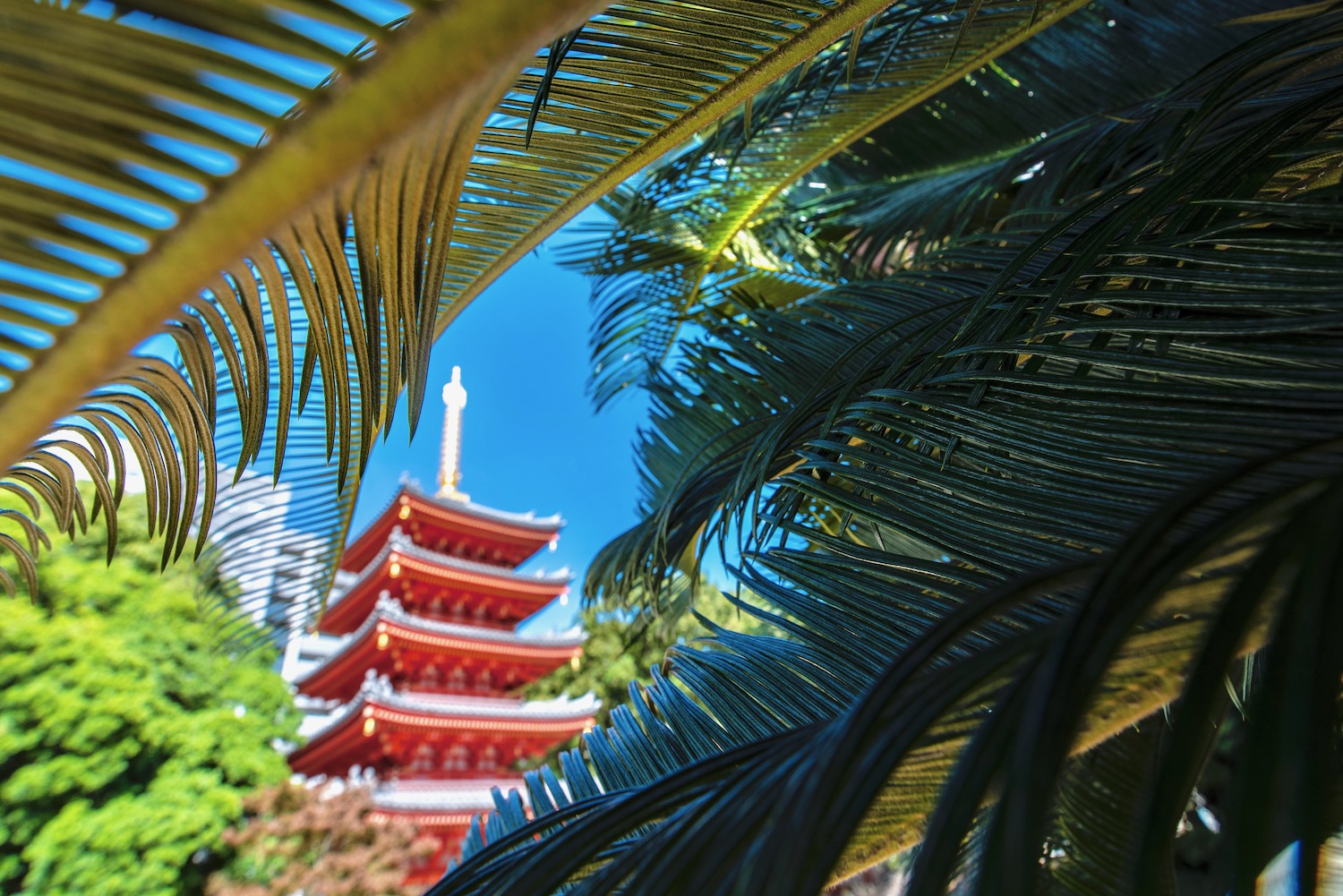
Kyushu Starts Here
I’ve had a Kyushu travel guide on this site for a long time—but I haven’t really been satisfied with it, if I’m perfectly honest. Some parts of it were downright superficial, and reflected the fact that I’ve been discovering the island piecemeal over the past several years, rather than having done a deep dive.
This changed recently, of course: In November 2019, I embarked upon a truly extensive Kyushu trip, which saw me visit each of the island’s prefectures. Some destinations were completely new to me, while I simply hadn’t seen others in a while. In both cases, the impact upon my understanding of Kyushu was extraordinary. And I’ve since been back many times.
Some of you have arrived on this page directly from a search engine, while others might have stumbled upon one of my stream-of-consciousness style Kyushu travel blog posts and come in that way. In either case, I’m delighted you’re here—and within a few paragraphs, I’m pretty sure you will be, too.
Practical Matters
When to visit kyushu.
Notice all the perfectly blue skies in this pictures throughout this Kyushu guide ? These are largely due to the fact that I traveled to Kyushu most recently during the month of November which, along with May, is one of my favorite months to visit Japan in general. While it’s true that you’ll need to come during the latter part of the month if you wanted to Kyushu’s autumn colors (or in late March if you want to see the sakura ), these two “shoulder” months (which are also, importantly, typhoon-free) are the best time to visit Kyushu, as far as I’m concerned.
Where to Stay in Kyushu
In general, the best hotels in Kyushu are slightly inferior to the ones you find in major destinations on Honshu, though they’re not as mediocre (in my opinion) as places to stay in Hokkaido and Shikoku. City hotels like Tokyu Stay Hakata and Hotel Forza Nagasaki , for example, are more or less up to Tokyo standards. On the other hand, I do find accommodations in secondary destinations to be lacking, be it guest houses at the foot of Mt. Aso, or all but a few onsen-ryokan properties in Beppu (such as the sea-facing Shiosai no Yado ) are disappointing.
How to Get Around in Kyushu
I’ll be referencing various modes of transport throughout this Kyushu travel guide, but in general I’d say you should expect a mix. The Shinkansen , for example, only runs between Fukuoka (Hakata), Kumamoto and Kagoshima, which means that for travel to cities like Nagasaki, Beppu and Miyzaki, you’ll need to avail ordinary express trains; some destinations (such as Mt. Aso) are currently only accessible by bus, on account of the 2016 earthquake. Additionally, although I generally have very mixed feelings about renting a car in Japan , in many cases this is the best way to explore secondary Kyushu destinations.
Money, Costs and Communication
Your Kyushu visit is unlikely to differ much from traveling elsewhere in Japan when it comes to money or costs: Most travelers will spend around ¥10,000-25,000 per day (this is about $90-230, as of publication time), and a surprising amount of that will be in cash, due to Japan’s resistance to cashless payments as compared to other countries. Kyushu has rapidly improved its Wi-Fi infrastructure alongside the rest of Japan; unlimited data SIMs are available for purchase at Fukuoka Airport, assuming you aren’t arriving at Haneda or Narita and picking one up there . Speaking Japanese helps when travel in Kyushu, but isn’t necessary.
Kyushu vs. Shikoku
The good news? I’ve written a post that compares and contrasts Shikoku vs. Kyushu (which, I’m happy to say, does not trash talk either of these islands, both amazing in their own ways). The better news: I’ll summarize its conclusion for you here. Simply put, Kyushu and Shikoku offer similar experiences (interesting medium-to-large sized cities and unique, easy-to-access natural experiences), with Kyushu being larger (and therefore having more potential choices for travelers) and Shikoku being smaller and having significantly fewer tourists.
Where to Go in Kyushu
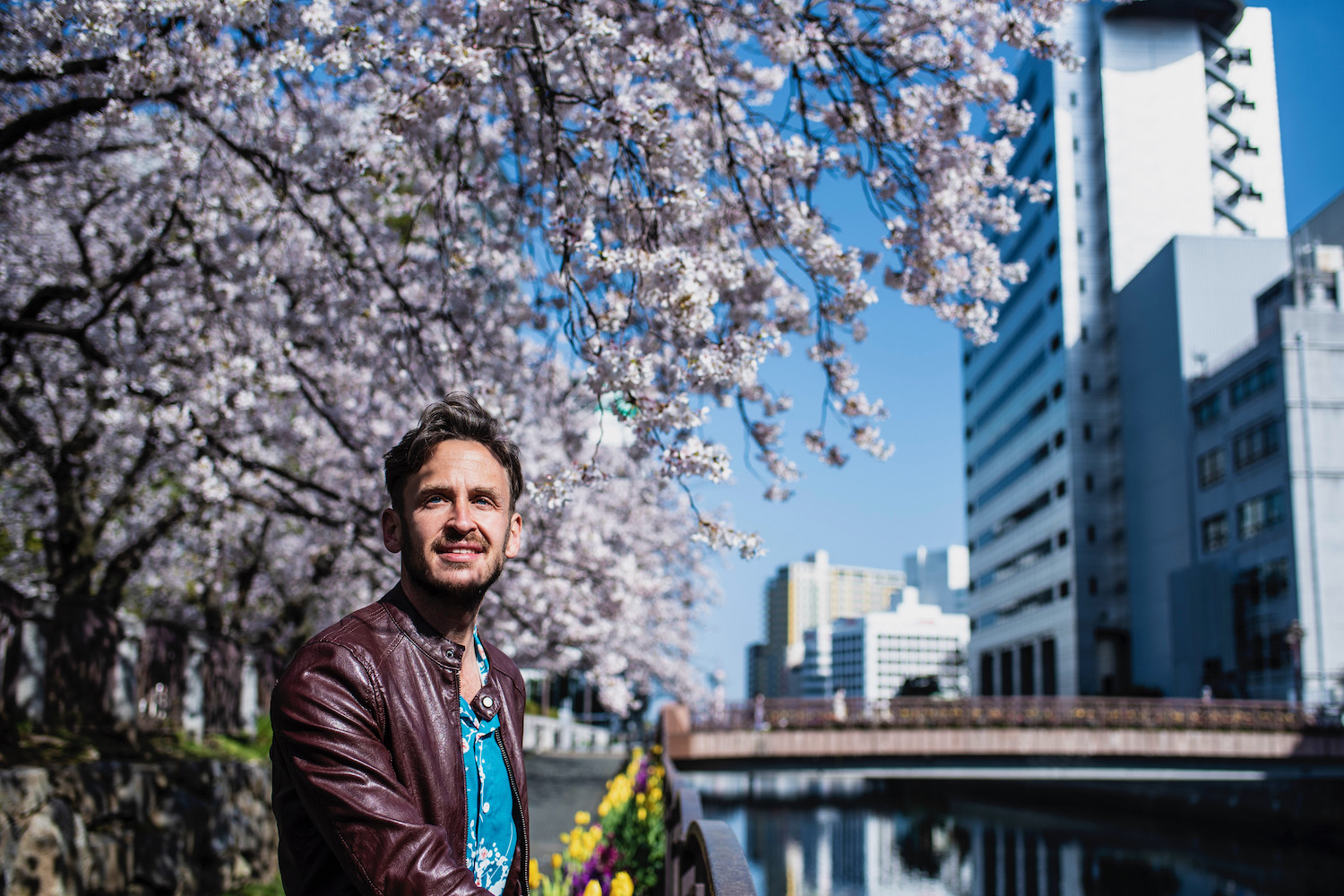
Most Kyushu travel starts in Fukuoka , especially if this is where you’re arriving in Japan. I love this city more every time I visit it, from the temples and shrines of the historical Gion district just west of Hakata Station , to the panoramic views of the city from Atago-jinja shrine, which rises above the coast, to the famous Fukuoka Yatai food stalls. I also enjoy taking day trips from Fukouka, be they ones more or less in the city like Nanzo-in ‘s reclining Buddha or the famous Dazaifu Tenman-gu shrine, or Karatsu , a castle town about 90 minutes to the west (which is technically located in Saga prefecture, but whatever).
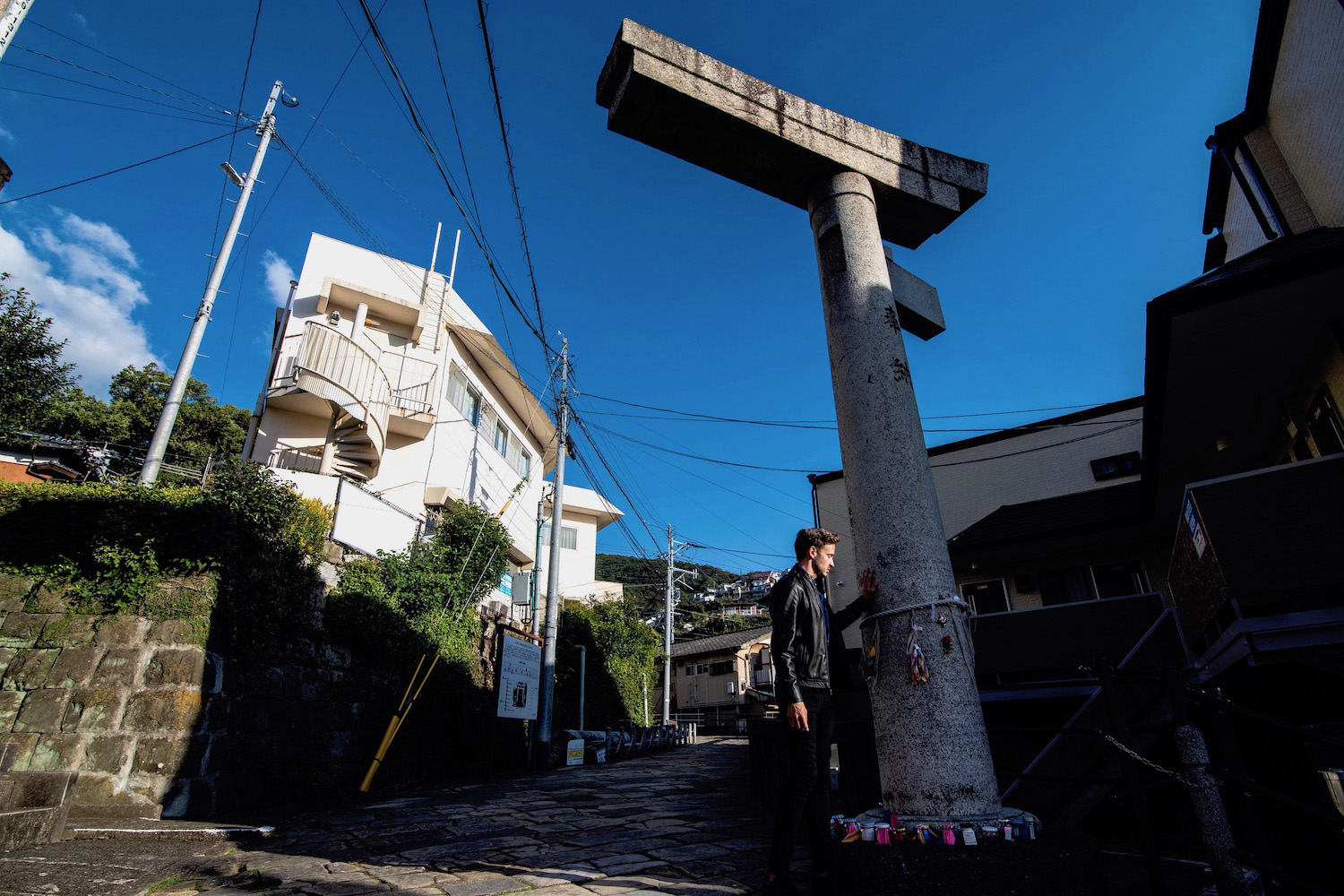
Nagasaki is one of the best places to visit in Kyushu—and not just because of World War II-era tourism sites, even if I find the area around Nagasaki Ground Zero to be very moving indeed. From the picturesque Oura Cathedral and Glover Garden in the southern part of the city, to the stunning panorama Mt. Inasa offers, Nagasaki is one of the most beautiful and eclectic cities in all of Japan—and not just Kyushu. Nagasaki also offers the opportunity to take several fascinating day trips, including to gorgeous Yutoku Inari Shrine and historical Yoshinogari Park , which re-creates like if the Yayoi era of ancient Japan.
Kumamoto and Mt. Aso
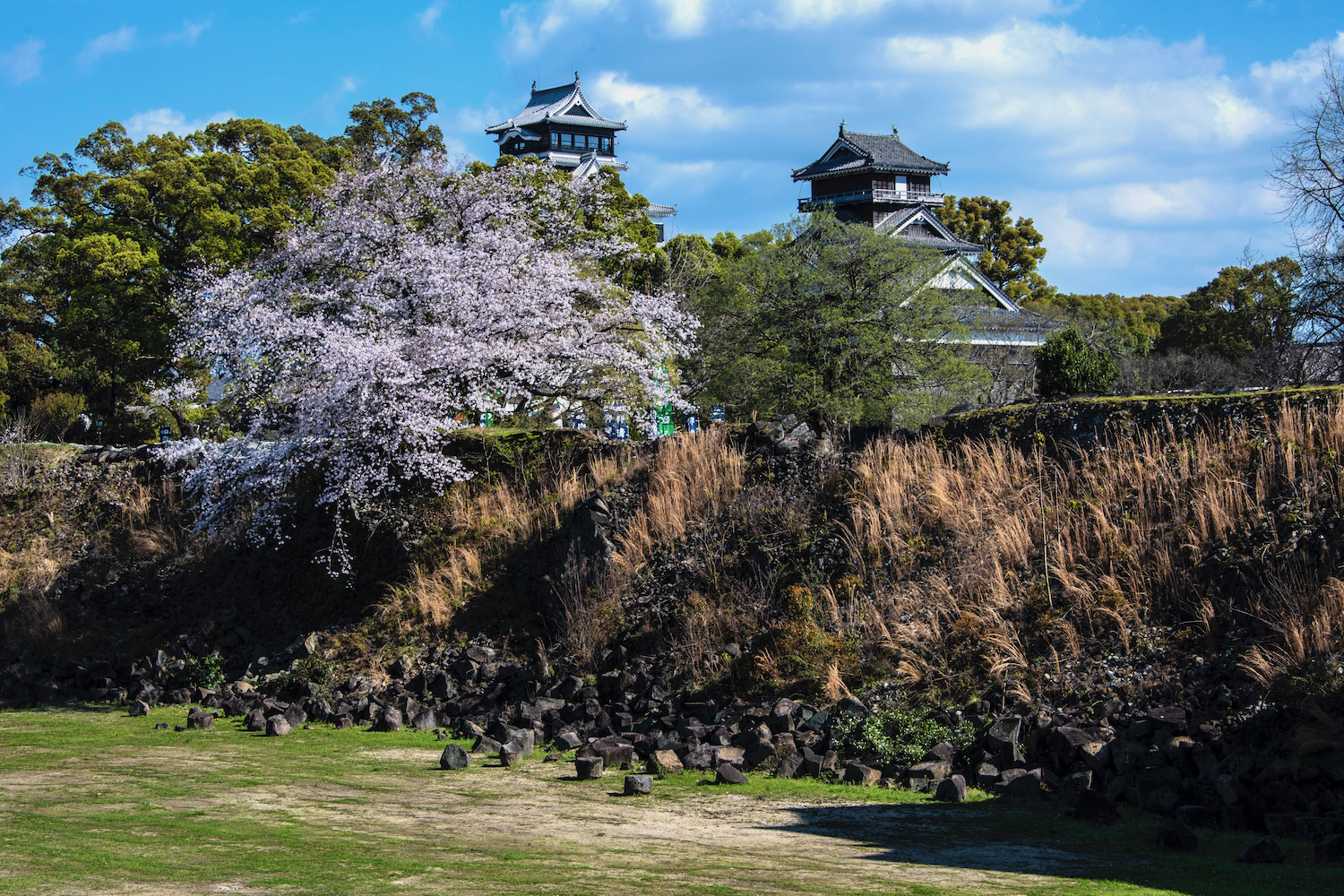
I’ll be honest: Before my latest trip, Kumamoto was not one of my favorite Kyushu destinations. I need to tell another truth, however, which is that I didn’t explore the city at the depth it deserves. While it’s difficult to deny the fact that Kumamoto Castle ‘s lingering damage is disappointing, I’d be remiss if I didn’t point out how amazing other destinations in the city are, from lush Suizenji Park to Honmyo-ji , a temple above which a towering park offers a stunning view of the city. Kumamoto is also the nearest major city to Mt. Aso , which is amazing either as a day trip to Mt. Aso from Kumamoto , an overnight excursion.
Oita and Beppu Onsen
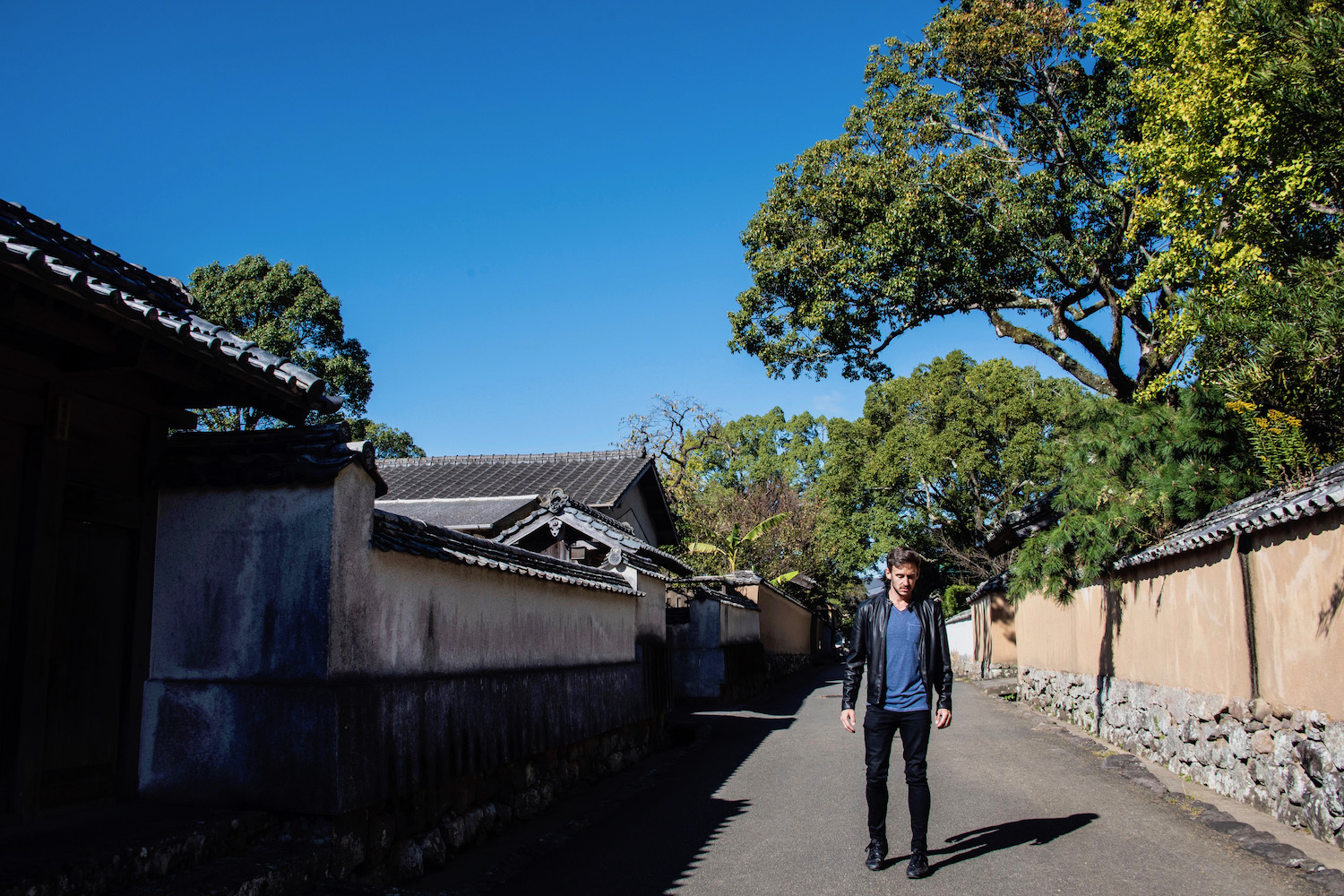
In the previous incarnation of my Kyushu travel guide, I focused largely on the Beppu Onsen hot springs you can actually swim in. During my latest trip, however, I got a chance to explore the Seven Hells of Beppu , with my favorites being Chinoike Jigoku (the “blood” hell) and Umi Jigoku (the “sea” hell). Another awesome part of my latest trip to Oita prefecture was renting a car and driving northward to the Kunisaki Peninsula , where destinations like the castle town of Kitsuki , Futago-ji temple deep in the forest and the vibrant Usa Jingu shrine surprised and delighted me.
Miyazaki and Takachiho Gorge
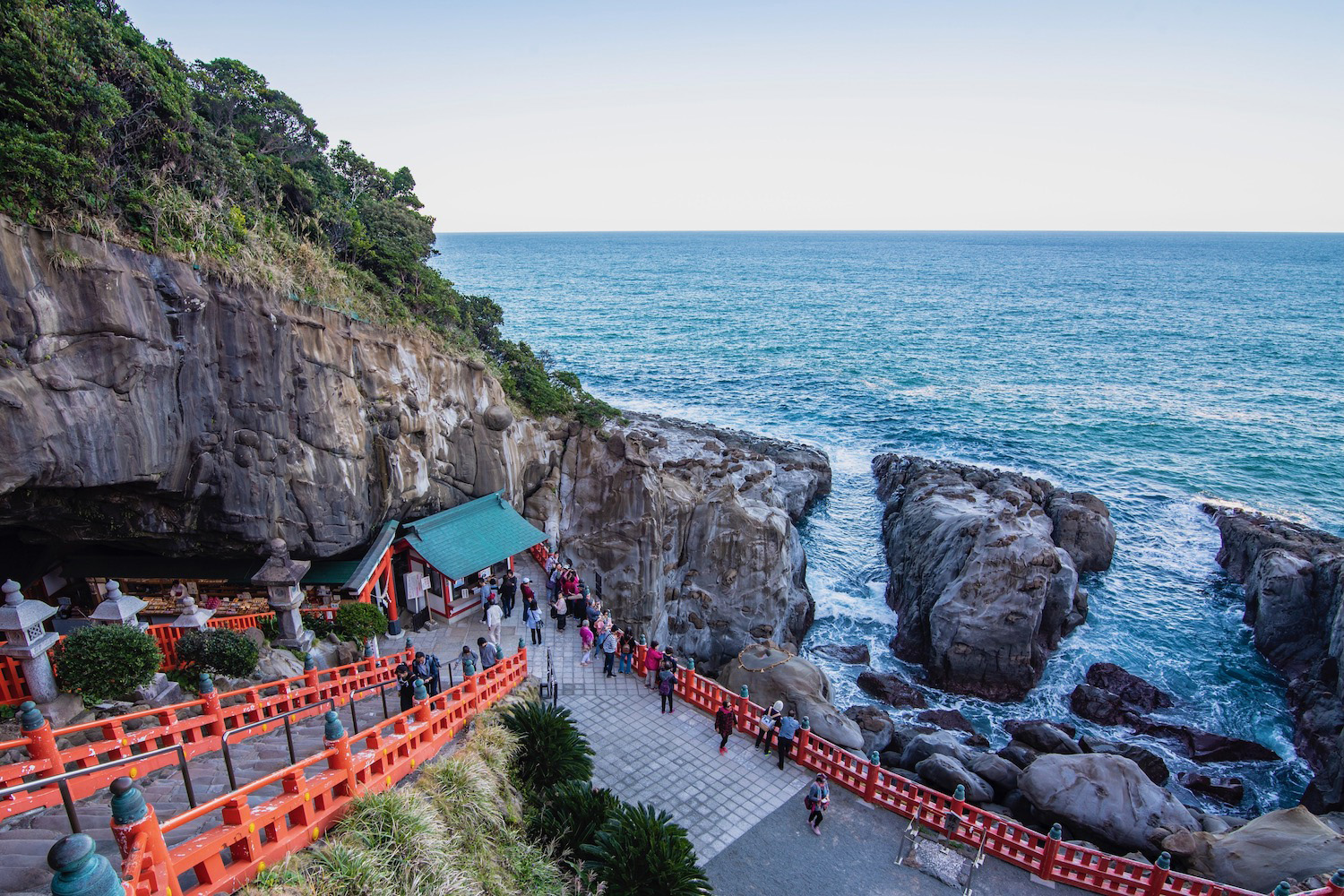
If you can time it right, the Takachiho Gorge in Miyazaki prefecture (which is not located particularly close to Miyazaki City , I should warn you— this day trip to Takachiho from Kumamoto illustrates that) is a great place to see Kyushu autumn colors. Even if you can’t, of course, this underrated part of southeastern Kyushu is very much worth a visit, if only because of Udo Shrine . Dedicated to Japan’s first emperor Jimmu, who launched his first military expedition from nearby Hyuga , it’s one of the best-kept secrets in all of Japan, not to mention one of the most gorgeous spots you can visit.
Kagoshima and the Satsuma Peninsula
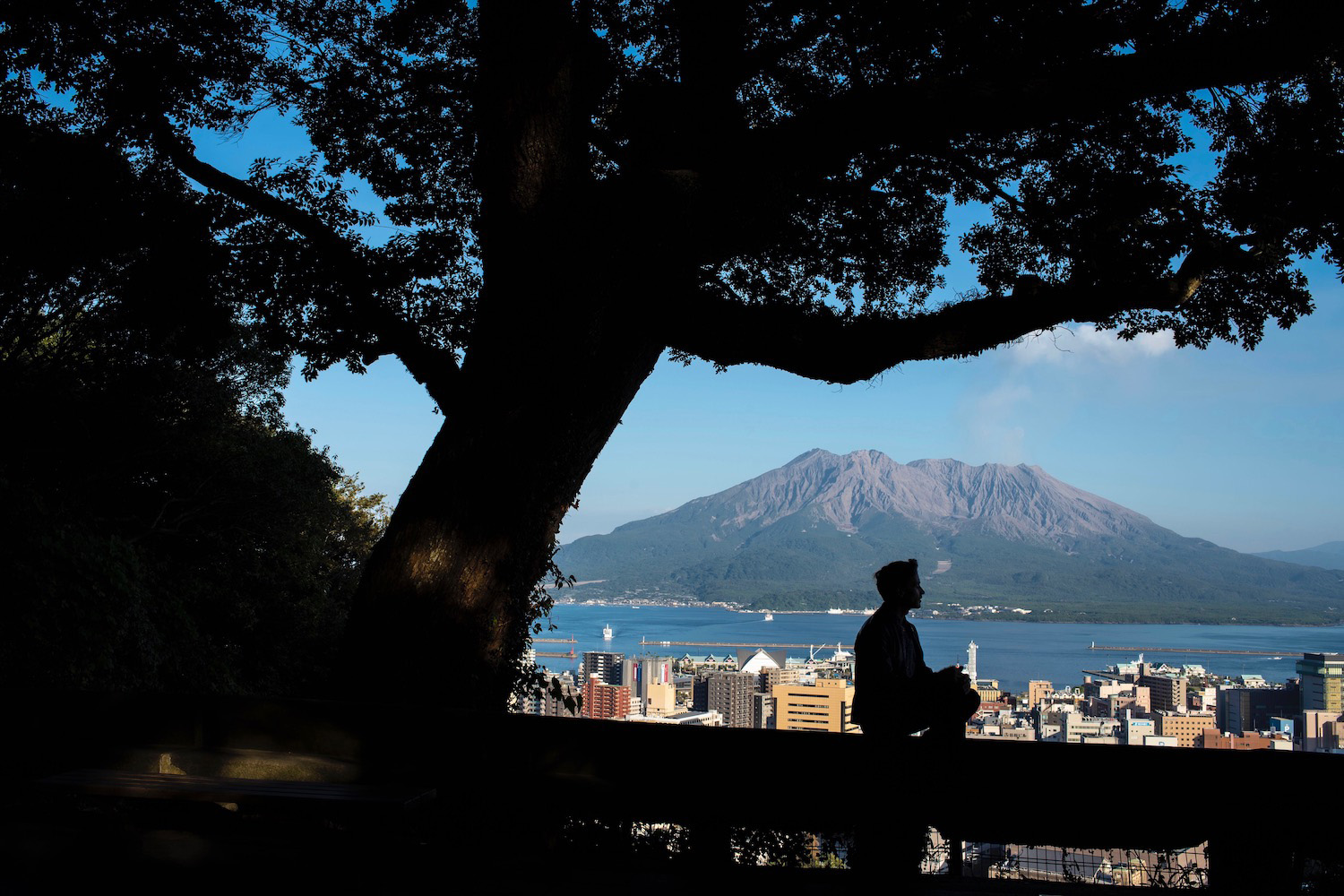
I didn’t intend to take a Kyushu road trip when I planned my November travel, but I ended up renting five separate cars. One of my favorite reasons for doing this was my day trip to the Satsuma Peninsula from Kagoshima . Spots like Chiran Samurai Village , the matcha fields of Ei , Cape Nagasakibana and the “sand bath” of Ibusuki provided the perfect foil to attractions within the city, from Sengan-en garden, to Sakurajima volcano, to Kagoshima’s answer to Fukuoka’s Yatai .
Yakushima Island
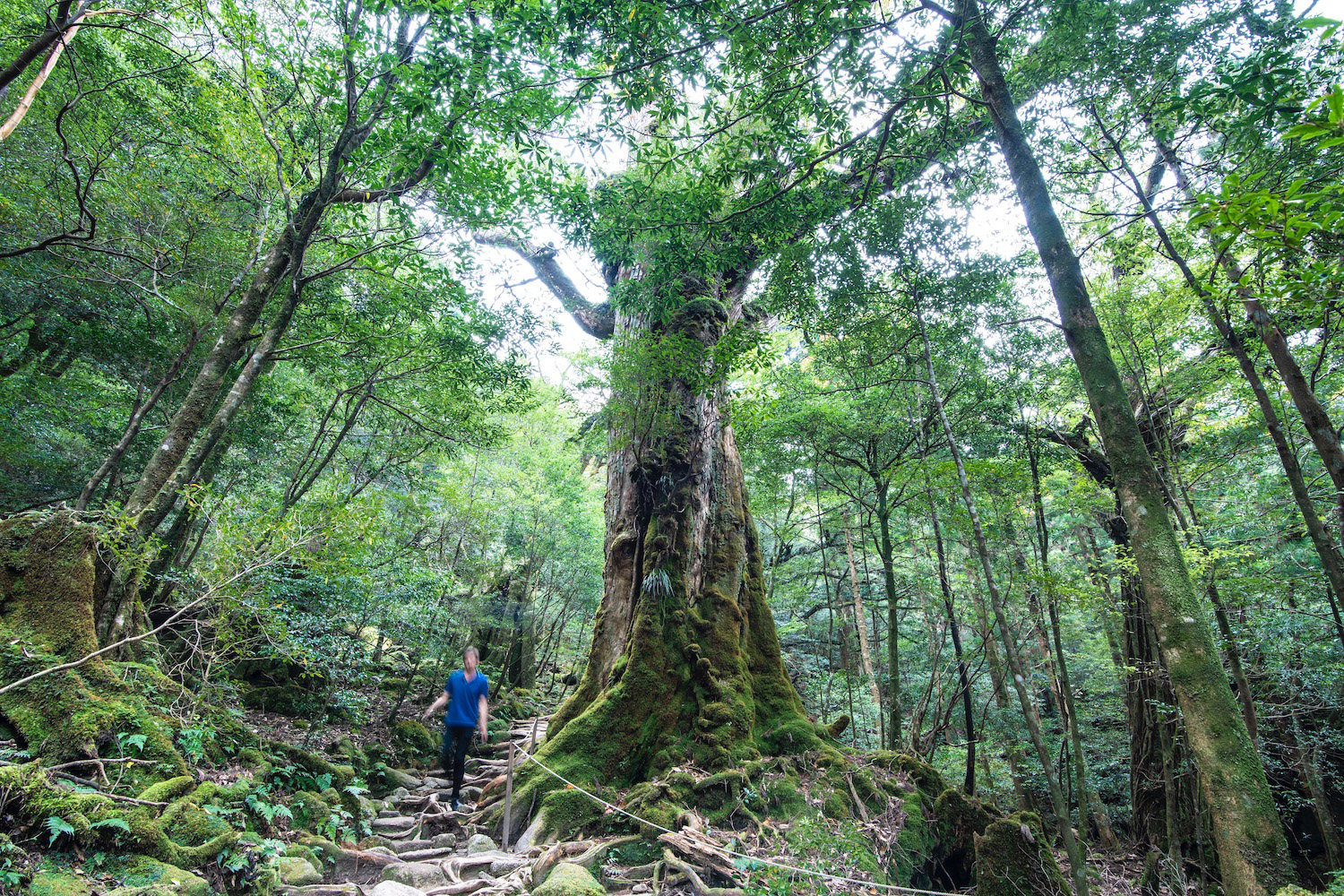
I’ve visited Yakushima during two bouts of my Kyushu travel: On my very first trip to Japan back in early 2014; and during my Kyushu deep dive in late 2019. The good news? The island remains enchanting forever, whether hiking in its interior amid the moss-covered forest at Shiratani Unsuikyo that inspired the anime classic Princess Mononoke , or bathing (or, at least, attempting to bathe) in natural onsen hot springs right at the sea. One thing that definitely made my second trip easier was renting a car, which I’d recommend you do if you have it in your budget.
How Long Should You Spend in Kyushu?
Regardless of why you decide to travel Kyushu or where you plan to go during your trip, I would generally say you should aim to spend as long in Kyushu as possible—things (and trains!) move slower here than they do in Honshu, which means you can’t fit quite as much into such a short amount of time as you might do elsewhere in Japan. In general, I’d say that one week in Kyushu or 2 weeks in Kyushu is a “Goldilocks” length of trip, which will afford you the opportunities to blend city experiences, natural adventures and maybe even a couple of wild cards.
Another factor affecting how many days in Kyushu, of course, is what your larger trip to Japan will look like. If, for example, you take a dedicated Kyushu trip like I recently did, you can afford to spend longer here. On the other hand, if Kyushu is one component of a more comprehensive Japan trip (I’m thinking two weeks in Japan , or perhaps even one month in Japan ), then a few days or a week is likely the longest amount of time you’ll be able to spend in Kyushu.
Is Kyushu Worth Visiting?
This one is easy, though there is some nuance I’ll speak too. On one hand, I would not have written a Kyushu travel guide (and traveled to the island so many times, including on my recent deep dive) if I didn’t feel Kyushu was worth visiting. On the other hand, there are a lot of misconceptions about this island, and one overarching truth: Most people simply don’t know a thing about Kyushu, apart from the existence of cities like Fukuoka and Nagasaki and maybe, the fake spa-musement park in Beppu .
Obviously, my hope is that if you’ve read my guide this far, you’ll be so excited about things to do in Kyushu at this point that literally nothing will be able to keep you off the island. Absent this, I’m not sure what I can say to convince you, other than to re-affirm my love for this island, and the fact that every time I’ve traveled here (I’m at three or four trips now, if I’m not mistaken) I crave a future opportunity to delve even deeper into it.
Other FAQ About Travel to Kyushu
When should i go to kyushu.
I love to go to Kyushu (which is already less crowded than hot spots like Tokyo or Kyoto, even in busy times) during the “shoulder” months like May and October. The good news is that no matter when you travel, much of the advice I present in this Kyushu travel blog will be relevant.
What is famous in Kyushu?
Kyushu is famous for the ramen of Hakata in Fukuoka, the atomic-bomb related sites in Nagasaki, Kumamoto Castle and the onsen hot springs of Beppu. To start with, anyway—as you’ve seen throughout this Kyushu travel guide, Kyushu is a land of treasures.
What is the climate of Kyushu?
Kyushu’s climate is defined by a mild, sunny winter, a hot and very rainy summer, and a spring and summer season that can go either way. Regardless of when you visit, you’ll want to make sure you curate things to do in Kyushu you can enjoy irrespective of the weather.
The Bottom Line
The extent to which you enjoy your Kyushu travel correlates directly with how deeply you can explore the island, although this isn’t necessarily tied to specific length of time. Ideally, you’ll be able to travel for at least a week in Kyushu, pairing urban experiences in large cities like Fukuoka, Nagasaki, Kumamoto and Kagoshima with nature (Mt. Aso or Yakushima island), culture (hot springs in Beppu or the Udo Shrine in Miyazaki) or something else entirely. Need personalized help planning your Kyushu adventure? Commission a custom Japan itinerary today!
Plan Your Japan Trip

Subscribe to email updates!
Words, images and design ©2018-2024 Robert Schrader, All rights reserved. Read Privacy Policy or view sitemap .
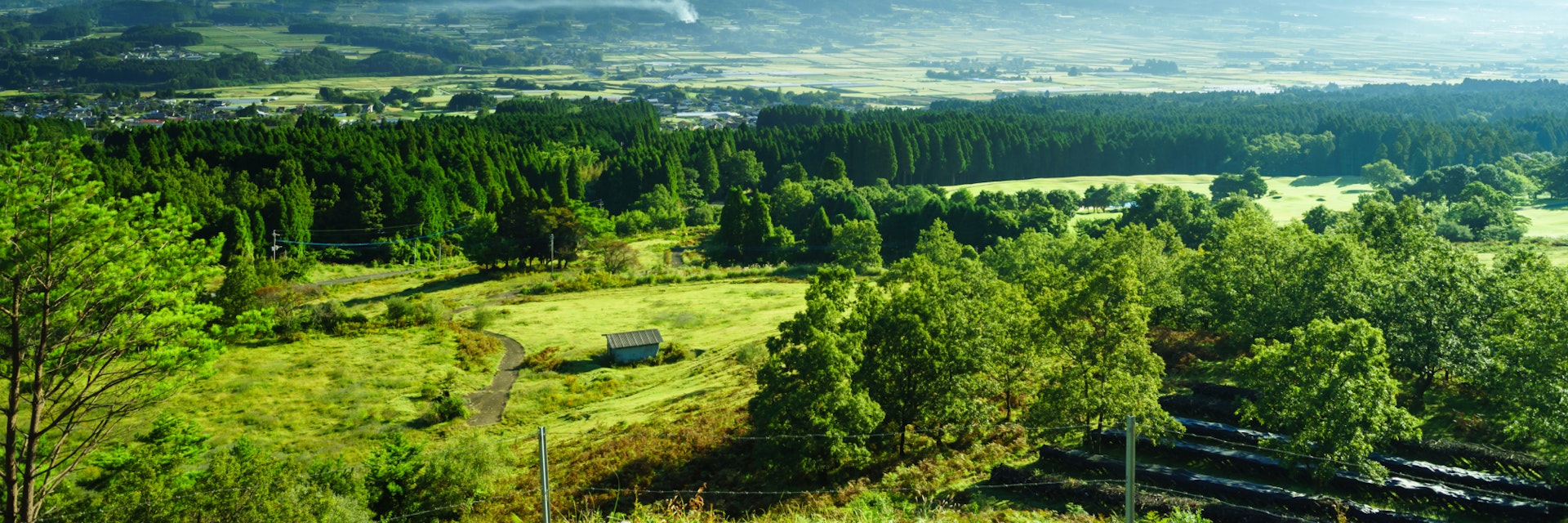
Shutterstock / naru7
Kyūshū (九州), Japan's southern- and westernmost main island, is arguably its warmest and most beautiful, with active volcanic peaks, rocky, lush and near-tropical coastlines, and great onsen (hot springs) virtually everywhere. History and legend were made here: Jōmon ruins, Shintō's sun goddess, wealthy trading ports, cloistered foreigners, samurai rebels and one of the earth's greatest wartime tragedies all loom large.
Leave the planning to a local expert
Experience the real Kyūshū. Let a local expert handle the planning for you.
Attractions
Must-see attractions.
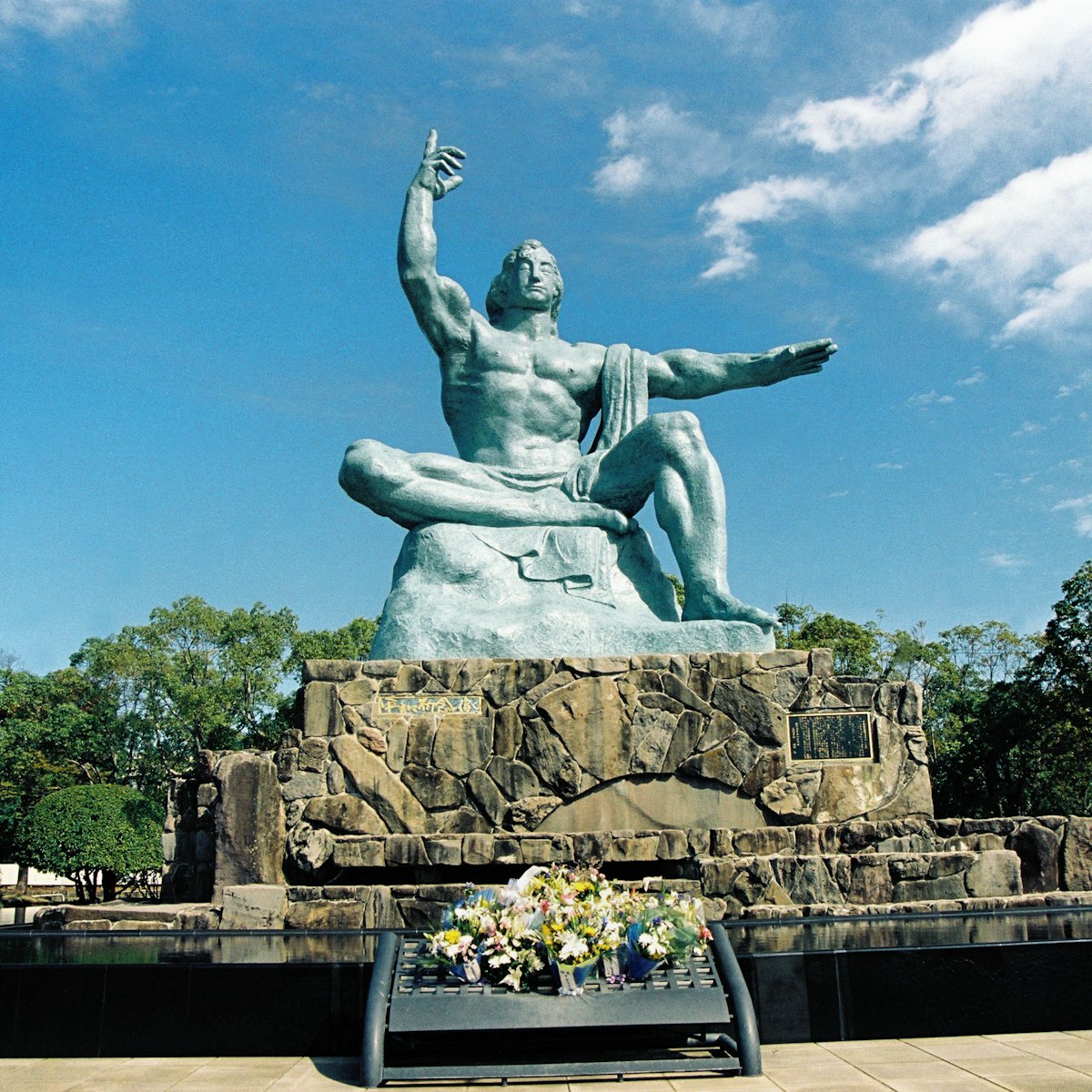
A still, serene and deeply moving place, Nagasaki's Peace Park commemorates the atomic bombing of the city on August 9, 1945, which reduced the…

Nagasaki Atomic Bomb Museum
On 9 August 1945, the world's second nuclear weapon detonated over Nagasaki, and this sombre place recounts the city's destruction and loss of life…
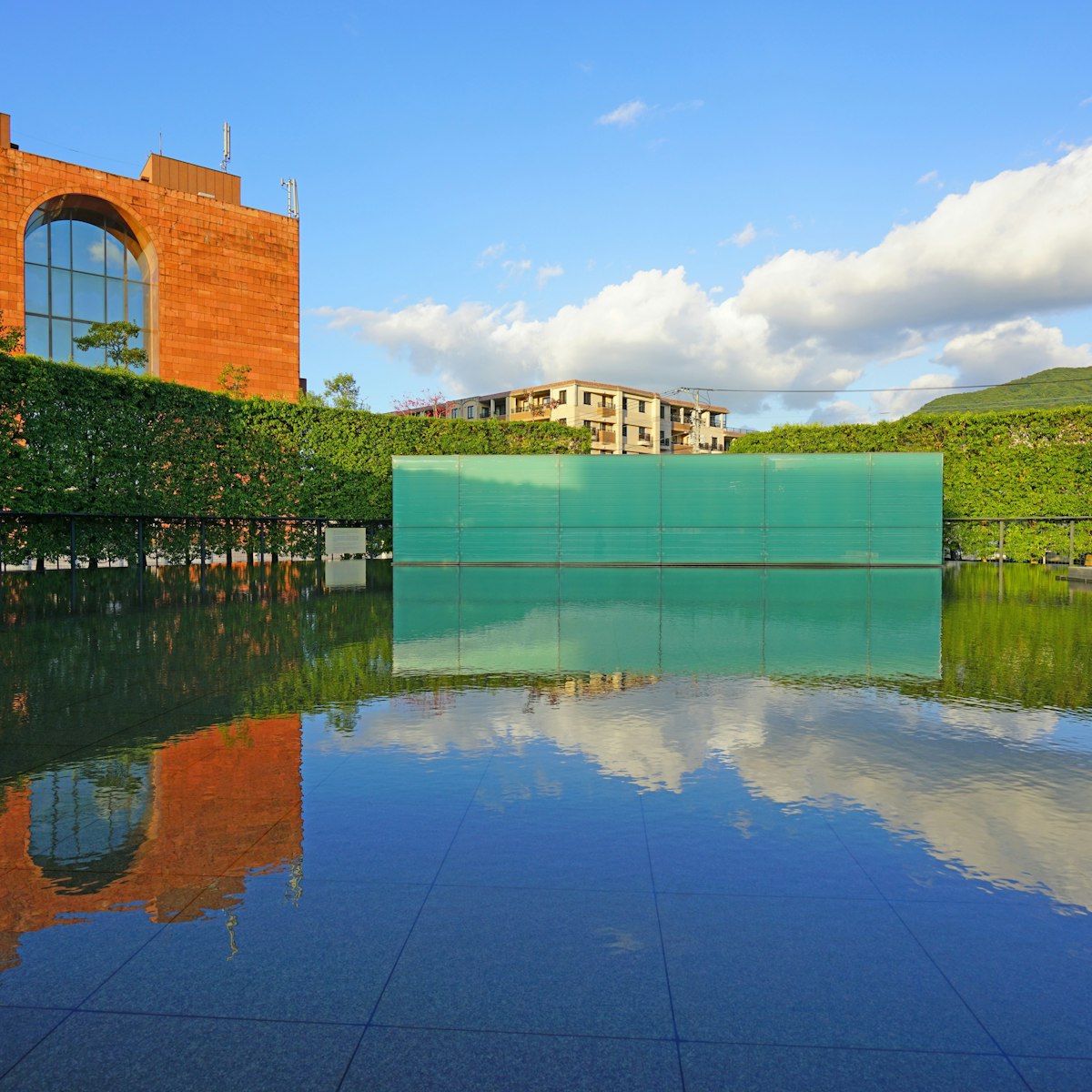
Nagasaki National Peace Memorial Hall for the Atomic Bomb Victims
Adjacent to the Atomic Bomb Museum and completed in 2003, this minimalist memorial by Kuryū Akira is a profoundly moving place. It's best approached by…
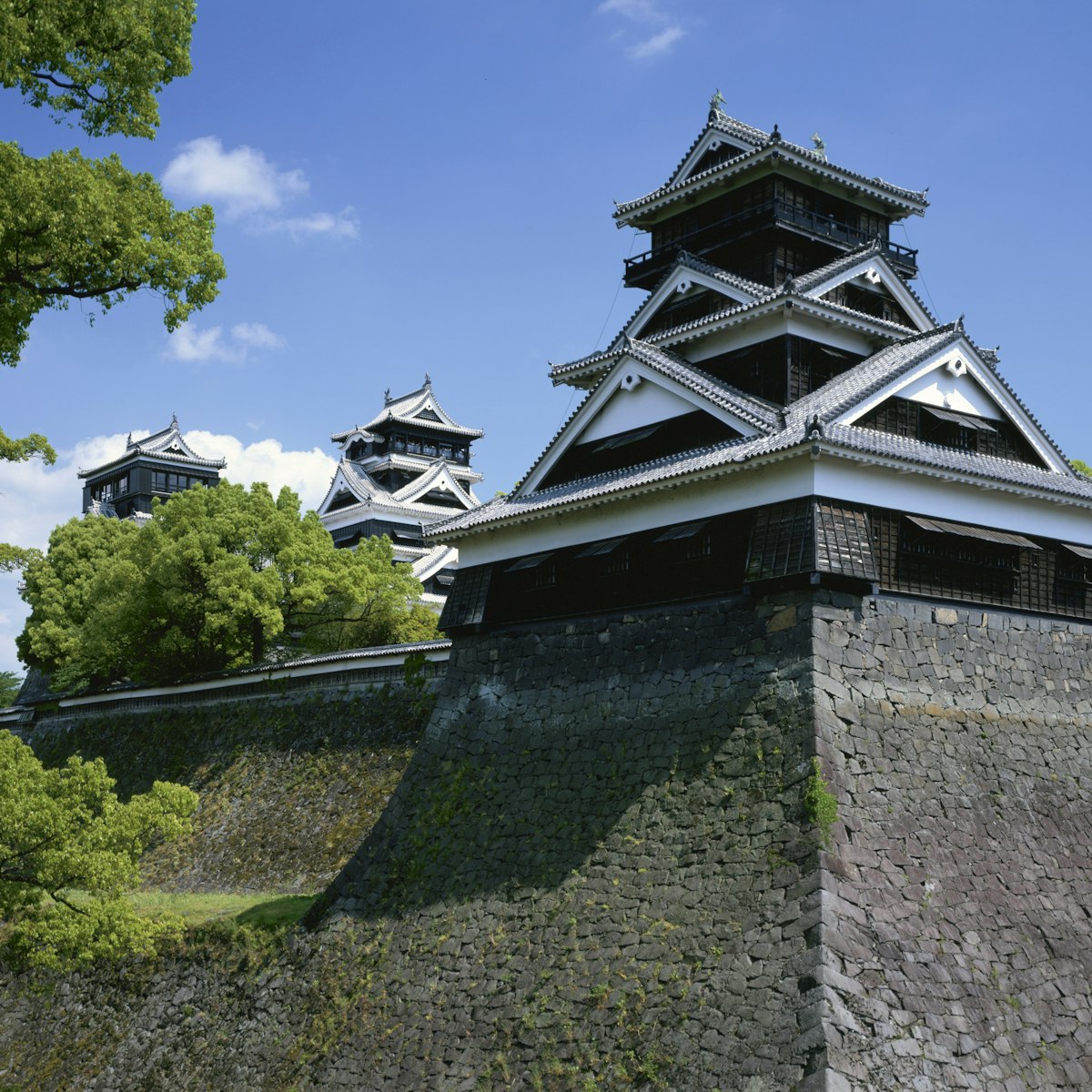
Kumamoto-jō
Dominating the skyline, Kumamoto's robust castle is one of Japan's best, built in 1601–07 by daimyō Katō Kiyomasa, whose likeness is inescapable around…
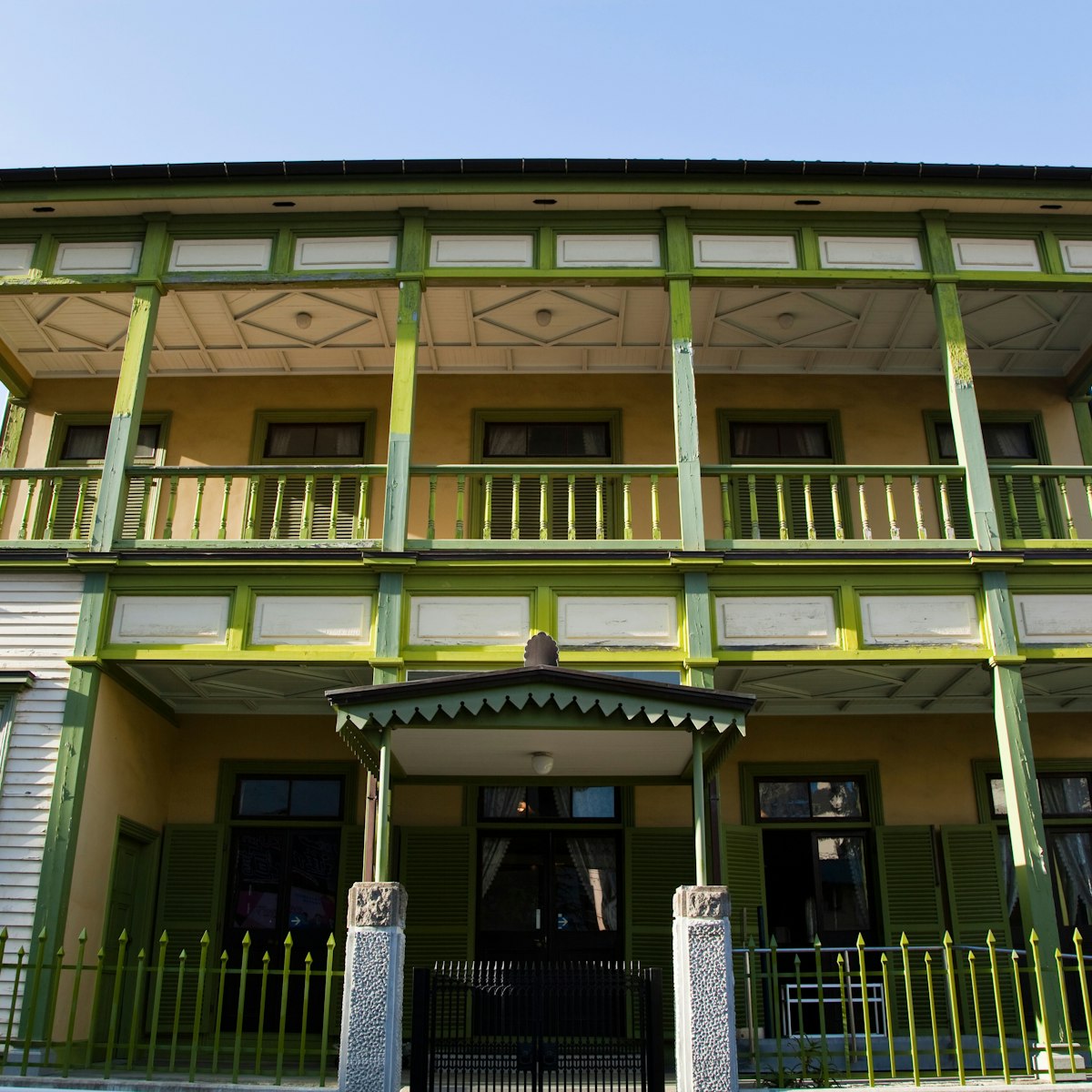
In 1641 the Tokugawa shogunate banished all foreigners from Japan, with one exception: Dejima, a fan-shaped, artificial island in Nagasaki harbour. From…
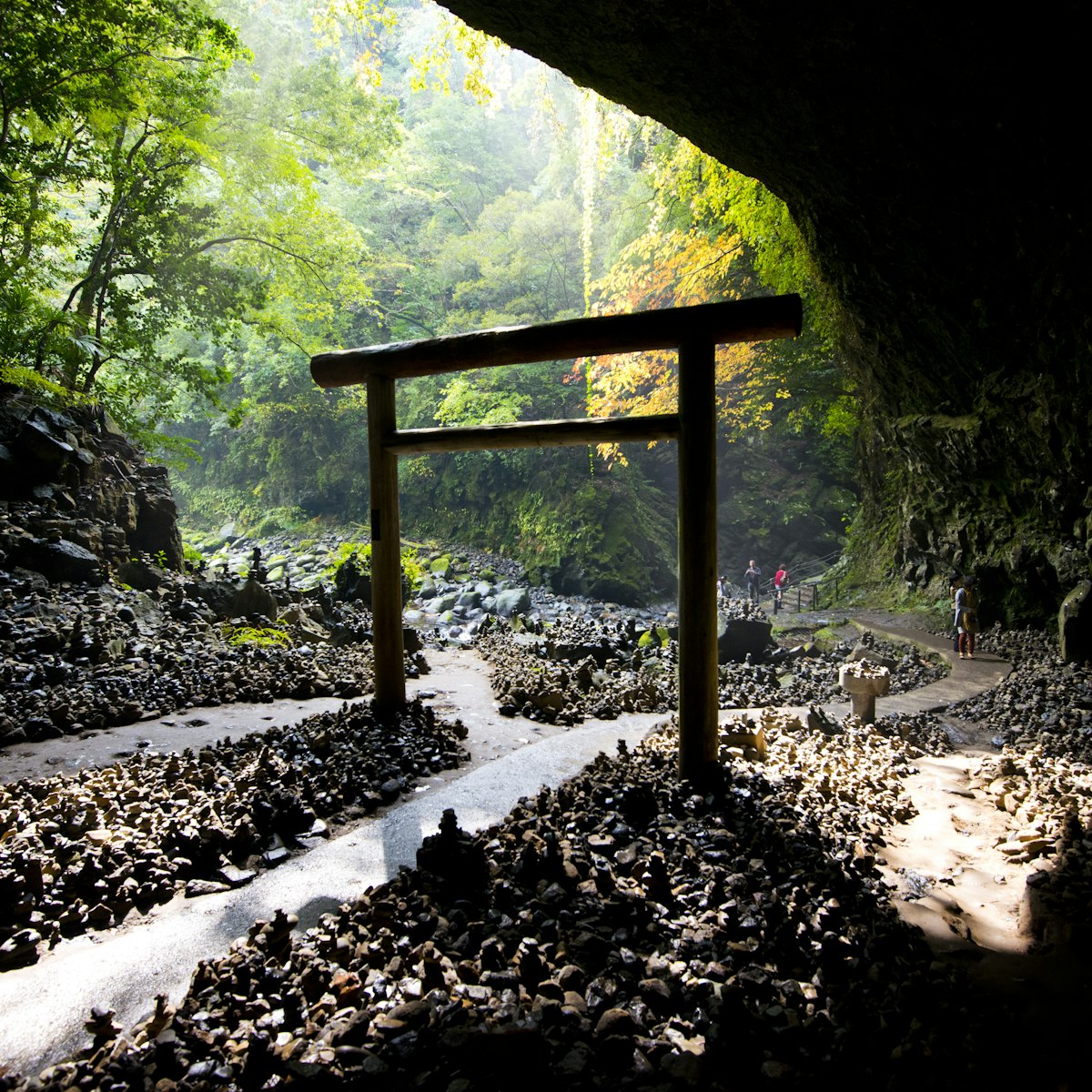
Ama-no-Iwato-jinja
One of Shintō's loveliest shrines honours the cave where the goddess Amaterasu hid. The cave itself is off-limits, but Nishi Hongū (the shrine's main…
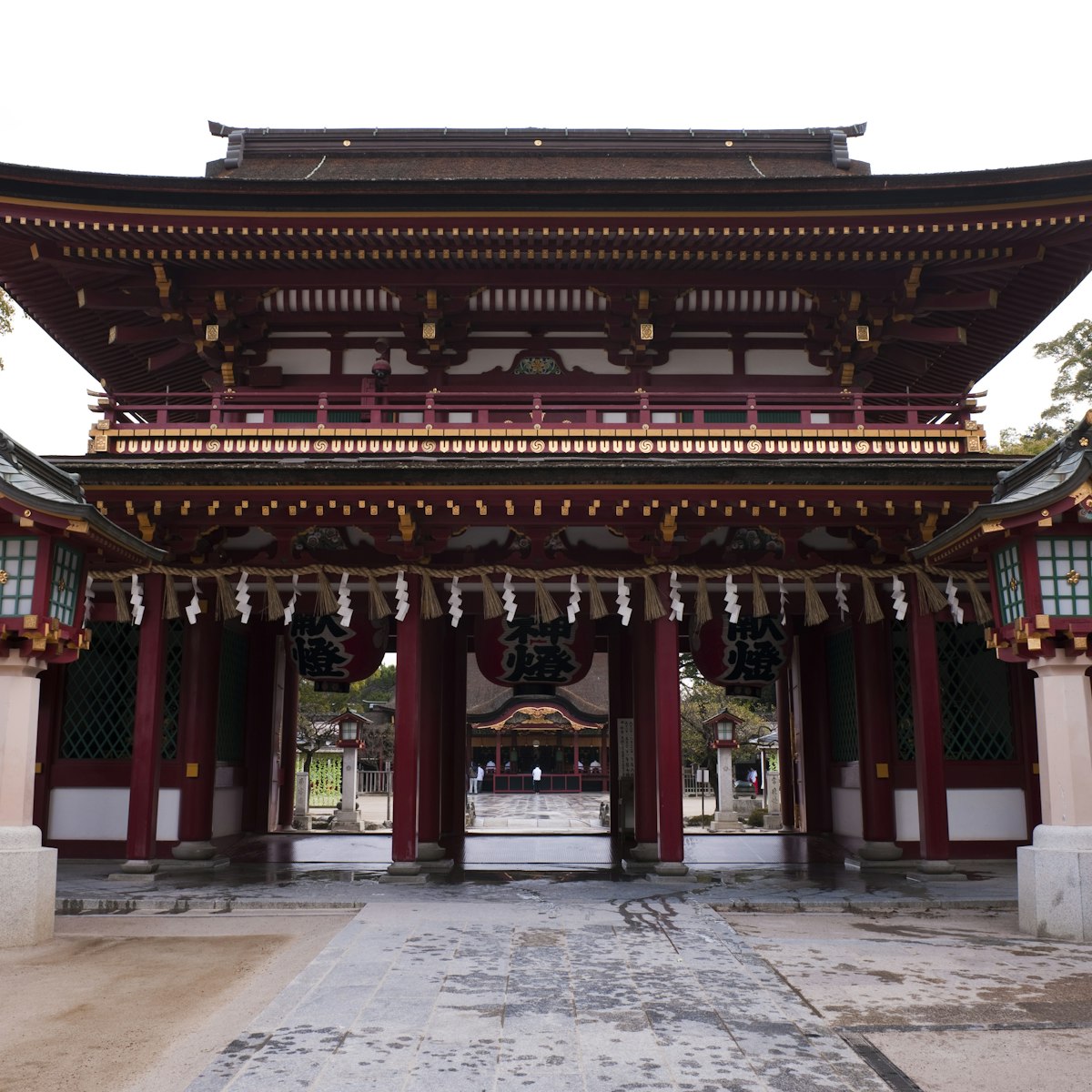
Dazaifu Tenman-gū
Among the countless visitors to the grand, sprawling Tenman-gū – shrine and burial place of poet-scholar Tenman Tenjin – are students making offerings and…

In 1658, the 19th Shimazu lord laid out his pleasure garden on this hilly, rambling bayside property of groves, hillside trails and one of Japan's most…
Plan with a local
Experience the real Japan
Let a local expert craft your dream trip.

Latest stories from Kyūshū
Filter by interest:
- All Interests
- Adventure Travel
- Art & Culture
- Beaches, Coasts & Islands
- Food & Drink
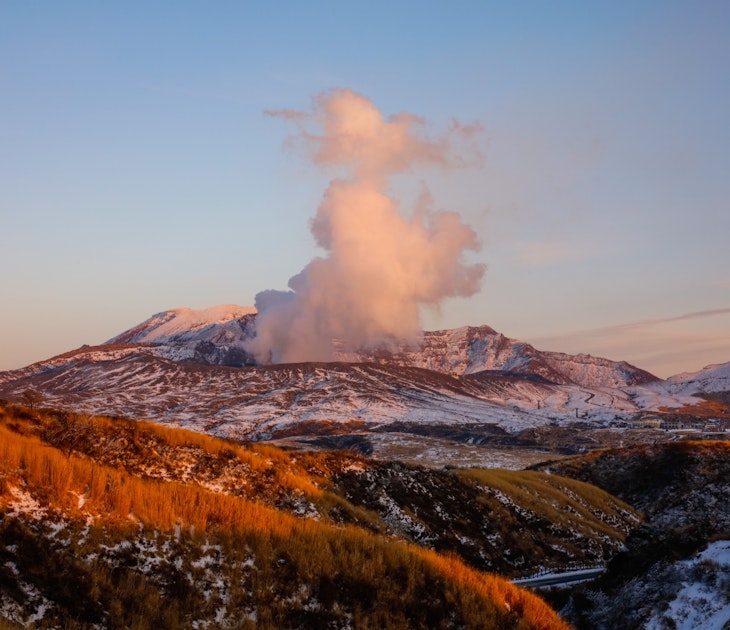
Dec 21, 2021 • 6 min read
Mt. Aso is the perfect place to appreciate the impact of fire and water – the elemental forces that continue to shape life in Japan
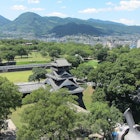
Mar 30, 2021 • 7 min read
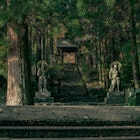
Mar 30, 2021 • 11 min read
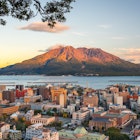
Mar 29, 2021 • 5 min read
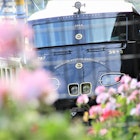
Nov 27, 2020 • 2 min read
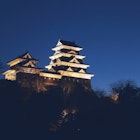
Jan 31, 2020 • 2 min read
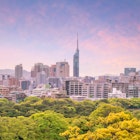
Oct 15, 2019 • 5 min read
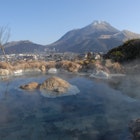
Aug 26, 2019 • 5 min read
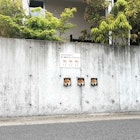
Jun 20, 2018 • 1 min read
Purchase our award-winning guidebooks
Get to the heart of Kyūshū with one of our in-depth, award-winning guidebooks, covering maps, itineraries, and expert guidance.
Kyūshū and beyond
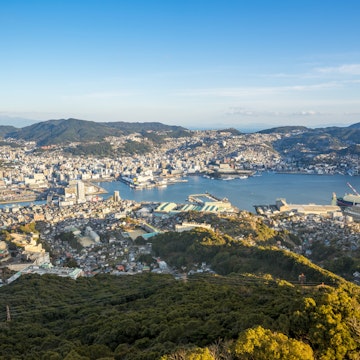
Best of Kyushu
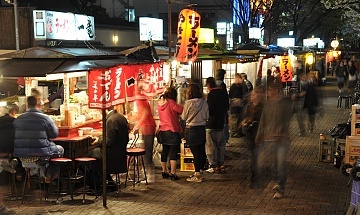
Day 1 - Fukuoka
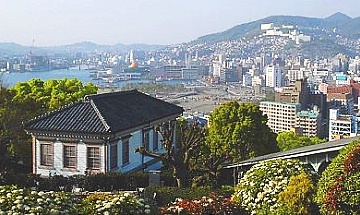
Day 2 - Fukuoka to Nagasaki
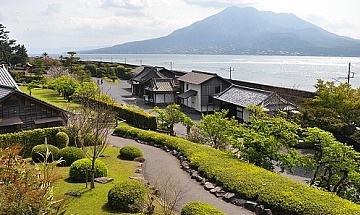
Day 3 - Nagasaki to Kagoshima
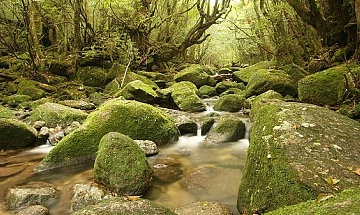
Day 4 - Kagoshima to Yakushima
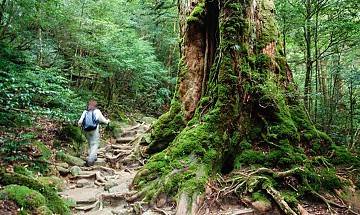
Day 5 and 6 - Yakushima
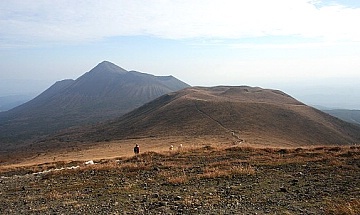
Day 7 - Kagoshima to Kirishima
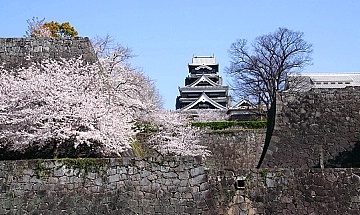
Day 8 - Kirishima to Kumamoto
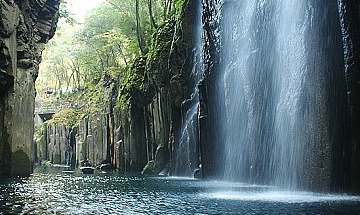
Day 9 - Kumamoto to Takachiho
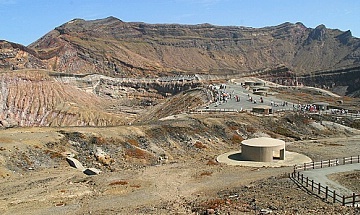
Day 10 - Takachiho to Kurokawa via Aso
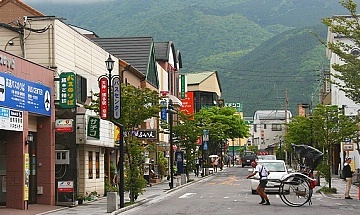
Day 11 - Yufuin via Mount Kuju
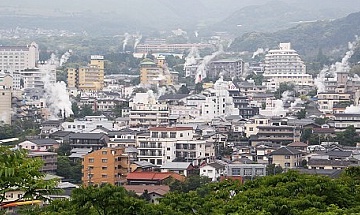
Day 12 and 13 - Beppu
The above itinerary is somewhat fast-paced. Tourists preferring a slow pace of travel should consider spending more time at some of the destinations along the way.
Questions? Ask in our forum .


30 Awesome Things To Do In Kyushu, Japan: The Ultimate Guide
Jackson Groves
Posted on Last updated: June 24, 2023
Categories JAPAN
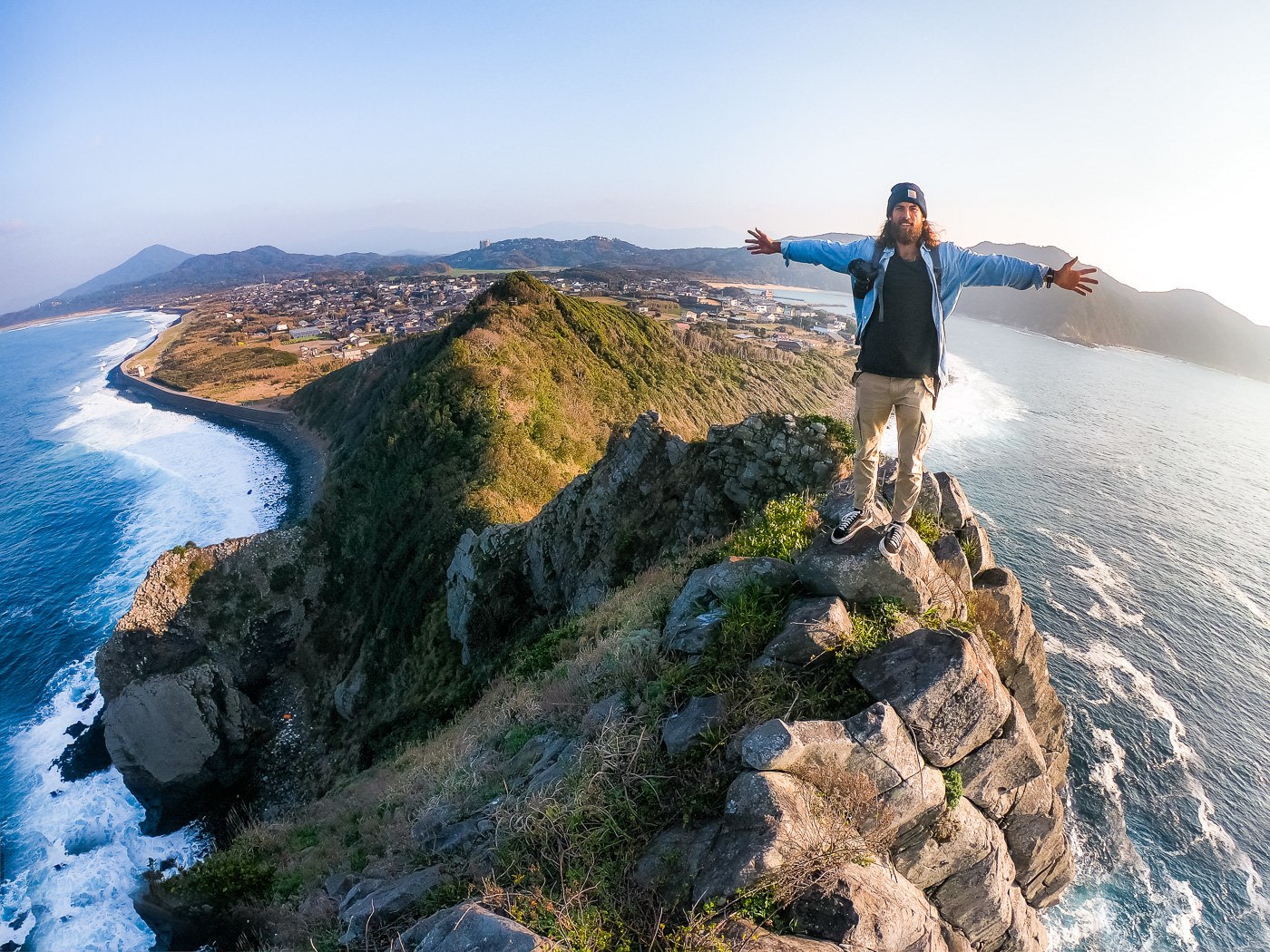
Kyushu is a volcanic island in the south of Japan with some pretty epic coastlines, incredible waterfalls, and several towns that are renowned for their volcanic hot spring activity. Kyushu is a great region for those who enjoy an adventure like to delve into the culture and get a little bit off the beaten path. I spent three weeks exploring the island of Kyushu by car and in this blog post, I will share with you my favorite 30 things to do in Kyushu based on my experience.
BEST RENTAL CAR COMPANY IN JAPAN
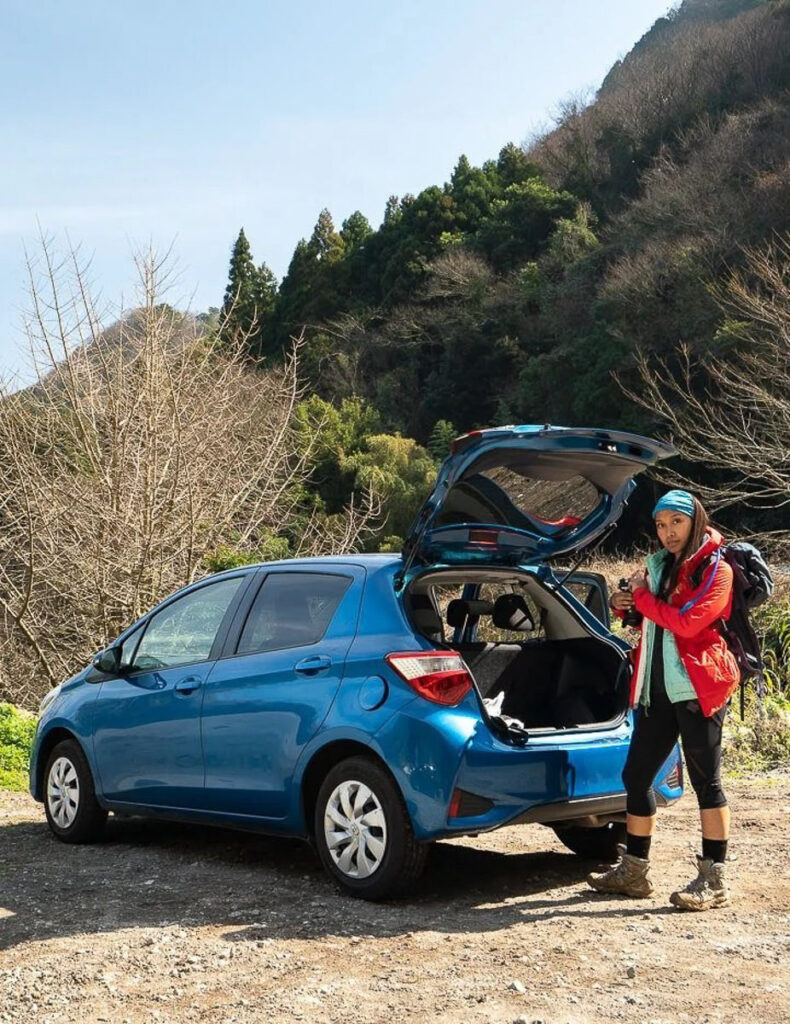
When you book your Rental Car online, I personally recommend and always use Klook for car rentals in Japan. They search for both local and international companies, so you get the best deal!
Table of Contents
30 AWESOME THINGS TO DO IN KYUSHU
I’ve written individual guides for many of the specific locations in this article, which means you can click on the link and view the detailed guide for each individual location, which includes how to get there, all the photos, and what to expect. At the bottom of this post, I will add a few sections of things you need to know before exploring Kyushu such as how to get around, where to stay, and other logistical and travel tips to help you out before your visit.
TOP 3 PLACES TO STAY IN KYUSHU
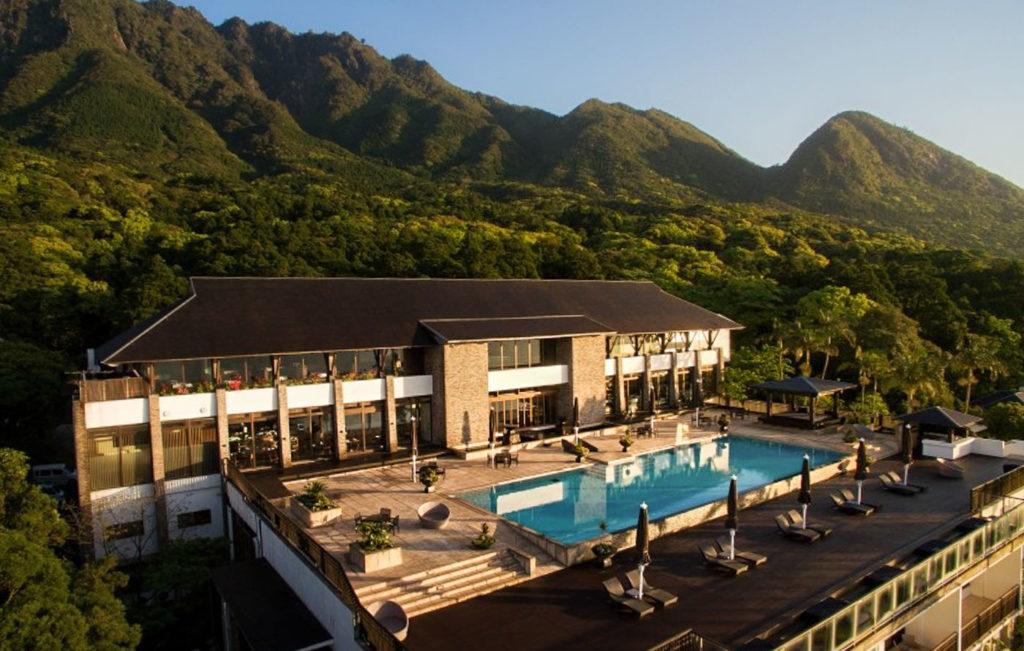
- Ultimate Luxury: Amane Resort Seikai best location and view
- My Favorite: Sankara Hotel & Spa – Natural Forest, Pool & Beautiful surroundings.
- Budget Hostel in Kyushu: WeBase Hakata Hostel is easily the top hostel in Kyushu
ONBARA FALLS
The journey to Onbara Falls is a very, very short trek but will remove you from the town of Beppu and immerse you in the jungle making you feel lost beneath the falls. Onbara Falls is a bit of a hidden gem just outside the town of Beppu in Oita Prefecture of Kyushu, Japan. Beppu is one of the most famous Onsen towns in Japan and even the world. However, amidst all of the hot springs and Onsens are some truly epic waterfalls and Onbara Falls is up there with the most beautiful and most accessible.
The trail is short and well-defined with a dirt/rock path leading you up to the falls. With the morning sun shining through it was actually a beautiful little walk, which is only about 2km return.
Read the full blog post for details: ONBARA FALLS IN KYUSHU, JAPAN
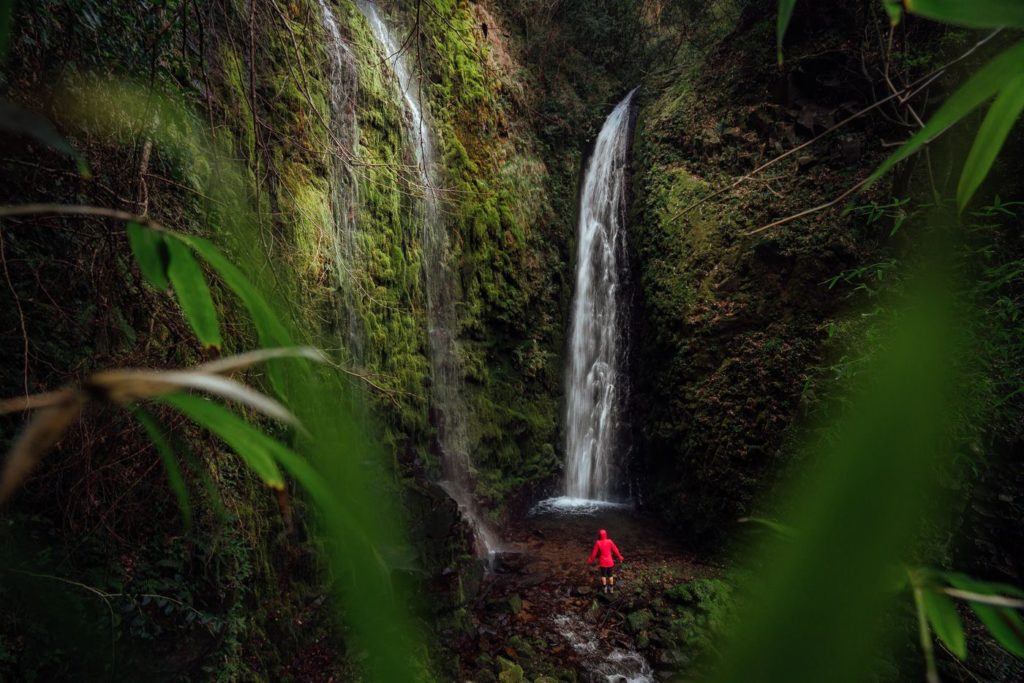
HIKING TO MOUNT KARAKUNI IN KIRISHIMA
Mount Karakuni is the highest peak in the Kirishima Mountain Range of Kyushu Island in Japan with a height of 1,700 meters. Mount Karakuni has a volcanic crater, which is 900 meters and 300 meters deep. The hike up from the visitor center is relatively short with just a few kilometers in distance but quite steep. From the summit, you can look over to the ‘Ring of Fire’, which is the off-limits
The total hike distance for me was 9.6km for my entire lap of the Kirishima area but there are many ways to make it shorter. If you just go up and down Mount Karakuni from the visitor center it will be about 5-6km in total. I added on the lap of Lake Rokkannonmiike and Lake Byakashiike.
Read the full blog post for details and all photos: MOUNT KARAKUNI HIKE (KARAKUNIDAKE) IN KIRISHIMA
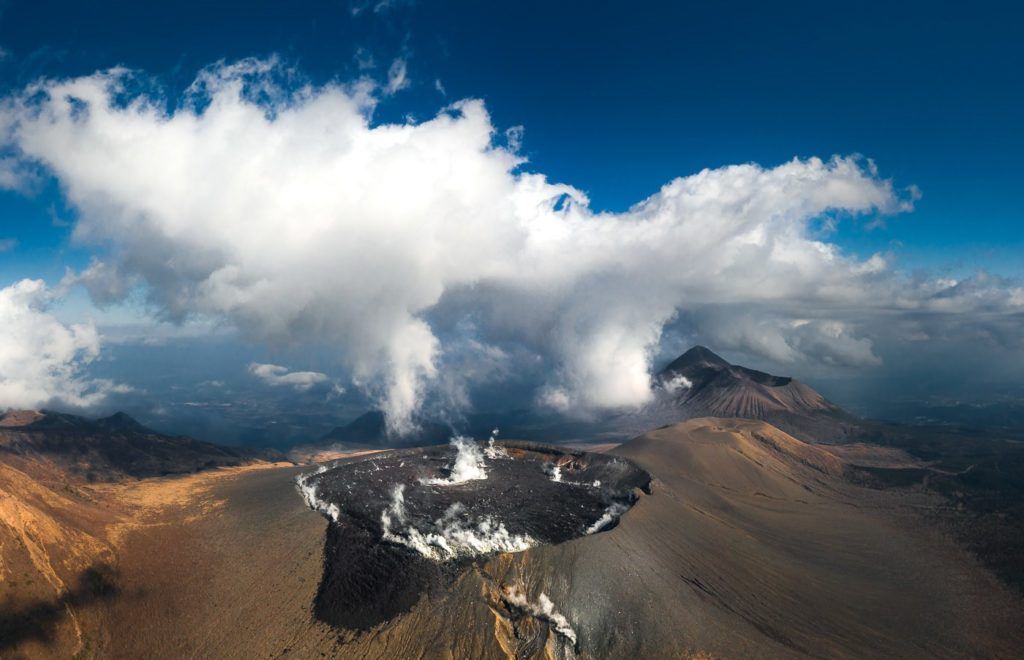
MOUNT TAHARAYAMA
The Mount Taharayama hike leads you on a steep ascent up to an epic, rocky ridgeline before you descend down into the forest to discover a 10th century stone buddha carving into the cliff wall. It’s an adventure with a tomb-raider vibe and is definitely sure to have you off-the-beaten-path and out there amongst the adventure in the Oita Prefecture of Kyushu Island, Japan.
Read the full blog post for details and all photos: MT. TAHARAYAMA HIKE TO KUMANO MAGAIBUTSU (BUDDHA STATUE)
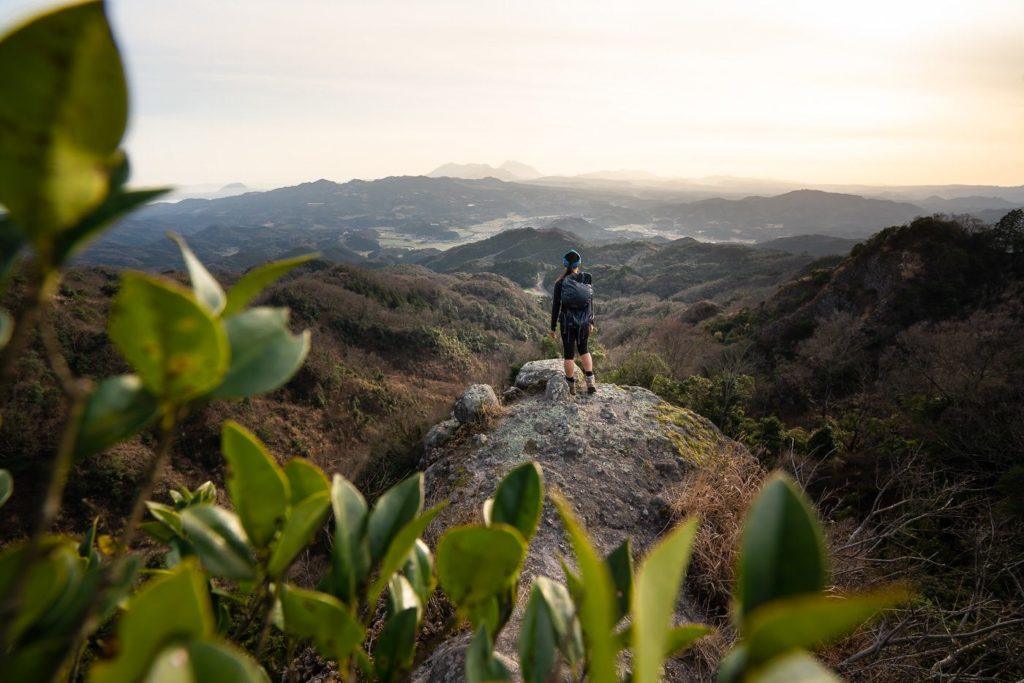
INUKAI FALLS
Inukai Falls was probably my favorite waterfall that I visited while based in Kirishima. It was a booming waterfall but I really loved the gorge that led up to the falls, which was lined by woodland and forest giving it a Pacific Northwest vibe. I actually had to wait a while here for the fog to clear enough to see the falls but when it cleared a little, I was able to record a little video on the drone to show you just how epic this gorge is.
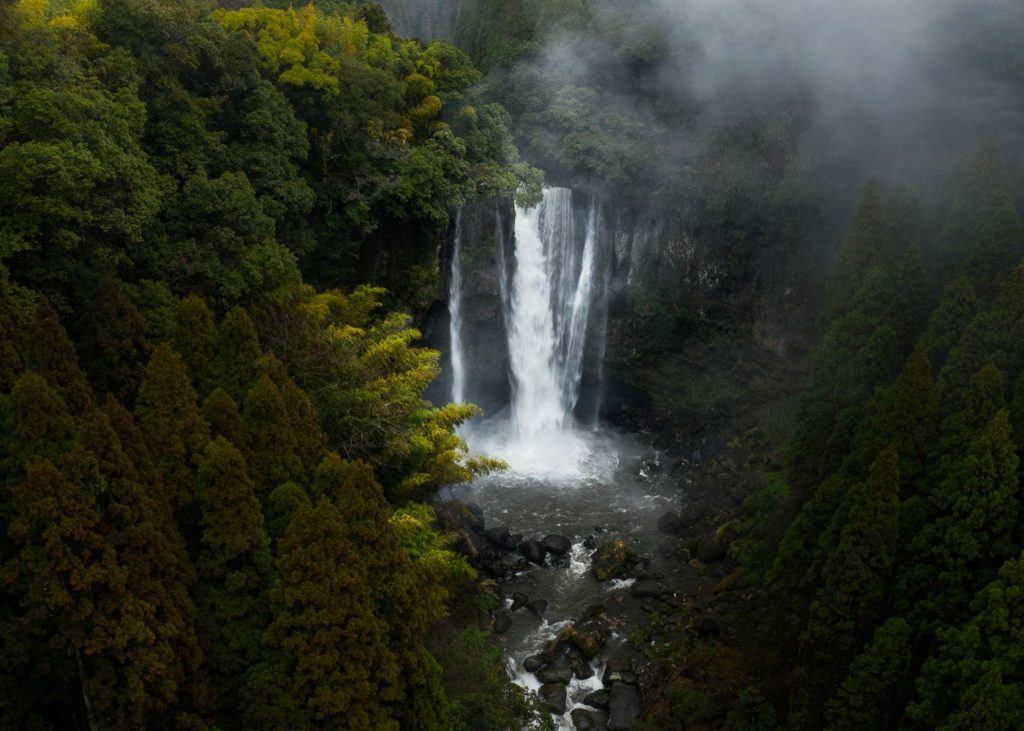
HIKE MOUNT ASO
In the Aso region of the Kumamoto Prefecture in the center of Kyushu Island is the Mount Aso region, which is one of the largest calderas in the entire world. Hiking in Mount Aso Region is one of the most incredible adventures you can have in Japan. Mount Aso is a volcanic depression, which is essentially a huge crater that has a number of peaks within this region that can be trekked. There are numerous craters within the crater such as the very active Nakadake Crater.
The Caldera spans 17 kilometers from east to west and 25 kilometers from south to north with a total area of 350 square kilometers. When we talk about this caldera it is a huge area but at the center of the caldera is where all of the action is when it comes to volcanic activity, hiking, the museums, and tourism. In the middle of the caldera is the central crater group which consists of the five Aso peaks which are Mt. Taka (Takadake), Mt. Naka (Nakadake), Mt. Eboshi (Eboshidake), Mt. Kijima (Kijimadake) and Mt. Neko (Nekodake).
I hiked all of the peaks except for Kijima. The Nakadake and Takadake loop (when open) is my favorite hike in Kyushu… by far. It looks down on the active volcano crater and makes you feel like you are in outer space or trekking through a post-apocalyptic world.
Read the full blog post for details and all photos: HIKING MOUNT ASO VOLCANO – A COMPLETE GUIDE
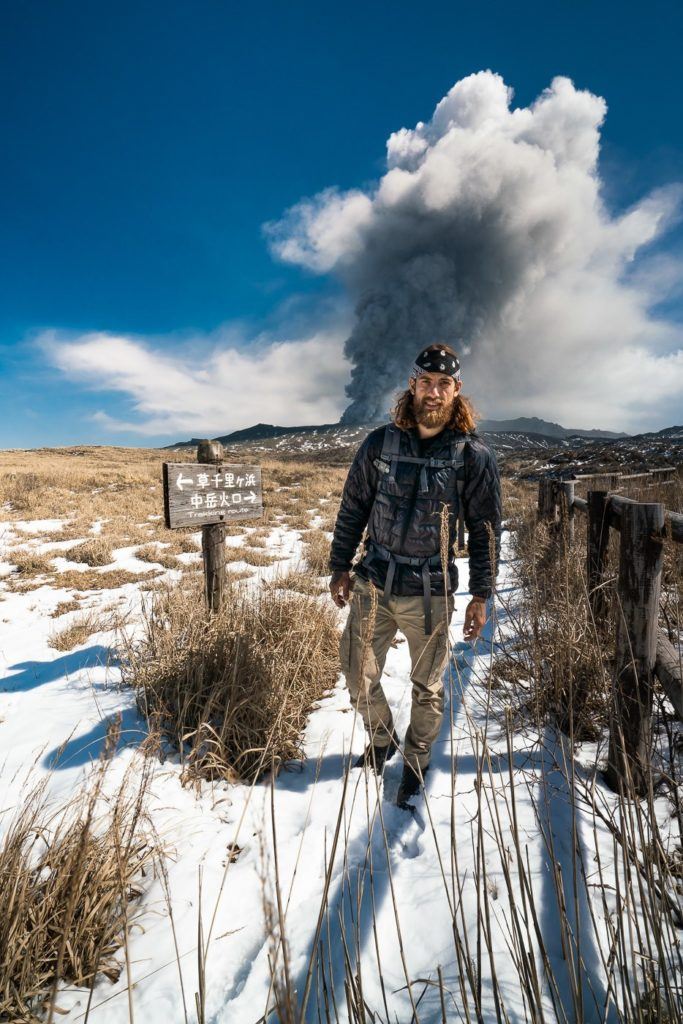
BEST INSURANCE FOR TRAVELERS

Don’t wait for an accident to happen… get insured! My travel insurance is HeyMondo which offers low-cost travel & medical insurance. That’s me on the left with three teeth knocked out after a motorbike crash in Bali!
You can click to read my Full Review of the Best Travel Insurance .
I’ve made several successful claims with HeyMondo and find their customer service very quick and helpful. Click the button below to get a 5% DISCOUNT
NABEGETAKI FALLS
Found on the border between Oita and Kumamoto, Nabegataki Falls is one of the most impressive waterfalls on the island of Kyushu in Japan. With hundreds of waterfalls on Kyushu, what makes this one so special? You can actually walk behind the wide cascade, underneath the rock face that the waterfalls pour down over. It’s a pretty magical spot.
I did my best to shoot the waterfall without any tourists but it is quite difficult as most people do a little lap underneath the waterfall viewing it from in front, each side and behind. It’s a bit of experience and going behind the waterfall was super cool. The waterfall itself is only 10m high but spans 20m across in width and pours down over the ledge, which is what makes it so unique.
Read the full blog post here: NABEGATAKI FALLS IN KYUSHU
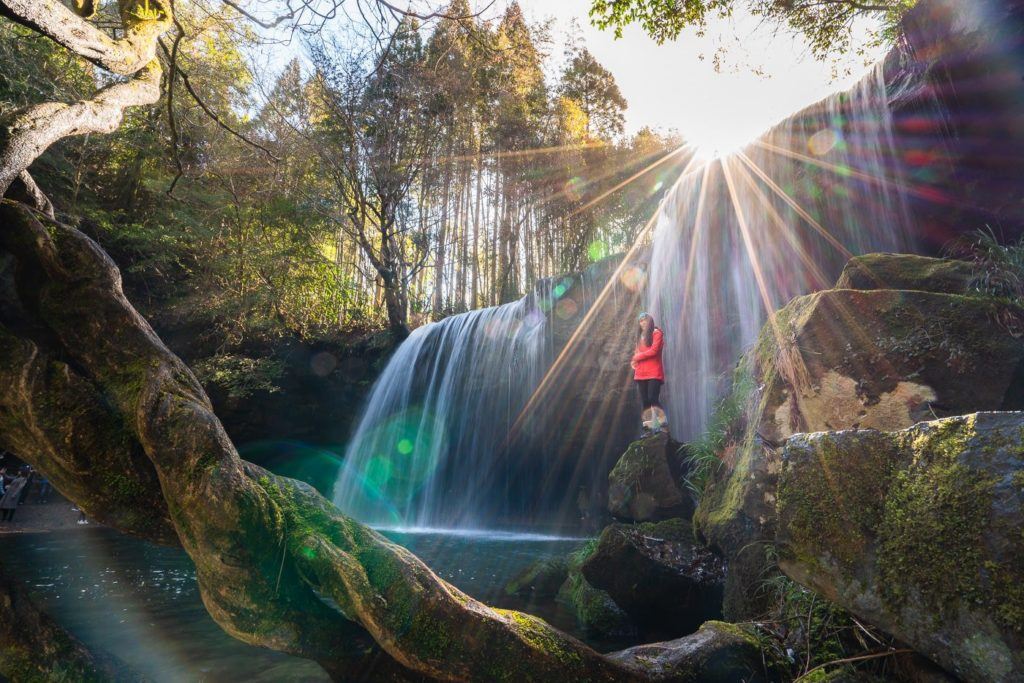
MOUNT EBOSHI HIKE
Mount Eboshi is one of the five peaks of the central cone group of the famous Mount Aso. It’s the easiest peak and probably the safest peak to climb taking just over an hour to get up and down from the summit. The view from the top is quite remarkable as it looks out over the Nakadake Crater, which is where the active volcano of Mount Aso is found.
The Mount Eboshi hike is a great little trail not because of the views or the adventure but because it is usually open! Because Nakadake Crater and the active volcano within it are often spewing ash high into the air, the surrounding trails are often closed. This leaves adventurous hikers feeling a bit stuck. Luckily Eboshi is a bit further away but you still have nice views of the erupting volcano.
At the summit, you have a view out to Nakadake Crater, which is where the eruptions, smoke, and all the action takes place. In the other directions, you can witness the entire caldera and the various rock formations and craters that are scattered throughout the region. I visited Mount Eboshi as part of the ‘ Around Aso Tour ‘, which was the perfect way to explore this region on a full-day trip from Fukuoka.
Read the full blog post for details and all photos: MOUNT EBOSHI HIKE (EBOSHIDAKE) IN MOUNT ASO
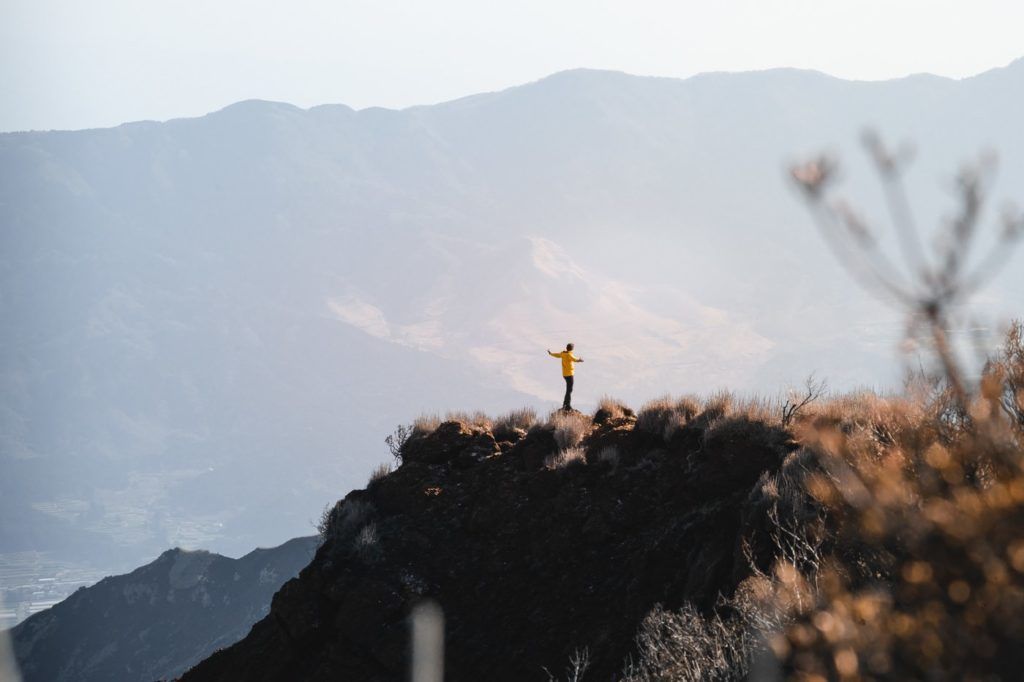
HIGASHI SHIIYA FALLS
Higashi Shiiya Falls is a pretty epic waterfall just out of Beppu Town. When you arrive you will park in the parking lot of the information center and pay your entrance/parking fee and then make the 800m along the river and through the gorge to reach the waterfall. It’s a really pretty walk and I can’t imagine how scenic it would be with the fall colors. At the end of the gorge is a massive waterfall flowing into a giant circular pool.
MOUNT NEKO (NEKODAKE) HIKE
Mount Neko is the second tallest peak in the Mount Aso region at 1,443m high for the Tengu Peak and the opposite Toho Peak is 1,408m high. It’s called Nekodake because from Aso it looks like two cat ears when you see both of the peaks. It was an awesome but steep hike and the jagged peaks were just incredible at the summit during sunset.
As well as the numerous ropes to help you up the summit of Nekodake, you will also encounter several ladders, helping you ascend through the forest. None of the ropes, ladders or bouldering is technical or very difficult but be prepared for a bit of action along the trail.
At the summit, you will look out across to the Tengu Peak, which is the most prominent peak and you really can’t miss it. In the late afternoon, the sun sets behind this peak so it’s a really magical spot to take in the whole ridge.
Read the full blog post for details and all photos: MOUNT NEKO HIKE (NEKODAKE) IN KYUSHU
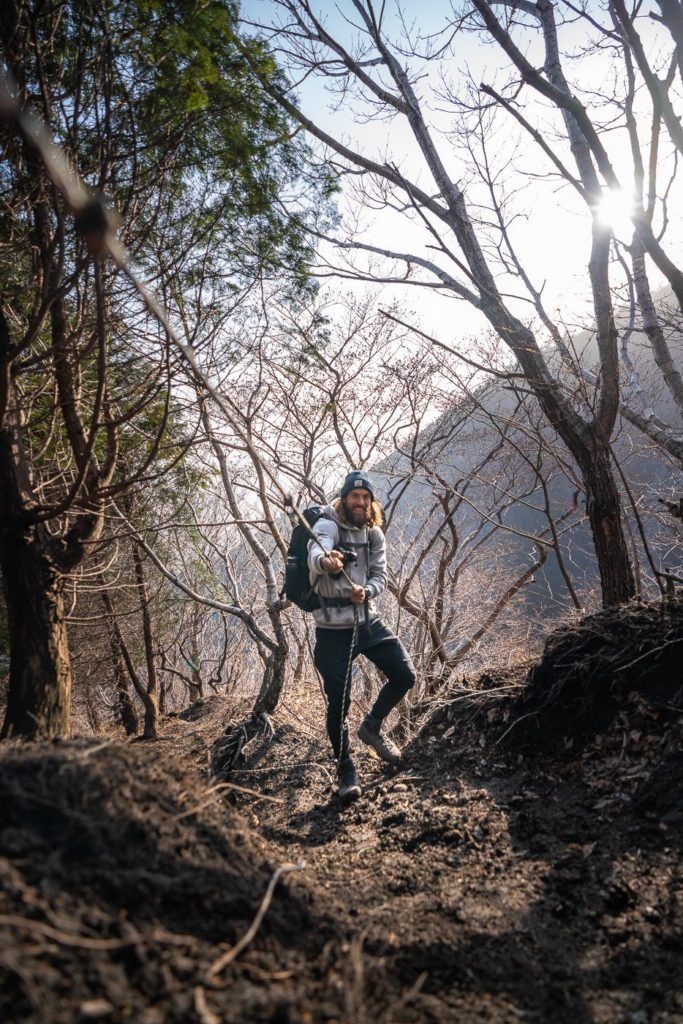
What are my favorite pieces of travel gear?
There are four pieces of gear that I simply never travel without. These are four items that I using right now and this list gets updated every year! Here are my travel essentials.
- Packing Cube Set : Once you cube you’ll never go back. Organize your clothes within your luggage with these smart mesh containers. It will revolutionize your packing.
- Quick-Dry Towel : A quick-dry towel is a must for travelers. It hardly takes up any room and dries in seconds.
- Travel Wallet : Keep your passport, wallet, and vaccine card safe as well as any forms and important documents you need to store.
- Grayl GeoPress Water Filter Bottle : I’ve used this for three years. It filters your water with one press and you can drink directly from it. Never buy a plastic water bottle again!
GOROGA TAKI FALLS
The Gorogotaki Waterfall is the largest falls in Yamato, Kumamoto with a 50m drop into the basin below. The beauty of this waterfall on Kyushu Island is that often it is crowned by a rainbow as the water crashed down onto the rocks, spraying up and catching the light perfectly in a stream of color. My favorite part about this waterfall is that you view it from the suspension bridge. There is also a really nice walk around the region through the rice fields and through the gorge to the base of the falls.
Read the full blog post here: GOROGOTAKI WATERFALL NEAR KUMAMOTO
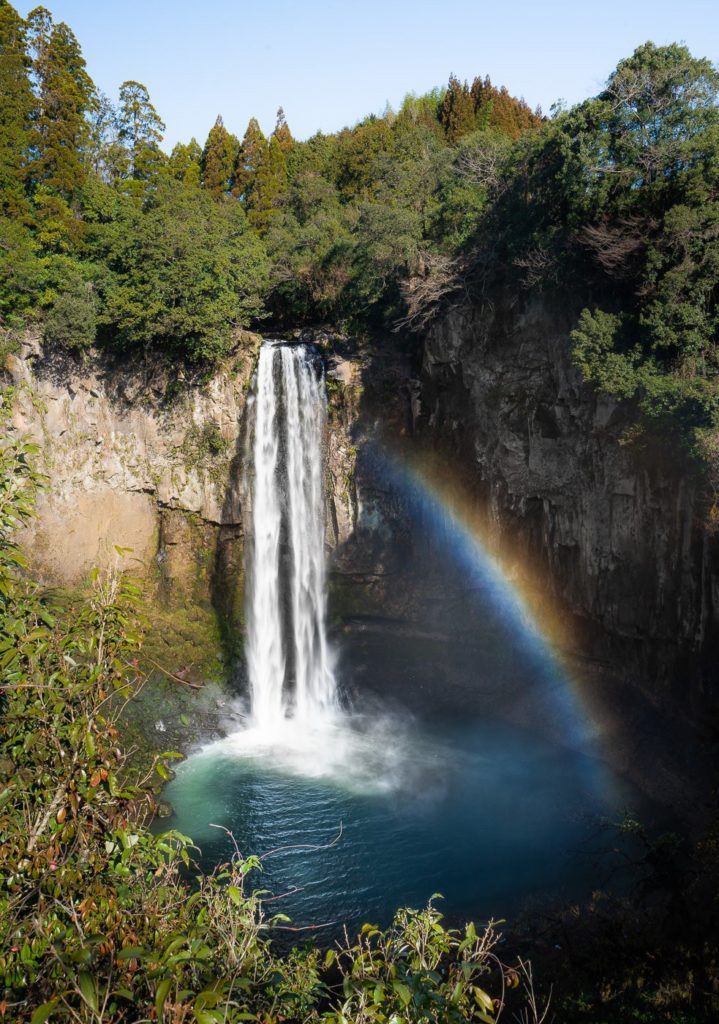
DAIKANBO VIEWPOINT
Daikanbo Viewpoint is probably the most impressive views in the Mount Aso Region with epic views across the valley within the caldera to the active volcano within Nakadake Crater. There are lots of little trails and a number of viewing platforms to explore at the viewpoint. It can be a great spot for sunrise on a day with low-lying fog so if you are good at weather predictions try and make that happen. I visited when the grass was dead in the winter but the colors change all throughout the year.
HIKING IN THE KUJU MOUNTAINS
The stunning Kuju Mount range is part of the Aso-Kuju National Park and while Mount Kuju might be the most famous it is actually the nearby Nakadake Peak that is the highest peak in the park, which makes it the highest point on Kyushu Island. These mountains are connected by a series of hiking trails so you can kind of make it up as you go, pushing on to ‘one more peak’ time and time again or follow a set route. I did a bit of both.
It’s straight up from the get-go so don’t put too many jackets on you will be working that incline straight away. Once you reach the ridge it’s time for the adventure to start. The trail turns into a rocky ridgeline with a number of ladders and some very low-key bouldering required.
The total day of climbing was 1,026m so it’s always an effort when you grab a vertical kilometer. The trail was rocky but quite well defined and we never had too many difficulties finding our way. At the top of Mount Kuju we could watch over the erupting Mount Aso in the distance and admire the valley below.
Read the full blog post for details and all photos: HIKING THE KUJU MOUNTAIN RANGE
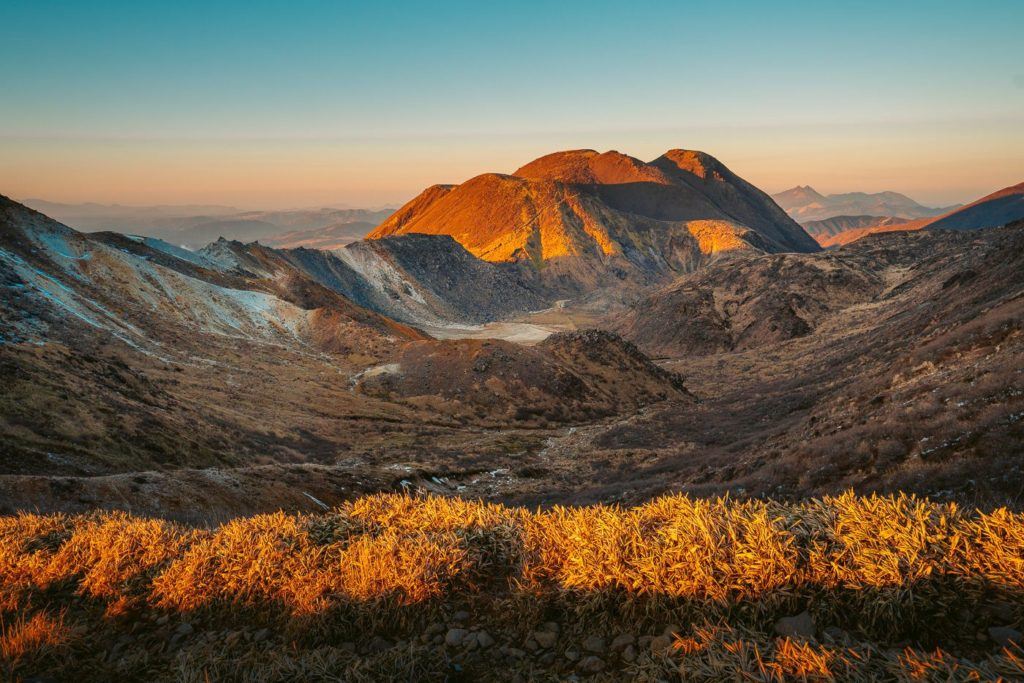
SHIRAITONO FALLS
Hidden in the foothills on the way to Mount Aso region on the way from Kumamoto is Shiraitono Falls. It isn’t a hike or a big adventure and you can actually just drive and park only fifty meters away from the waterfall. The golden light was hitting the waterfall in the late afternoon, which created an epic little scene where everything was in shade except for the golden stream of water flowing down.
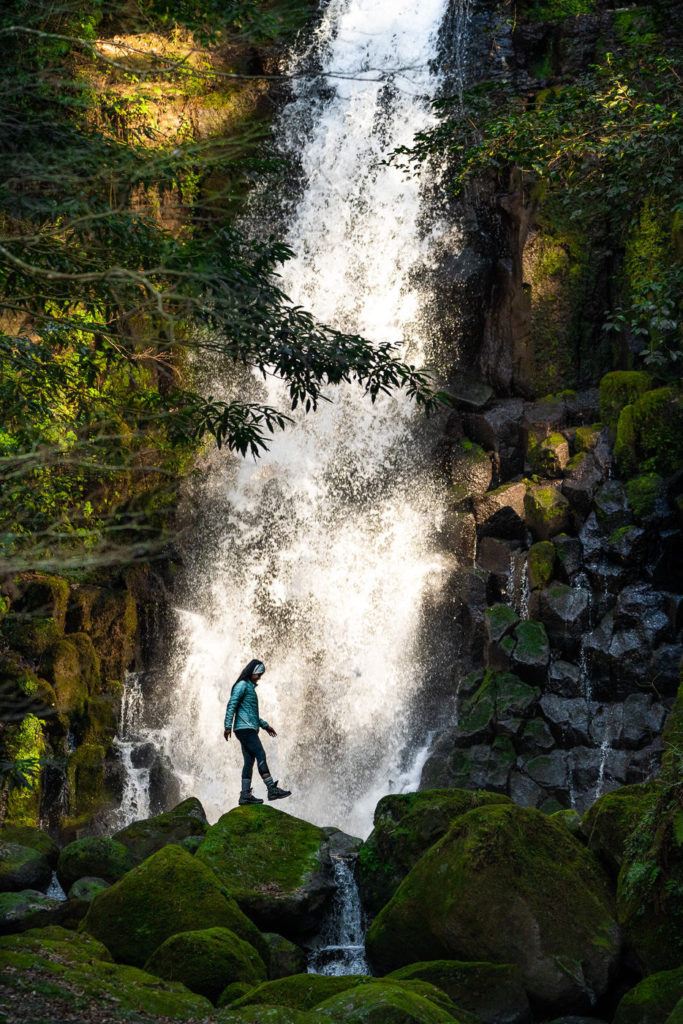
VISIT THE BEPPU HELLS
The ‘Hells’ of Beppu, as they are known, are seven incredible hot springs all in one area. Unlike many of the onsens or hot springs in the area, these specific hot springs are for viewing only as they are far too hot for bathing. They are quite a tourist attraction and it almost looks like zoo enclosures but instead of almost there is a bubbling, steaming pool of volcanically heated water. The reason these ‘Hells’ are so unique is that they each have a different feature such as the orange Hell or the deep blue Hell. I thought the experience of visiting the Hells of Beppu was quite cool but very touristy.
I visited the Beppu Hells as part of this full-day tour from Fukuoka including the Beppu Hells and Yufuin Spa Town.
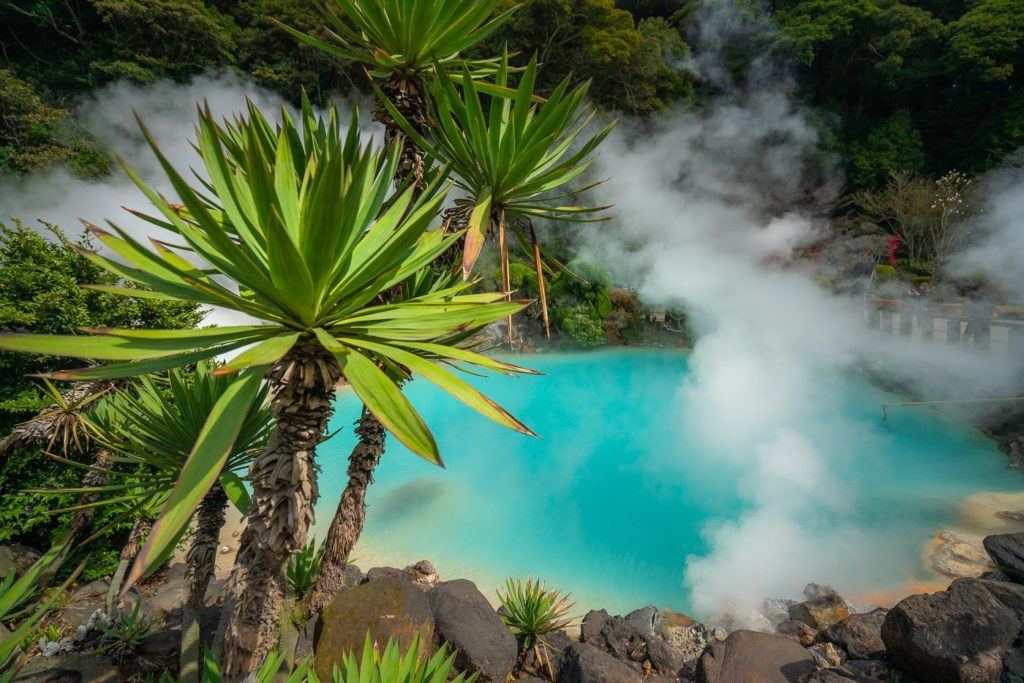
TAKACHIHO GORGE WATERFALL (Minainotaki Waterfall)
Takachiho Gorge is one of the most incredible natural attractions on Kyushu Island, Japan. In the forest of Miyazaki, the Gokase River runs through a gorge comprised of volcanic basalt columns where the 17-meter high Minainotaki Waterfall pours down on the awe-struck tourists below who are paddling the iconic rowboats through the narrow chasm.
Kyushu Island is beautiful in the summer and the fall, which are the most popular times for tourists. In the fall you get the beautiful tinged orange and different colors on the trees and in the summer you are blessed with the best weather. I visited in the winter, which was not the prettiest time as lots of the leaves were dead so there were plenty of sparse trees. However, Takachiho Gorge was at a lower elevation and in a spot that was still beautiful and green in the winter. The conclusion is pretty much that it is a year-round attraction, which will only differ slightly at various times throughout the year.
TAKACHIHO GORGE DAY TOUR
As I said above, Takachiho Gorge is a bit hard to get to with public transport so unless you have rented a car, the best way to get there is on the Takachiho Gorge Day Tour . The tour includes drop-off and pickup from your hotel, an English-speaking guide for while you are at the gorge. Helen the guide is an absolute legend and we loved this tour and this epic location.
CLICK HERE to check rates and availability for the Takachiho Gorge Day Tour
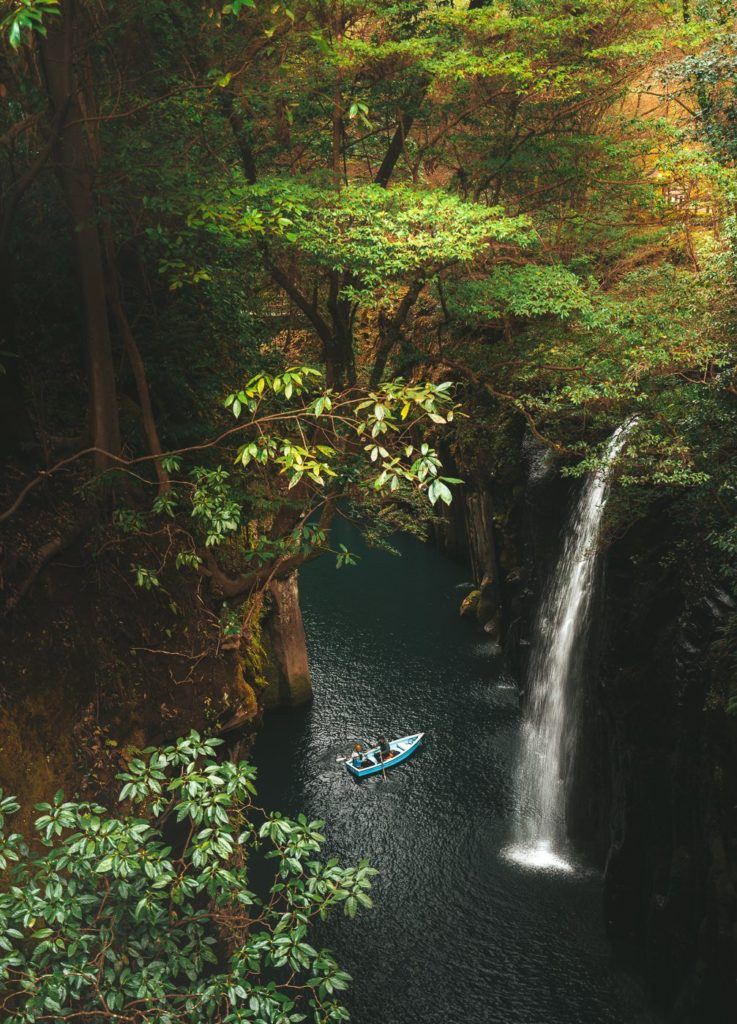
MOUNT KAIMON (KAIMONDAKE) HIKE
Mount Kaimon (Kaimondak) is an inactive volcano along the coast in the south of Kyushu known for its conical shape. The Mount Kaimon hike leads you through the forest on a steep, rocky trail up ladders and boulders to the summit where you are rewarded with coastal views from the top of the volcano.
The trail begins with an incline from the very first moment as you wind your way through the woodlands at the base of the volcano. It was a very beautiful part of the trail as the sunlight shone through the trees and into the mini canyons created by erosion on the path. At some points, the walls on either side of the trail were above head height, which added a unique atmosphere to the trail.
Read the full blog post for details and all photos: MOUNT KAIMON HIKE (KAIMONDAKE) IN KAGOSHIMA
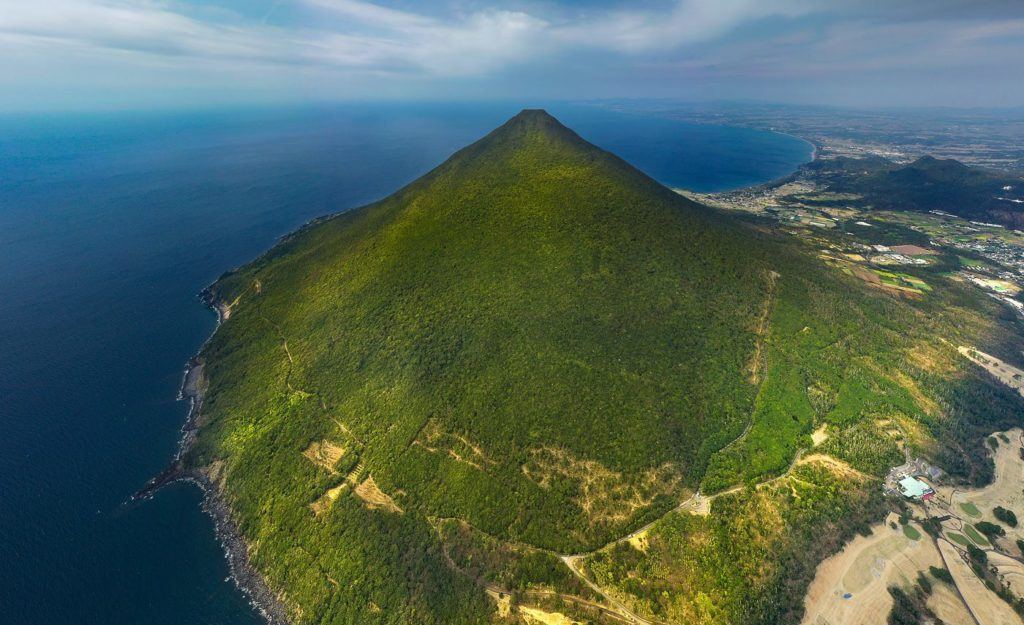
KAMISHIKIMI KUMANOIMASU SHRINE
The Kamoshikimi Kumanoimasu Shrine is hidden in the forests near Takamori, which is a little town in the Aso region of Kumamoto. It’s a very spiritual spot with lots of different spots to make prayers, receive good luck and perform a ritual. For example, you can touch the Hogeto Iwa Stone and you are said to be granted good luck, and the shrines sacred Nagi Tree is said to protect relationships. The Kamoshikimi Kumanoimasu Shrine is the inspiration of the manga ”Into the Forest of Fireflies’ Light” which was written by Yuki Midorikawa.
It’s an incredibly beautiful place with a forest stairway leading up to the shrine and then a huge underpass/cave where you can throw a coin onto the ledge for good luck.
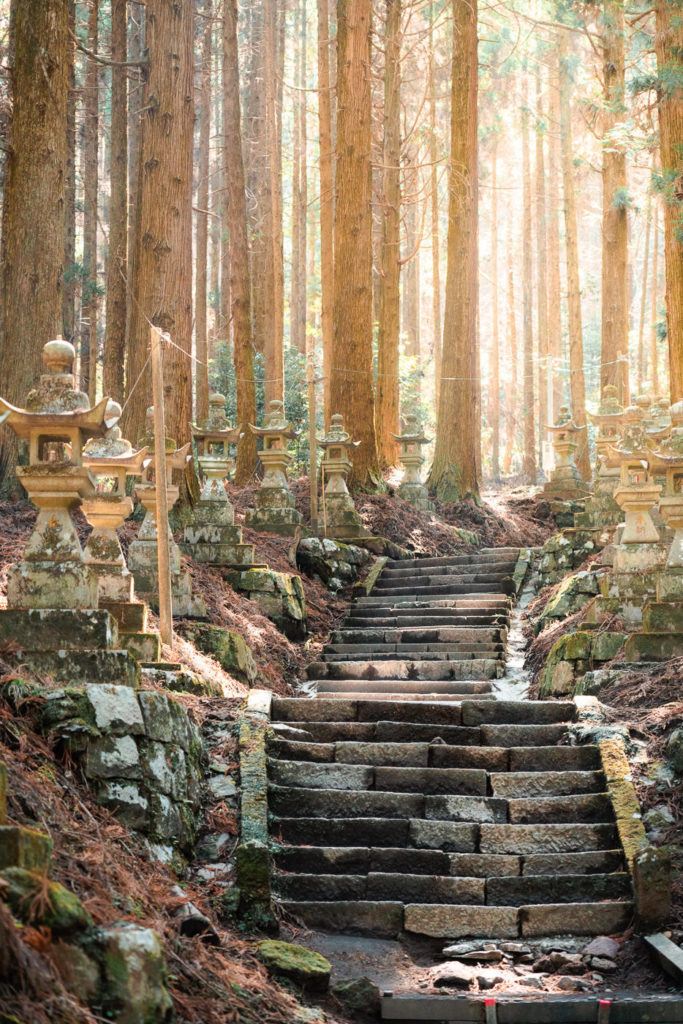
YAESONO FALLS
Yaesono Falls is a sweet little roadside waterfall, which you will find on the way to the Mount Karakuni hike in Kirishima. It’s probably not worth an adventure all on its own because you just park next to the road and check it out without needing to hike. However, if you are heading up to the Kirishima mountains for a hike it is only a small detour and is quite a nice waterfall surrounded by trees.
ENJOY AN ONSEN EXPERIENCE
Kyushu is famous for its hot springs and it is one of the most volcanic places in the world. It is Beppu that is at the center of this volcanic activity when it comes to onsens and hot springs with hundreds of different onsens, spa-resorts, and hot springs to test out. It’s definitely an experience you want to try at least once. The general premise of an onsen experience is that you will arrive fully clothed, strip down to naked, and then bathe in the hot spring water with the other locals and visitors. The minerals, temperature, and meditative experience are said to be very beneficial for your health.
I visited Hoyoland Onsen as they allowed people with tattoos to bathe whereas many do not due to traditional laws. There are lots of very scenic onsens to choose from but make sure you try it at least once as this is the most cultural experience you can have and one of the best things to do in Kyushu.
I didn’t take a photo at the onsen as it isn’t allowed and would be very weird as everyone is naked so I’ve added in a stock photo below to show you what it looks like.
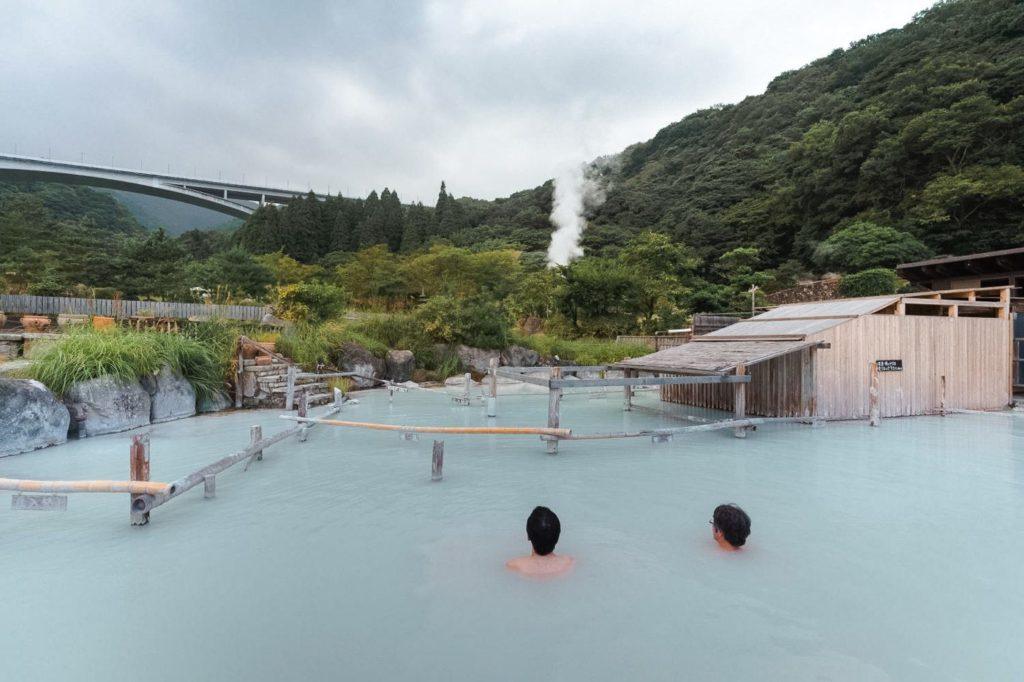
KEYA NO OTO HIKE IN ITOSHIMA
Keya no Oto is a beautiful coastal viewpoint of Itoshima, which has incredible views of the beach from the ominous ridgeline and a 64m cave below! You can hike all the way up onto the top of the ridge as there is a bit of a trail, which includes some basic bouldering/rock climbing. It isn’t a trail I would recommend unless you are athletic and adept at bouldering and climbing.
Atop the ridge, it was a very narrow path. A 50m+ drop on either side meant we had to focus on our steps until we reached a safer, wider spot on top of the ridge. We took a moment to relax up here, taking in the view of the beach and down to the volcanic cone at the other end of the coastline.
Read the full blog post for details and all photos: KEYA NO OTO HIKE IN ITOSHIMA
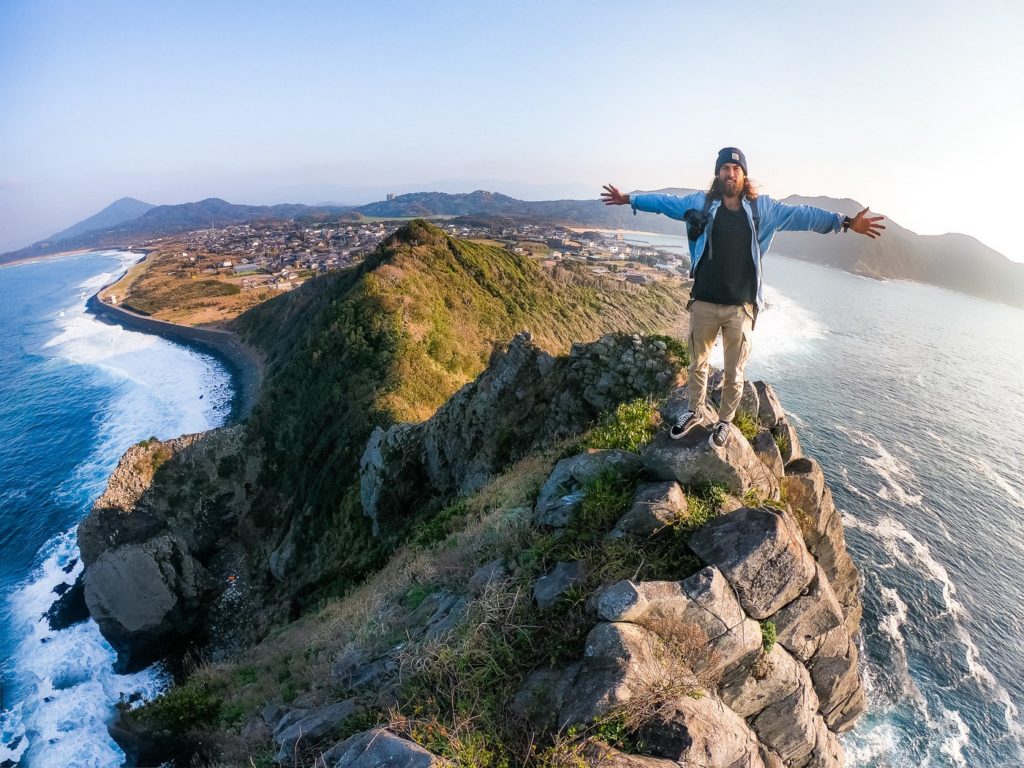
SUGARUGA FALLS
This is a bit of a strange one because the access was limited due to construction going on. There is usually a viewing point but I’m not sure if it will still be closed or not. We managed to fly the drone to still check out the waterfall but normally you can view it from the platform. Nevertheless, it was one of the most powerful waterfalls I came across on Kyushu Island.

MOUNT YUFU HIKE
While I was based in Beppu I headed up for sunrise one morning to hike Mount Yufu. It’s known as being quite a tough hike due to the consistent incline and relentless switchbacks that lead you up to the two peaks at the summit. However, on the day I visited, it was covered in the cloud at the top. We saw deer along the way and really enjoyed the hike. I know the view from the summit is pretty epic so I’ve added it onto this list with a photo from a day with better weather. It was a 7km round trip with more than 700m of an incline up the switchbacks. I’ve included a photo below of the view from the top and the view from below on a day in better conditions than when I hiked. Keep in mind, it is known for being a peak that is hard to catch on a clear day so do pick the best day of the week regarding weather.
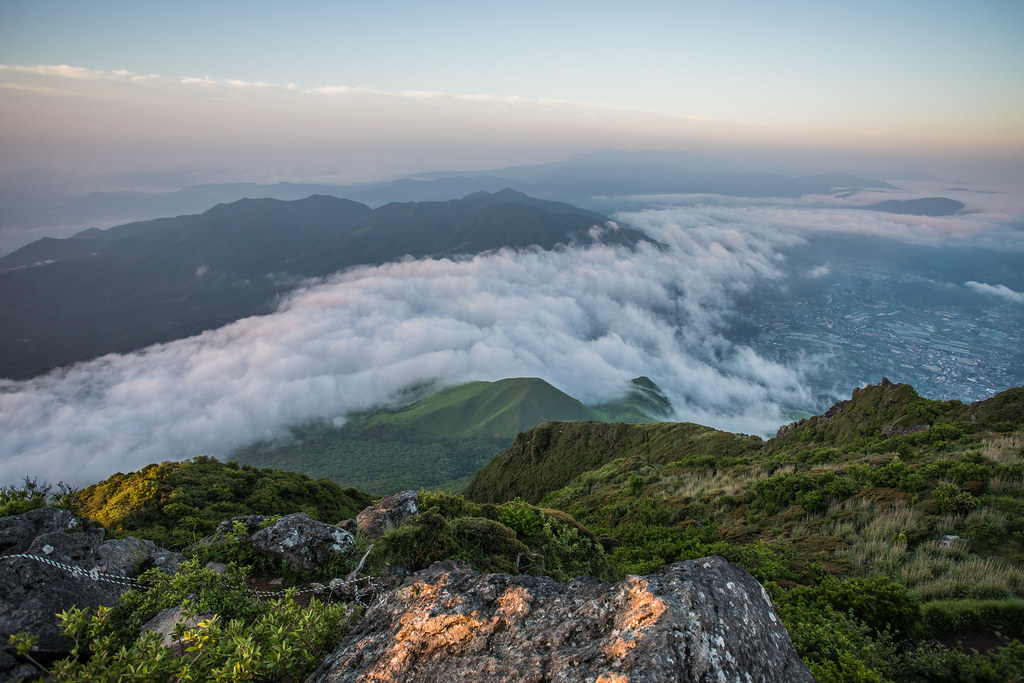
RYUMON FALLS
If you are staying near Kirishima then Ryumon Falls is definitely a spot I would recommend. It isn’t too far from Kirishima town and is a pretty epic waterfall. There is a small parking lot and then you walk about 500 meters to the viewing platform. You can go down closer to the base of the falls as well but it was a stormy, misty day when I visited and I was the only one there. I decided to just enjoy the view from the platform and snapped a photo from right there.
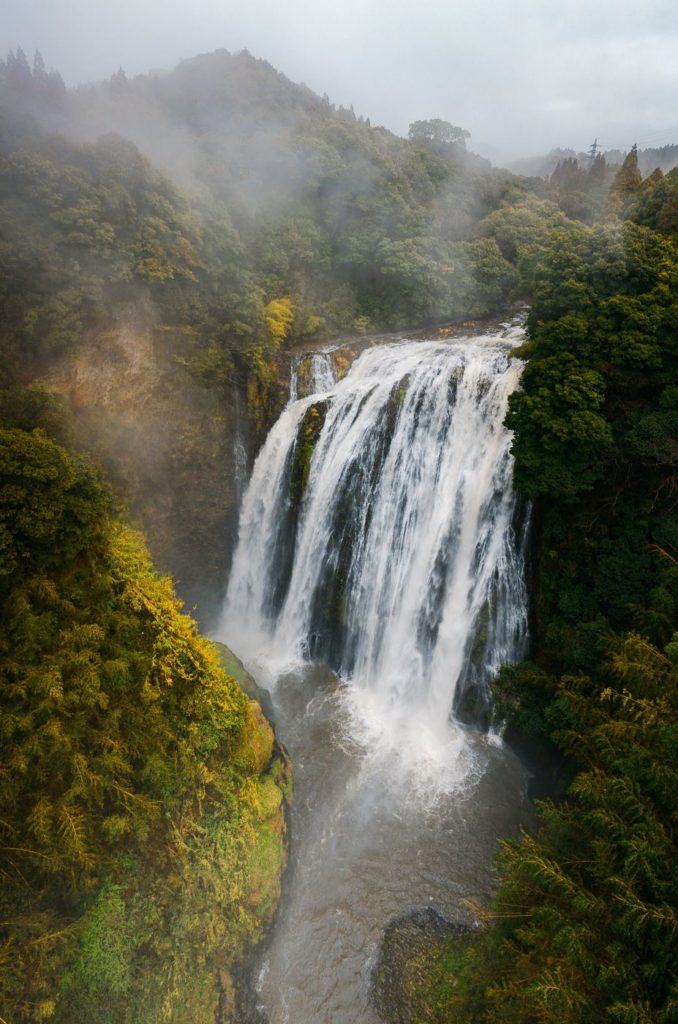
MOUNT TSURUMI HIKE
When you stay in the town of Beppu, you will always notice the mountains looming at the back of the valley. The highest point is called Mount Tsurumi and it’s actually possible to reach by cable car. However, there is a trail to the top if you are up for the very steep challenge. Of course, if you are just in it for the view, take the cable car but for those who love the adventure and want to spot some deer along the way the trail starts just around the backside of the cable car parking. Drive an extra half mile up the road past the cable car parking and you will find the trail entrance on the right side of the road. It’s on maps.me if you can’t find it.
At the summit, you have a beautiful view down over the town of Beppu and the entire beach. Just like Mount Yufu, on the day I visited, the weather was quite poor visibility with heavy fog so I have included a photo from a clearer day so you can decide if this is a hike you are keen to add to your Kyushu bucket list.
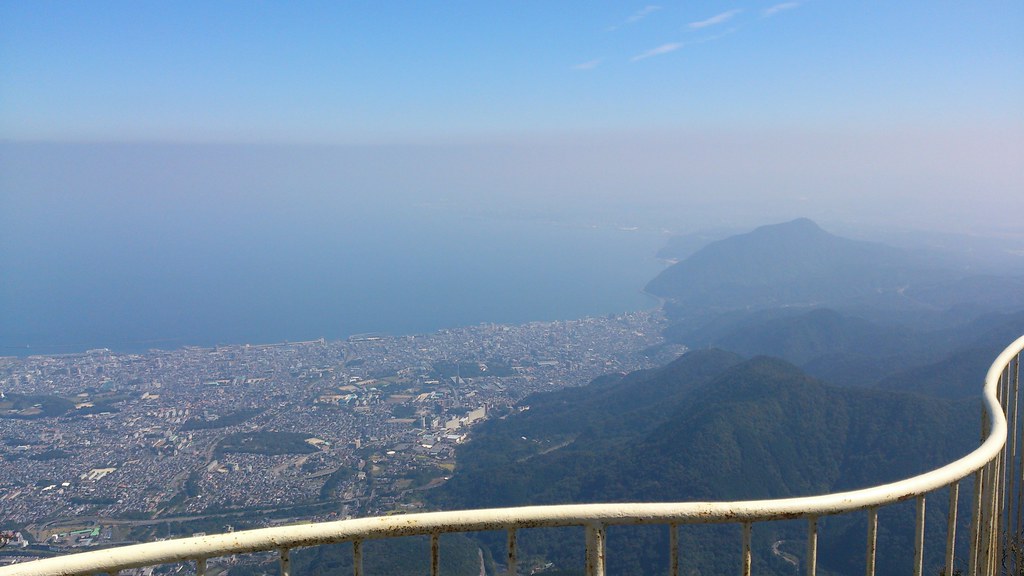
SEKINOO WATERFALL
Sekinoo is a pretty popular waterfall that has a suspension bridge viewing point. I visited it on the same day as Ryumon, Inukai, and the Kinzan Bridge so they are all within reaching distance of each other. This waterfall has a short walk down a forest path, which leads you to the suspension bridge where you can get up close enough to feel a bit of spray on a day with a heavy flow!

KINZAN BRIDGE WATERFALL
While the Kinzan Bridge waterfall is the biggest falls on Kyushu Island, it is a pretty unique little spot. The bridge is actually a serviceable road I used several times while exploring Kirishima and you can get down to river level for photos. I did take this shot from the drone as I floated it under the bridge while a meter or so above the water. There’s a small trail along the side of the river but parking is right next to the bridge so it is a good little pit stop but not the highlight of the day with Ryumon, Sekinoo and Inukai the bigger waterfalls in the area.
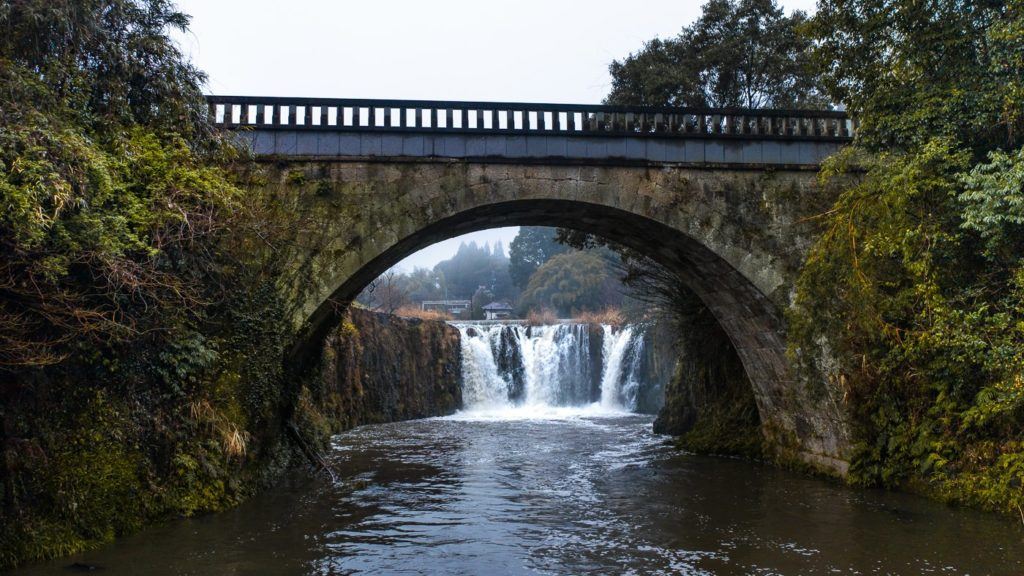
LA PUTA ROAD
La Puta Road was a bit of a local secret until a few years ago when the location gained some serious popularity. All around the edge of Mount Aso caldera are some epic viewpoints but the La Puta Road is really a sight to behold. There is a winding road that just needs to be seen to be believed as it snakes its way along the precarious cliff edge. It’s important to note that technically this site is now closed due to a landslide and it is simply not possible for cars to drive this route anymore. You can just walk up the hill for a bit of a look from a safe spot though although there were some temporary blockages to the walkway. Enter at your own risk on this one as it is technically closed although walking to the hill viewpoint is not of high danger compared to going down near the road where the landslides were. I’ve seen some epic, epic photos here when the grass is green and low-lying fog makes it look like the road is simply floating on clouds.
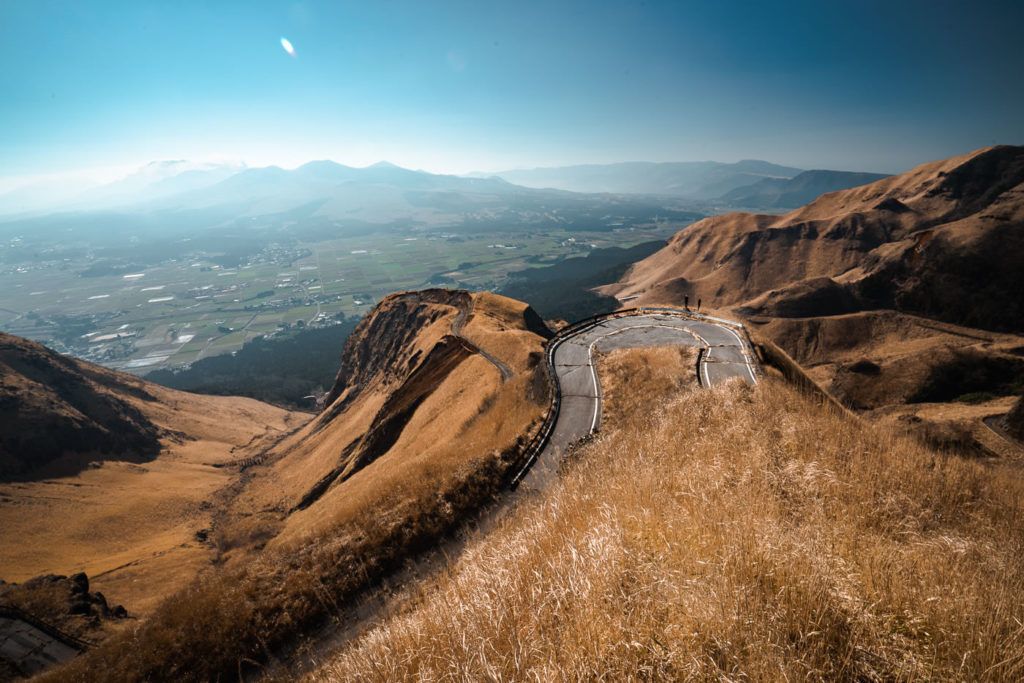
KUMAMOTO CASTLE
Kumamoto Castle is one of the most beautiful castles in all of Japan with it’s large, scenic grounds and a variety of buildings it offers visitors a complete castle experience. It is one of a few structures that have survived the centuries since it’s construction in 1607. There have been a number of maintenance and reconstructions but it is one of the most well-preserved castles in Japan. It’s best to visit the castle from March to April when the 800+ cherry blossoms are in full bloom making the entire area a fairytale location.
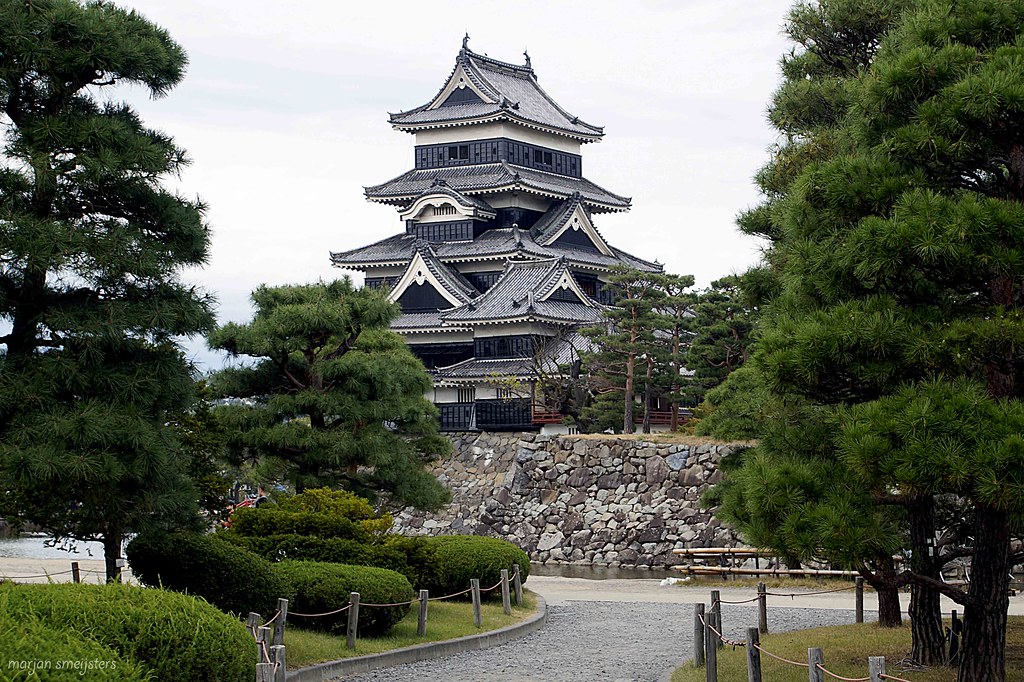
SUSUHARA VIEWPOINT
There are lots of great places to view Sakurajima Volcano but I really enjoyed the little Susuhara viewpoint all to myself as I watched the plumes come out of the very active volcano near Kagoshima. I actually stopped off here on the way to the Mount Kaimon hike but there were lots of different viewpoints with great views of Sakurajima Volcano so if not Susuhara, make sure you stop somewhere along the way to observe this epic volcano.
KOKONOE YUME OTSURIHASHI SUSPENSION BRIDGE
The Kokonoe Yume Otsurihashi Suspension Bridge is in the west of Oita and is the longest and highest pedestrian bridge in all of Japan! From the bridge, you look down 173-meters below to the Naruko River which sits in the steep gorge. From the bridge, you can see the Kuju Mountains and the Handa highlands as well as several waterfalls nearby.
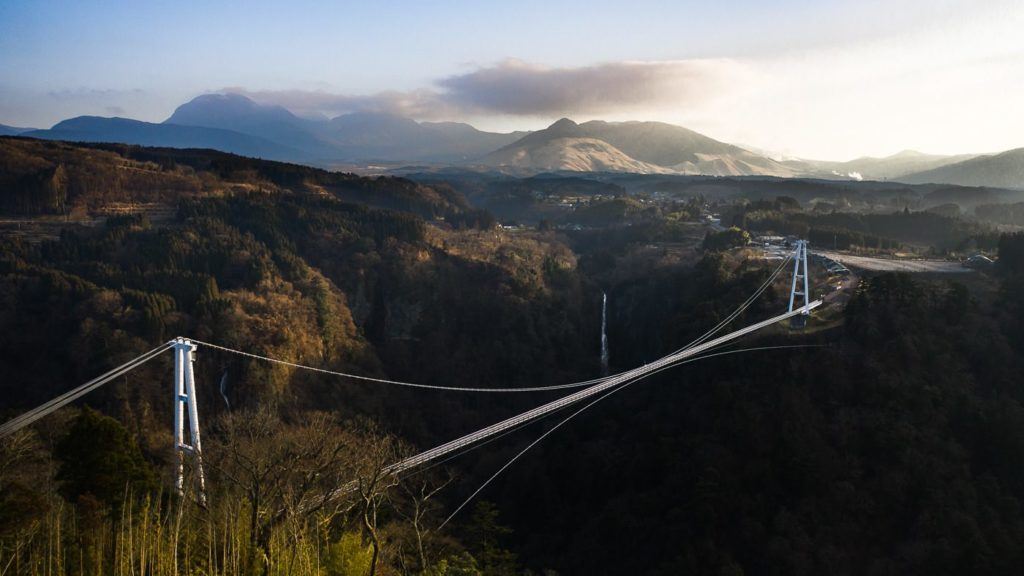
KUNIMIGAOKA VIEWPOINT OF BEPPU TOWN
Just before you get into Beppu make sure you stop at the Kunimigaoko Viewpoint where you will have the best views over this famous hot spring region. I was there in the middle of the day so the lighting was a bit tough but if you came up here for sunrise or sunset you would be in for an absolute treat as you will see the beautiful colors of the ocean as the light peaks over the mountains.

HOW TO GET AROUND KYUSHU FOR ADVENTURERS
While the train may suit those in Tokyo, Kyoto, Osaka, and even in Fukuoka, it won’t cut it out here on Kyushu. The trains will get you from major towns and even into some regional areas with bus connection but almost all of the adventure sports I visited had no bus connection. When I searched on Google Maps and clicked the public transport option it would just say ‘not available’. It was very clear, very quickly that Kyushu island is best to explore by car, especially if you are doing hikes and activities outside of the city (literally everything on this list).
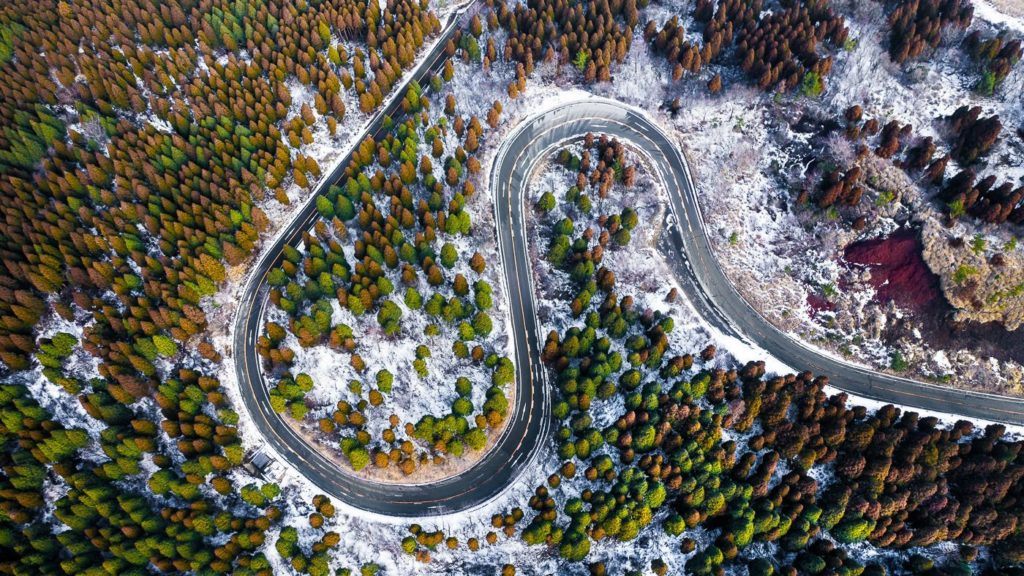
*** It is extremely important to know that you MUST HAVE an international driver’s license to rent a car in Japan. In fact, they won’t even look at your actual driver’s license and only want to see the international driver’s license. Take that seriously as they genuinely will not give you the car and likely no refund if you don’t have that. To get one you need to be in your country of residence and you can get one on the spot or order online and receive it in a week or so. Make sure you organize that in advance as I almost got caught out not knowing that.
BEST TIME TO VISIT KYUSHU
I visited in February, which was winter and freezing. I don’t advise it but it was still epic. The best time to visit Kyushu is most definitely not winter. It’s not really a ski destination so likely you will be freezing and all of the leaves will be dead so the landscapes will not be as beautiful as other times of the year. There are a few drawcards to each season so I will go through them below.
- Fall/Autumn: The temperature is mild and comfortable making it great for hikes and adventuring. If you time things right, you will get the beautiful fall colors out on the trails!
- Spring: This is definitely the most popular season to travel to Kyushu with sunny days and comfortable temperatures. It is very popular at this time due to the cherry blossoms and flowers that are in full swing at this time of year.
- Summer: While not known for its beaches, Kyushu does offer a number of great swimming spots and beaches to explore. For hiking, it may get a little hot but (up to 30 degrees celsius) never reaching temperatures that would limit your adventures.
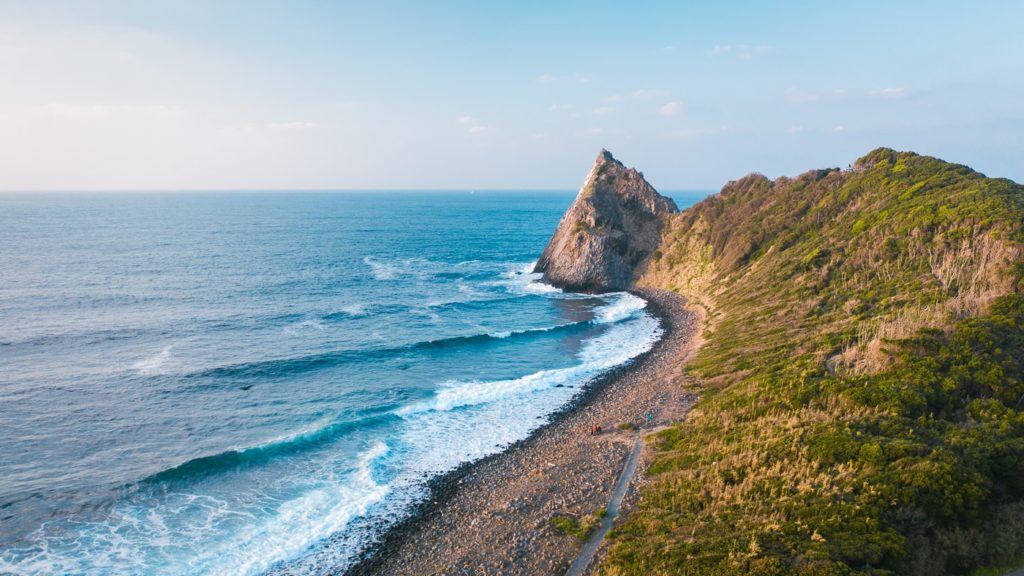

WHERE TO STAY IN KYUSHU
- Best Luxury Place to Stay in Fukuoka: Hotel WBF Grande Hakata (Value): This is by far the most popular hotel and one of the most luxurious in Fukuoka.
- Best Value Place to Stay in Kumamoto: Hotel The Gate Kumamoto (Value): Hotel The Gate is a well-situated accommodation in the heart of Kumamoto, just across the train station and within walking distance to shops and restaurants.
- Best Luxury Place to Stay in Kumamoto: Kumamoto Hotel Castle (Luxury): Set near the infamous Kumamoto Castle, this luxury hotel features a wide range of carpeted rooms from standard rooms to suites fitted with plush amenities.
For a full list of the top-rated places to stay in Kyushu, you can check out my comprehensive guide: WHERE TO STAY IN KYUSHU: BEST REGIONS & HOTELS

ARE YOU FOLLOWING MY KYUSHU BLOG SERIES?
I spent over three weeks exploring Kyushu and visited some incredible waterfalls, hiked some amazing trails, and visited a number of epic volcanoes. I created a number of guides to help travelers find the best spots in Kyushu. You can explore the articles by clicking on the links below.
- The Ultimate Kyushu Bucketlist: 30 AWESOME THINGS TO DO IN KYUSHU
- The best places to stay in Kyushu in each region: WHERE TO STAY IN KYUSHU: BEST REGIONS & HOTELS
- How to plan your Kyushu vacation: THE ULTIMATE KYUSHU ITINERARY: 5-DAY, 7-DAY & 10-DAY
- Interested in chasing waterfalls?: 12 AWESOME WATERFALLS IN KYUSHU
- Keen for some epic hiking?: 11 AWESOME HIKES IN KYUSHU
- Everything you need to know about Oita: 11 AWESOME THINGS TO DO IN OITA
- Your Ultimate Guide to Kumamoto: 13 AWESOME THINGS TO DO IN KUMAMOTO
- My favorite waterfall in Kyushu: TAKACHIHO GORGE – MOST BEAUTIFUL WATERFALL IN JAPAN
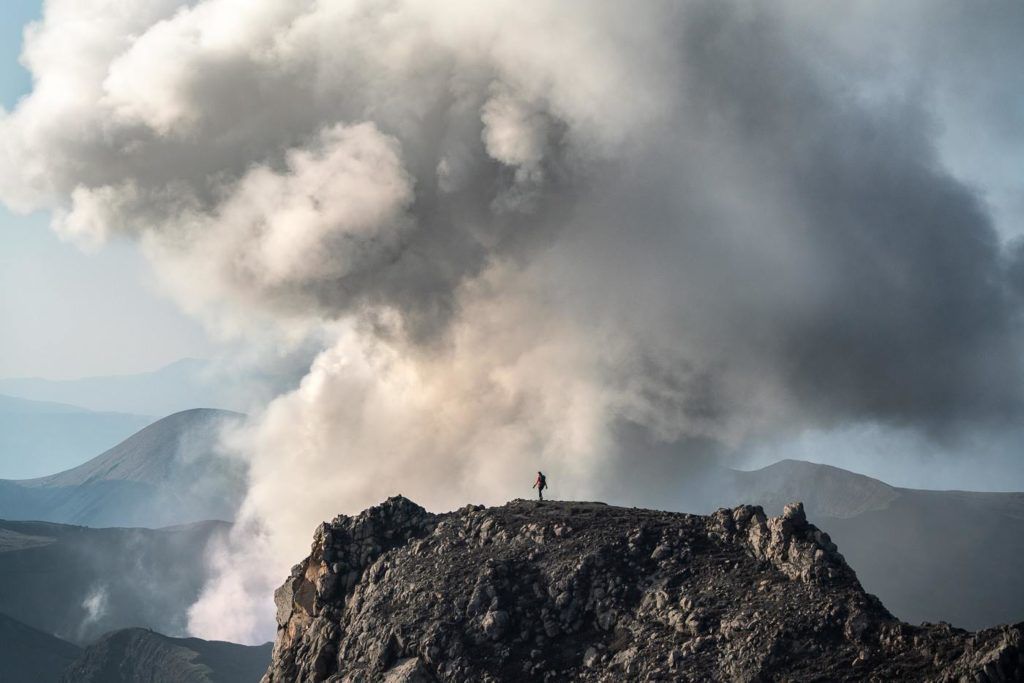
Monday 21st of March 2022
I've hiked, biked and road tripped around Aso several times but I still found several things here that I haven't seen yet and will have to check out this time! Thank you!!
Friday 16th of April 2021
I've been to Kyushu many times but there are still so many places to check out! Beautiful photos, and thanks for giving me a few more ideas. Counting down the seconds until I can get back there again.
Saturday 17th of April 2021
It's such an underrated hiking destination!
Perth Is Ok
Friday 12th of February 2021
kyushu one of the amazing place to visit in Japan. There are many famous places which attract the people around the world. You have mentioned best things to do in Kyushu. Thanks for this blog.
Wednesday 10th of February 2021
I am a photographer and love to explore world with my camera. In 2018 i was there for 15 days tour, and that was my best ever journey, lots of new foods, culture and temples i have seen there, even the language i tried to learn, but failed! Apart from all, i enjoyed a lot. Your article remind old days, Thanks for sharing wonderful post.
Stella Wilson
Wednesday 7th of October 2020
Hi Jackson, Wonderful blog. I really like the way you write. It is one of the best blogs I have read on Kyushu. Thanks for sharing these beautiful photographs. I am travelling to this amazing place in December. Looking forward to reading more of these articles.
- Media & Industry
- Meetings & Events
- Select Language 简体中文 繁體中文(香港) 繁體中文(臺灣) India (English) Bahasa Indonesia 한국어 ภาษาไทย Tiếng Việt Singapore (English) Philippines (English) Malaysia (English) Australia/New Zealand (English) Français Deutsch Italiano Español United Kingdom (English) Nordic countries(English) Canada (English) Canada (Français) United States (English) Mexico (español) Português العربية Japan(日本語) Global (English)
- India (English)
- Bahasa Indonesia
- Singapore (English)
- Philippines (English)
- Malaysia (English)
- Australia/New Zealand (English)
- United Kingdom (English)
- Nordic countries(English)
- Canada (English)
- Canada (Français)
- United States (English)
- Mexico (español)
- Global (English)
- Fujiyoshida
- Shimonoseki
- Ishigaki Island
- Miyako Island
- Kerama Island
- Tokyo Island
- Koka & Shigaraki
- Hida Takayama
- Ginza, Nihonbashi
- Beppu & Yufuin (Onsen)
- Ginzan Onsen
- Nagasaki Islands

- Kumano Kodo
- Shikoku Karst
- Amami Oshima
- Hachimantai
- Omihachiman
- Aizuwakamatsu

- Diving in Japan
- Skiing in Japan
- Seasonal Flowers in Japan
- Sustainable Outdoors
- Off the Beaten Track in Japan
- Scenic Spots
- World Heritage
- Home Stays & Farm Stays

- Japanese Gardens
- Japanese Crafts
- Temple Stays
- Heritage Stays
- Festivals and Events
- Theater in Japan
- Japanese Tea Ceremony
- Cultural Experiences in Japan
- Culture in Japan

- Local Cuisine Eastern Japan
- Local Cuisine Western Japan
- Local Street Food
- Japan's Local Ekiben
- Japanese Whisky
- Vegetarian and Vegan Guide
- Sushi in Japan Guide
- Japanese Sake Breweries

- Art Museums
- Architecture
- Performing Arts
- Art Festivals
- Japanese Anime and Comics
- Japanese Ceramics
- Local Crafts

- Scenic Night Views
- Natural Wonders
- Theme Parks
- Samurai & Ninja
- Iconic Architecture

- Wellness Travel in Japan
- Japanese Ryokan Guide
- A Guide to Stargazing in Japan
- Relaxation in Japan
- Forest Bathing (Shinrin-yoku)

- Experiences in Japan
- Enjoy my Japan
- National Parks
- Japan's Local Treasures
- Japan Heritage
- Snow Like No Other
- Wonder Around Japan

- Visa Information
- Getting to Japan
- Airport Access
- COVID-19: Practical Information for Traveling to Japan
- Anime Tourism
- Countryside Stays
- Accessible Tourism
- Hokkaido Great Outdoors
- Scenic World Heritage in Tohoku
- Shikoku’s Nature and Traditions
- Southern Kyushu by Rail

- Traveling by Rail
- How to Travel by Train and Bus
- JR Rail Passes
- Scenic Railways
- Renting a Car
- Sustainable Travel in Japan
- Travel Brochures
- Useful Apps
- Online Reservation Sites
- Eco-friendly Accommodation
- Luxury Accommodations
- Traveling With a Disability
- Hands-free Travel
- How to Book a Certified Tour Guide
- Volunteer Guides
- Tourist Information Center

- Japanese Manners
- Spring in Japan
- Summer in Japan
- Autumn in Japan
- Winter in Japan
- Cherry Blossom Forecast
- Autumn Leaves Forecast

- Japan Visitor Hotline
- Travel Insurance in Japan
- Japan Safe Travel Information
- Accessibility in Japan
- Vegetarian Guide
- Muslim Travelers
- Safety Tips

- JAPAN Monthly Web Magazine
- Arts & Cultures
- Nature & Outdoor
- Festivals & Events
- Insider Blog
- Things to do
- Local Guides
- Food & drink
- Traditional
- Hokuriku Shinetsu

My Favorites
${v.desc | trunc(25)}
Planning a Trip to Japan?
Share your travel photos with us by hashtagging your images with #visitjapanjp
DESTINATION
Soak up the natural splendor of the four seasons, distinctive hot springs, and a rare history and culture.
- {{ t.name }}
Explore by Interest

Destinations
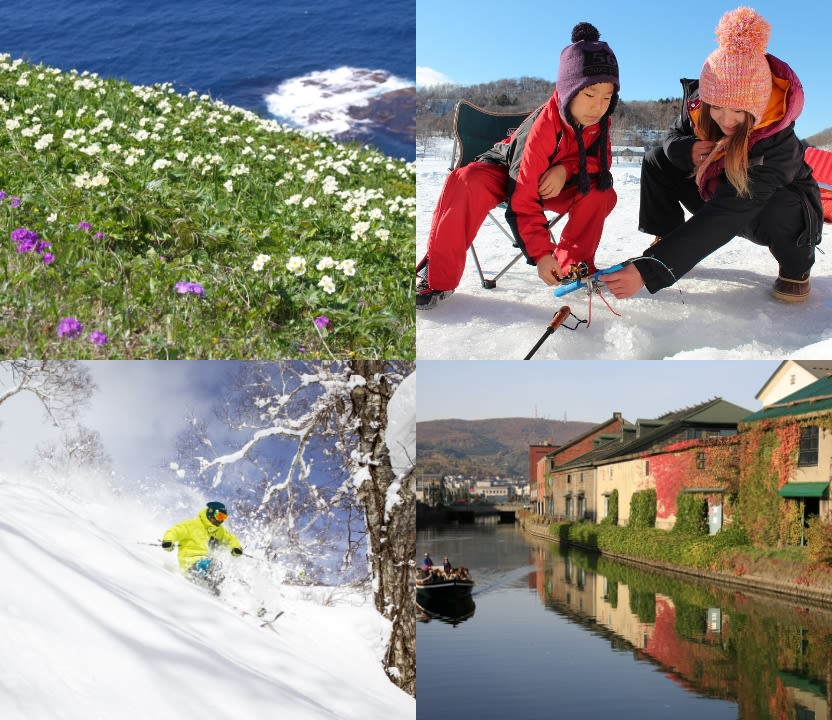
Please Choose Your Language
Browse the JNTO site in one of multiple languages

- PLAN MY TRIP
- All Destinations
- Discover Hokkaido
- Discover Honshu
- Discover Kyushu
- Discover Shikoku
- THINGS TO DO
- Japan Travel Deals
UPDATED! Discover Kyushu
Although it is Japan's third-largest island by size, Kyushu is all too often overlooked or left out of itineraries.
This is a major oversight.
This balmy southern island offers plenty of variety in a compact area, meaning even the shortest of well-planned visits provides ample opportunity to sample some of Japan's natural highlights.
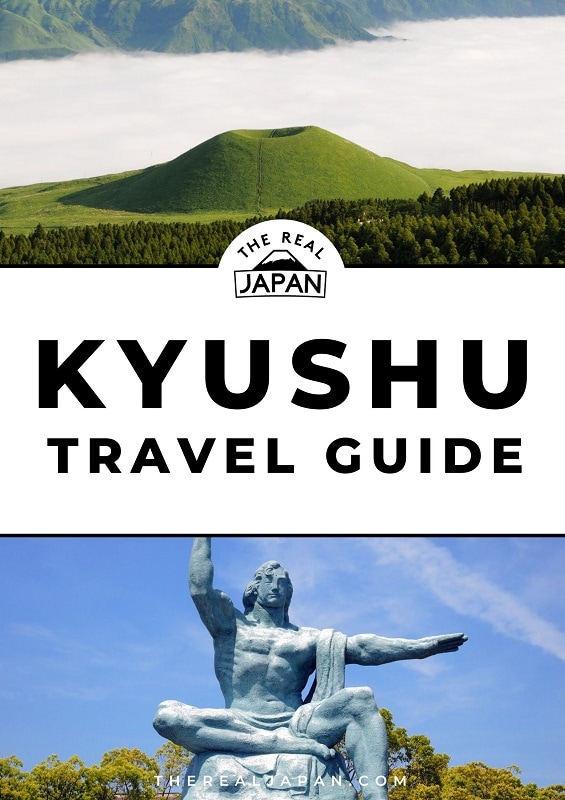
Introducing Kyushu
Kyushu takes its name from the nine kuni, or ancient provinces of the island, that make up its present-day districts.
It has all the natural beauty of Japan: mountains, river valleys, and forests. The more rugged interior terrain offers a variety of great hiking opportunities and abundant wildlife. Spring is a great time to explore the island's mountains, rivers and coastlines. Autumn is ideal for going to those places that have high humidity in the shade of dense tropical foliage somewhere like Yakushima.
SEE ALSO: The Best Time to Visit Japan - All You Need To Know
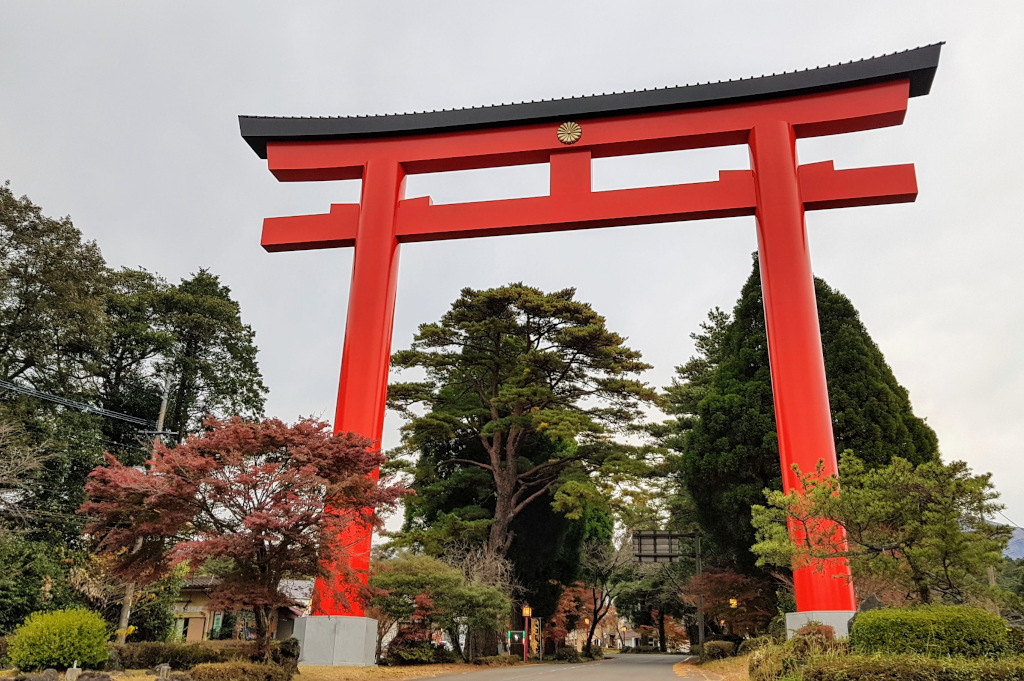
Highlights of Kyushu
Kyushu offers a lot of variety in a relatively compact area. If you want some specific suggestions for a Kyushu itinerary read this post . Otherwise, here's some detail on a few of the highlights the island has to offer...
Fukuoka: A capital city famous for street food
Fukuoka is the capital city of the island and it's here that the shinkansen lines arrive when you're coming from Honshu . If you're looking for a convenient place to base yourself, then Fukuoka is a great place to start .
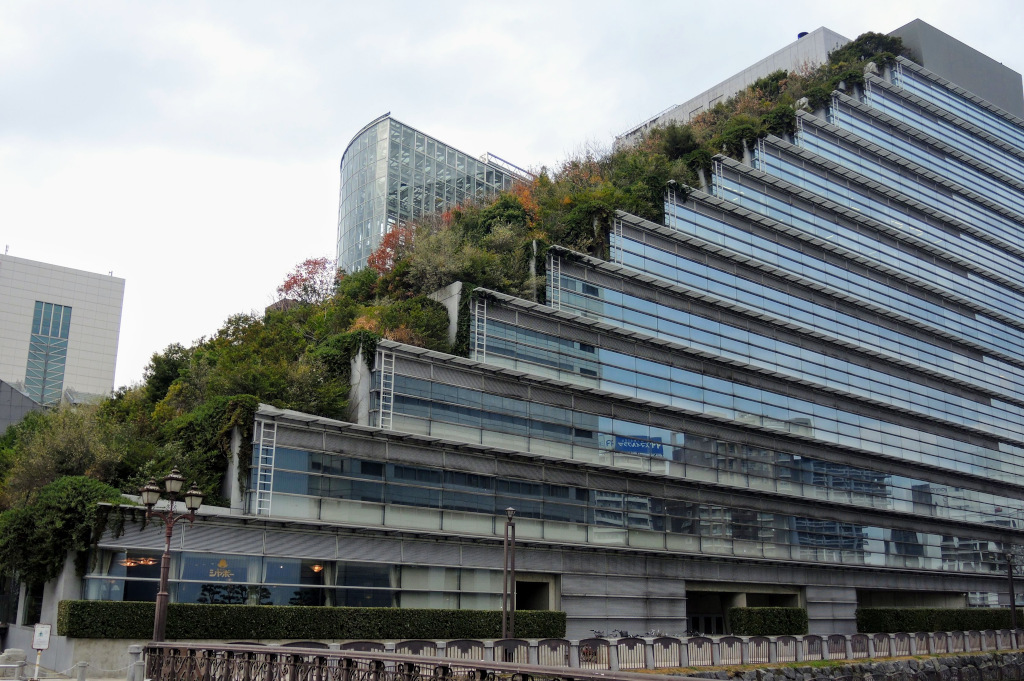
Kyushu Travel Planning
If you want help planning your visit to Kyushu, I have a number of travel planning services, along with a range of Japan travel guides, books and maps available in The Real Japan Travel Store .
If you found this guide helpful, please help spread the word by sharing this photo:
Things To Do In Kyushu
Official tourism websites.
Visit Kyushu Japan National Tourism Organisation (JNTO) Kyushu Guide
Kyushu Airports
Fukuoka Airport (FUK) Kagoshma Airport (KOJ) Kitakyushu Airport (KKJ) Aso Kumamoto Airport (KMJ) Miyazaki Bougainvillea Airport (KMI) Nagasaki Airport (NGS) Oita Airport (OIT) Saga Airport (HSG)
The Best Time To Visit Japan
The Best Time To Visit Japan - All You Need To Know
Japan Island Guides
Discover Japan's Islands
Destinations - Places To Go
Destinations Travel Hub
The Real Japan Travel Store
Have A Question? / Leave A Comment
What a beautiful place and fabulous guide. I would love it for the hiking. Those rugged interiors definitely work for me.
Thanks Ryan. The interior is well worth exploring. Some magnificent landscapes and forests. I think you would love hiking through it indeed!
Kyushu is now on my bucket list. Thanks.
That’s great to hear Bron! Glad to have been of service!
Thank you for the information. Nagasaki is my favorite city on Kyushu as well. In fact it might be my favorite city in all of Japan. Slow paced and very easy and enjoyable to get around. I lived there for about 3 months 45 years ago and it hasn’t changed much. Some of the trams that were very old then are still in operation today. I am glad you highlighted this city. The night view is well worth the visit alone. The fall festival in October (I think) is worth planning around if in Kyushu around that time. I would highly recommend employing Rob to help plan to get the most out of your visit. Also it would be of benefit to read up on the fascinating history of Nagasaki if going to this fascinating city.
Thanks for sharing your thoughts and experiences of Nagasaki Brek. Interesting to hear that you feel it hasn’t much changed since you lived there 45 years ago.
Nice to hear of another fan of the city. I can understand it possibly being your favourite. It certainly has a lot of character about it.
Session expired
Please log in again. The login page will open in a new tab. After logging in you can close it and return to this page.
Privacy Overview
Explore Kyushu

Plan Your Trip to Kyushu: Best of Kyushu Tourism
Essential kyushu.
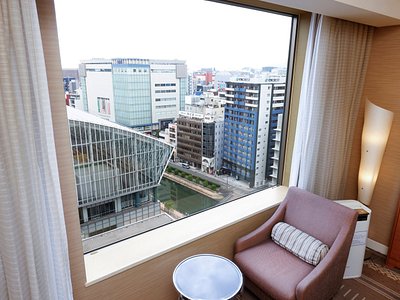
Trending in the forums

Kyushu Is Great For
Cultural tours.

Historical Tours

Eat & drink

- Aso-Kuju National Park
- Unzen-Amakusa National Park
- Orange Restaurant
- Kyushu Shinkansen
Perfect 10 Day Itinerary For Your Kyushu Trip
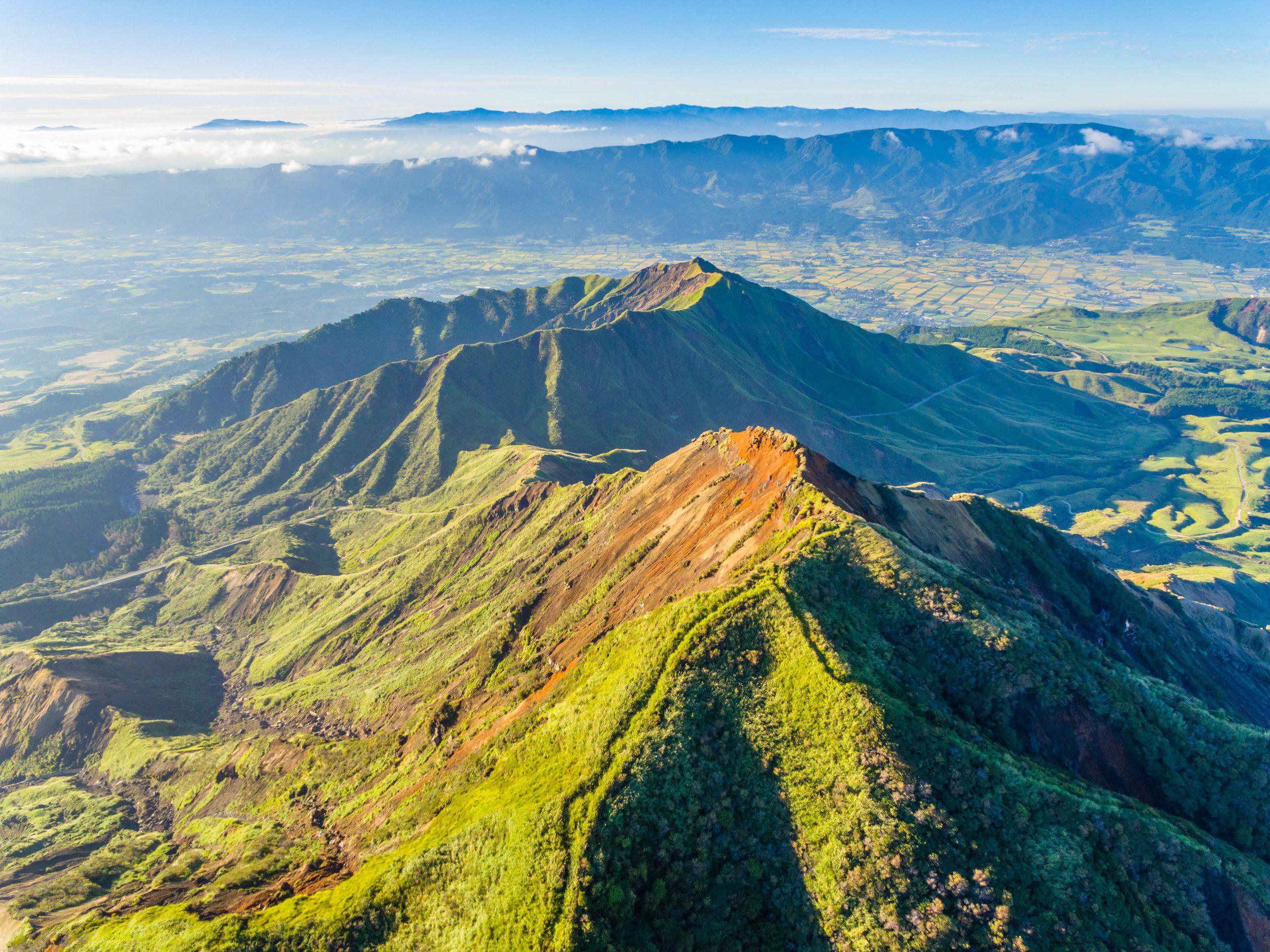
Kyushu is a natural paradise that offers many historic treasures, modern cities, and natural beauty. The southernmost of the main islands of Japan is known for its rich rugged landscape, volcanic scenery, vibrant cities, stunning hikes, and delicious ramen. Kyushu translates as nine provinces but is surprisingly formed by seven prefectures. The land of volcanoes also has a large number of high-quality (natural) hot springs dotted all over the island and Kyushu is often dubbed onsen island. Despite all of its beauty, Kyushu is an underrated paradise that isn’t frequently included on the itinerary by (international) tourists. All the more reason to travel to Kyushu! Here we will provide you with a ready-made itinerary to see some of the best places to visit in Kyushu . The itinerary is somewhat fast-paced so that you can cover the most popular spots and get to all the iconic places in 10 days. We also included some optional day trips for you to consider. As this schedule serves as an inspiration for your perfect trip to Kyushu, you can choose to leave out places or change the timing.

The best time to visit Kyushu
How to get to kyushu and around, day 1: fukuoka , day 2: fukuoka – saga – nagasaki , day 3: nagasaki – shimabara – kumamoto, day 4: kumamoto – kagoshima , day 5: kagoshima – yakushima , day 6: yakushima – kagoshima, day 7: kagoshima – kirishima , day 8: kirishima – takachiho, day 9: takachiho – mount aso, day 9: kurokawa – yufuin, tour packages, blogs you might also enjoy.
Kyushu has a comfortable climate all year round, but we recommend traveling in either spring or autumn. The winter is mild so you won’t see any snow, but it is still fairly cold at that time of the year. Summers in Kyushu are hot and humid and summer sees more rain than other regions in Japan.
Spring is definitely the most popular season to travel to Kyushu with sunny days and comfortable temperatures. The weather is perfect for all the outdoor activities and hiking that Kyushu is known for. It is also very popular at this time due to the cherry blossoms and flowers that are in full swing at this time of year.
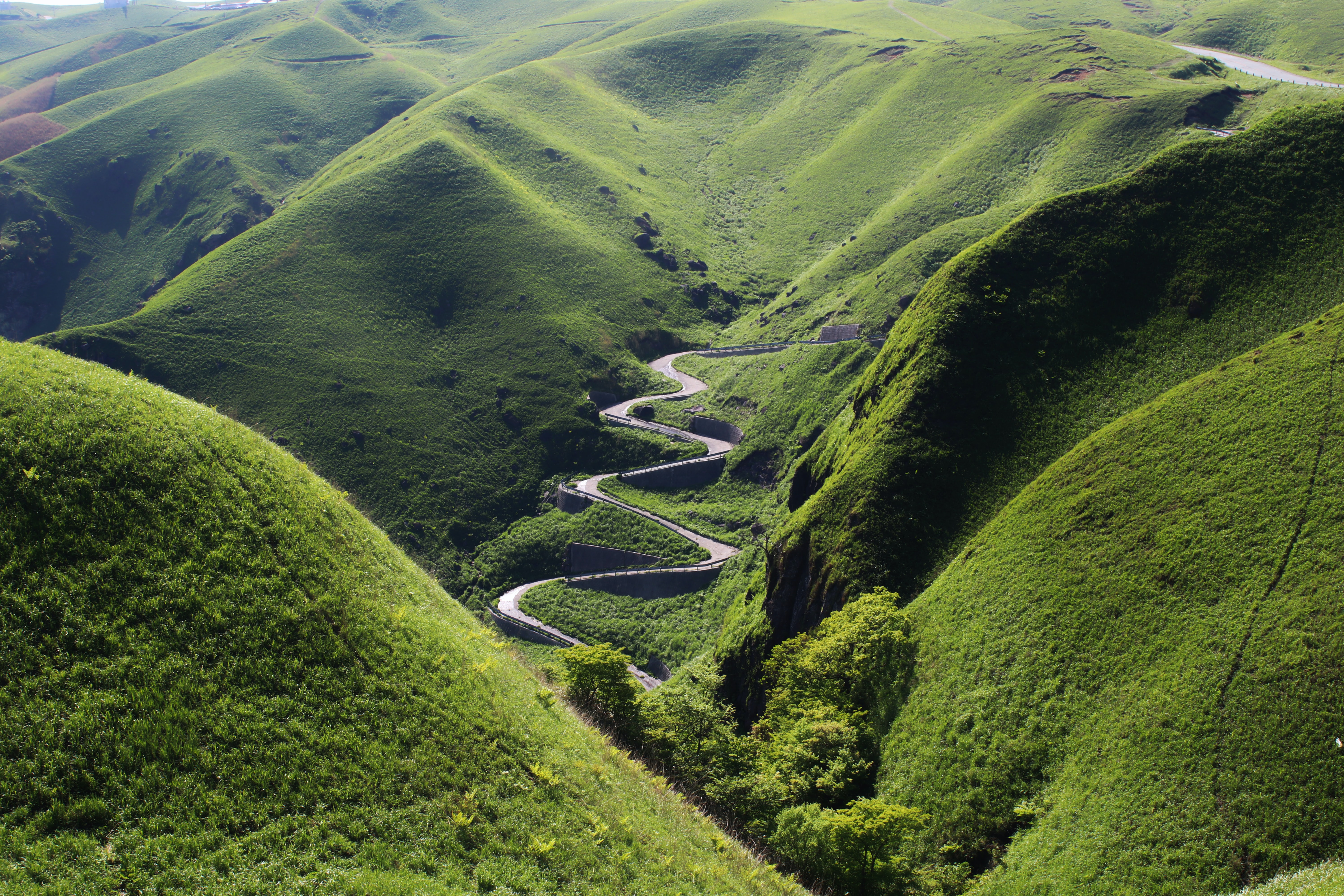
Most travelers will access Kyushu via Fukuoka , riding Japan’s famous shinkansen or boarding a flight to the well-connected airport of Fukuoka. But the island is home to a number of airports for example in Kagoshima , Nagasaki and Oita .
Kyushu has an extensive network of trains and buses within the major cities, connecting the seven prefectures on the island of Kyushu. The region is popular for its scenic trains such as the Yufuin no Mori and Kawasemi Yamasemi , along the coastline and crossing the mountainscape. The Japan Rail Pass (JR Pass) is also valid on most JR trains.
However, especially the more distant areas are easier to reach by car. With many breathtaking country roads, driving is the ideal way to explore Kyushu. Popular routes for a scenic road trip include the Nichinan coast road in Miyazaki, the Trans Kyushu Route, and the Aso Panorama Line in Kumamoto. We recommend exploring Kyushu by car as it will give you much more freedom and flexibility. You can find car rental agencies at airports and major stations.
The JR Kyushu Rail Pass is available for internationals and includes travel in the chosen area on the following JR trains:
- Local trains
- Limited express trains
- Shinkansen *Shinkansen between Kokura and Fukuoka, subways, buses or private railways are not applicable.
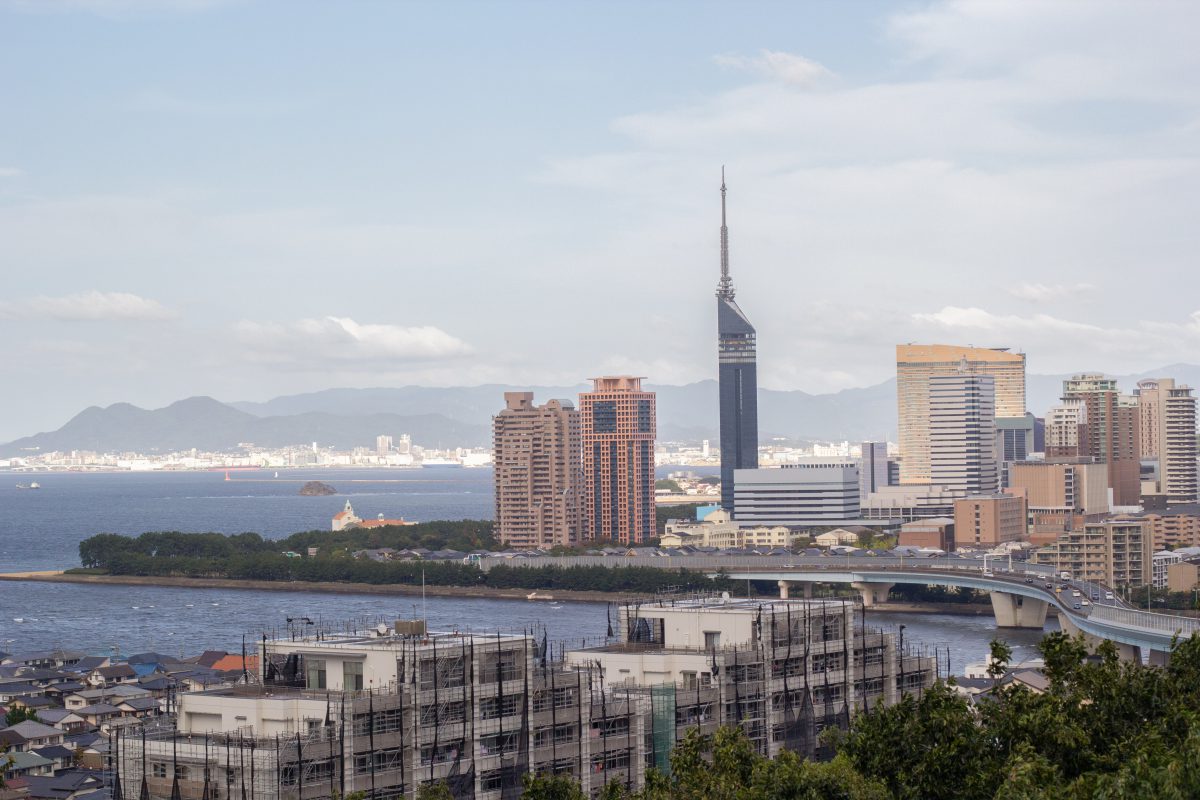
Kyushu’s largest and most vibrant city is Fukuoka ( 福岡 ), a great place to start your trip. The old castle town is located along Hakata Bay , which made it a favorable base for international trade. The city was first known as Hakata, but was renamed Fukuoka in the 17th century. We suggest you use this first day to discover the port city, Fukuoka is home to a number of top-notch shopping facilities and historically important temples and shrines such as Kushida-jinja Shrine and the Dazaifu Tenmangu shrine . Fukuoka’s castle was destroyed completely after the Meiji Restoration as it was seen as an unwanted symbol of the past, but the ruins and the bordering Maizuru Park are a very popular sakura viewing spot in Fukuoka . You cannot leave Fukuoka without trying the famous Hakata Ramen from one of the food stalls called yatai .
▼ And don’t miss out on the final Sumo Tournament in Fukuoka in November! Book your tickets by clicking the Link below and get a professional guide that will give you essential background information to enjoy the experience to the fullest .
▼ Fukuoka 1-Day Highlight Private Walking Tour (7 Hours) Book a guided private walking tour in Fukuoka to explore the highlights of Fukuoka including Dazaifu Tenmangu shrine, Kushida Shrine, and other unique spots that only locals know!
Both the drive and the train ride from Fukuoka to Nagasaki (長崎) will take you about 2 hours when traveling directly. You might want to take a detour and make some stops along the road in Saga prefecture , a small prefecture famous for Japanese traditional ceramics. Especially Arita and Imari are famous pottery villages . Start the day (very) early and catch the sunrise at Hamanoura Rice Terraces Lookout (浜野浦の棚田展望台) or enjoy the onsen facilities in Takeo Onsen (武雄温泉), a hot spring resort with over 1,300 years of history.
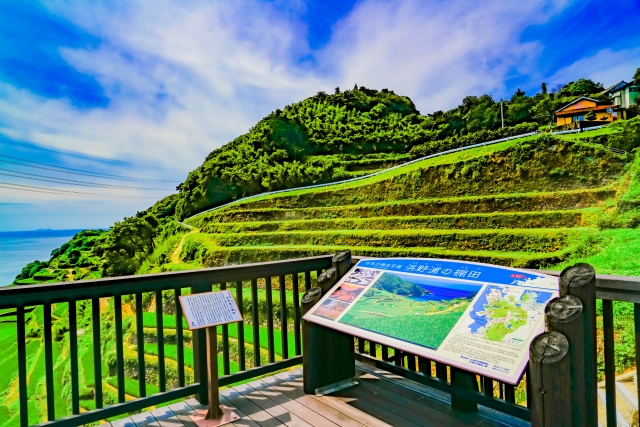
Nagasaki is widely known for two events in history ; it was the location of the second atomic bomb dropping and Nagasaki was the most important port where a restricted number of foreign traders were allowed during the period of isolation between the 17th and 19th centuries, known as the Sakoku period.
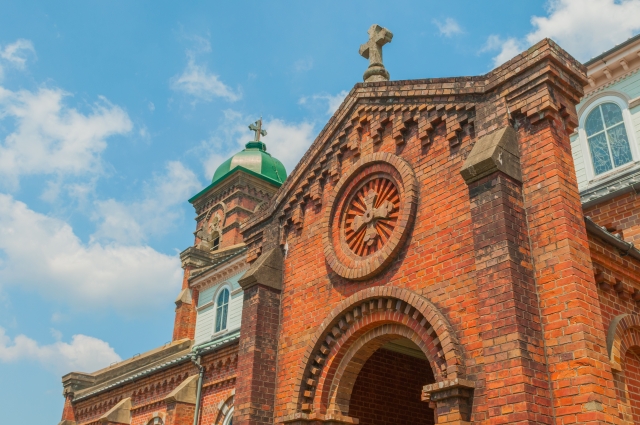
Depending upon the time of your arrival we recommend heading up to Mount Inasa for a spectacular view over Nagasaki. Nagasaki has a lot to offer, and the impressive night scenery that can be seen from Mount Inasa Observatory is one of them. When visiting Nagasaki, make sure to spend some time at the Nagasaki Peace Park where the victims of the second atomic bomb are commemorated. On August 9, 1945, Nagasaki became the second city that was destroyed by an atomic bomb, after Hiroshima. Another interesting place to visit in Nagasaki is Clover Garden , an open-air museum that showcases several beautiful mansions of the foreigners who lived in the city after the period of isolation. Or head to Dejima (出島), an artificial island that used to be Japan’s window to the world during that same period of isolation.
Right off Nagasaki’s coast, the abandoned island of Gunkanjima (軍艦島) makes for an interesting half-day trip. The small island served as an important coal mine until 1974 and can now be visited with a sightseeing tour.
▶ Make sure to book a tour to enter the Gunkanjima beforehand
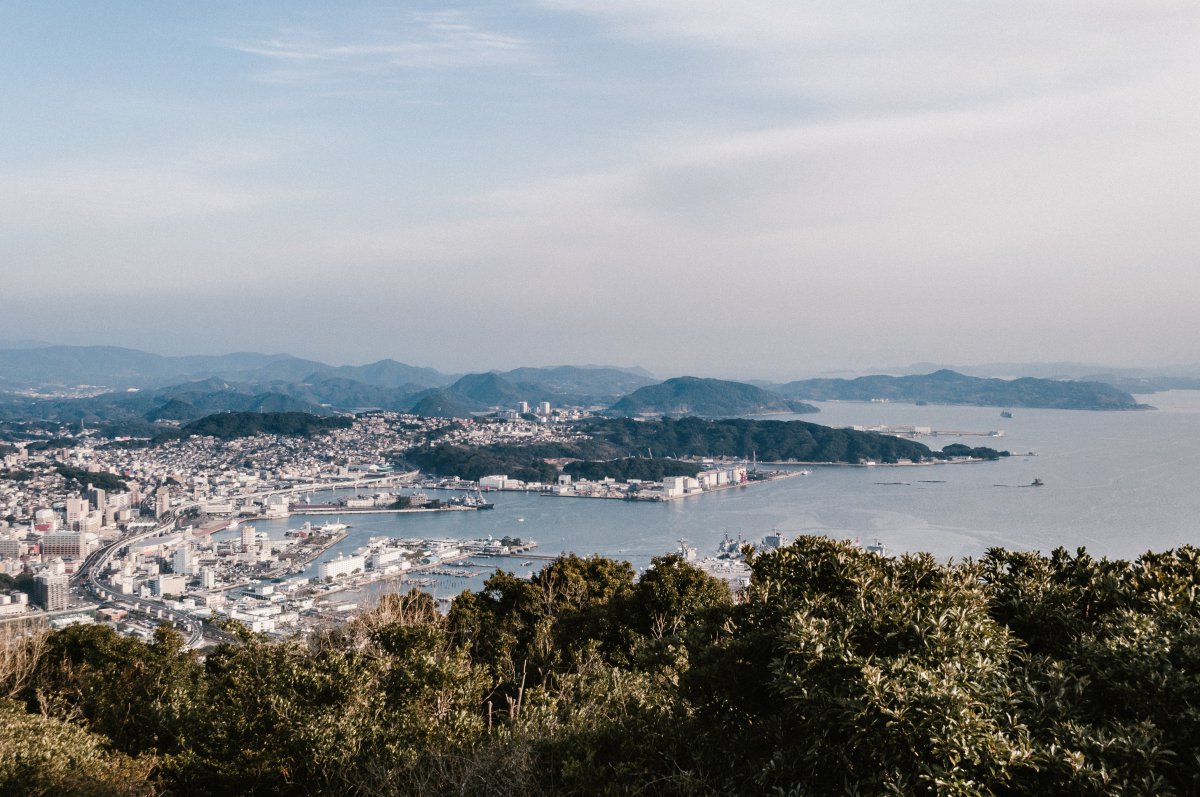
On the third day make your way from Nagasaki to Shimabara (島原), this should take about 1.5-2 hrs by car or train. Shimabara Peninsula (島原半島) is a popular hot spring and hiking destination, with Mount Unzen (雲仙岳) and Unzen Onsen (雲仙温泉) at the center. Mount Unzen is one of Japan’s most active volcanoes and has erupted several times in the last centuries. Its most recent eruption was in 1991 when 43 people were killed. Near the top of Mount Unzen, Unzen Onsen is a hot spring resort surrounded by several hot spring fields.
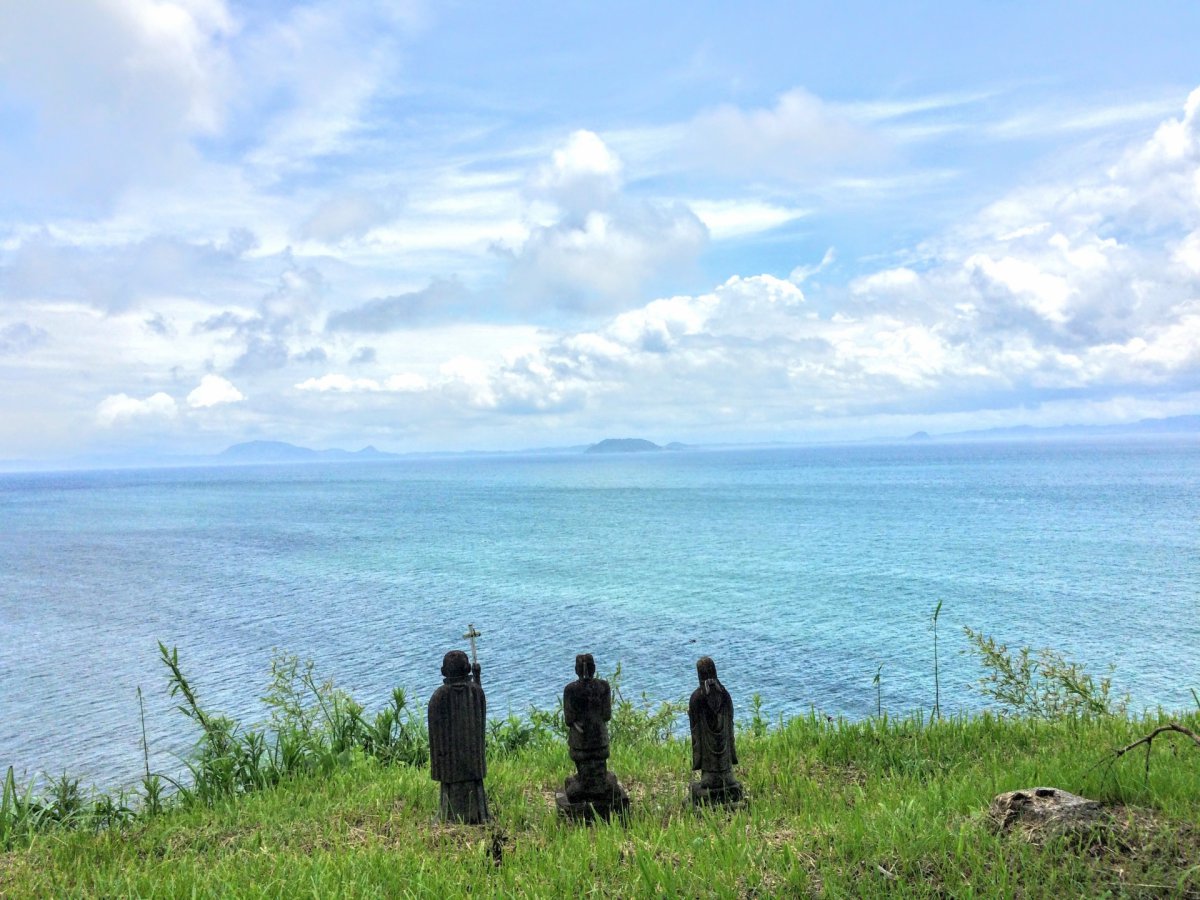
From Shimabara Port, catch the ferry to Kumamoto Port . From November to March, seagull feeding is available on the 60-minute ferry ride. Cars are allowed on board, but it is best to make a reservation (which can be made up to one month in advance).
Kumamoto (熊本) is the capital city of the namesake prefecture and is rich in history, with sites such as Kumamoto Castle , built over 400 years ago and considered one of the three most magnificent castles in Japan . Kumamoto is highly praised by nature lovers, blessed with breathtaking scenery and many hot springs . It is also called the land of water with hot spring water flowing from more than 1,000 locations across the prefecture.

Spend the morning exploring some more of Kumamoto, visit for example the Suizenji Garden , a beautiful serene Japanese garden. For lunch, have some Kumamoto Ramen , this local variant of the famous Japanese comfort food is characterized by mild tonkotsu soup , made rich in flavor with the addition of chicken bones mixed with garlic oil or chips.
Around midday make your way to Kagoshima (鹿児島), also known as the Naples of Japan for its bayside location and towering active stratovolcano Sakurajima ( 桜島 ). Stay overnight in Kagoshima for example at the Shiroyama Mountain Hotel , located on top of the hill and with hot spring baths overlooking Sakurajima volcano and the sea.
This guided tour will help you to explore all the highlights of Kyushu’s Kagoshima in a day tour , it’s highly recommended if you have a limited time or want to discover the city with a local guide.
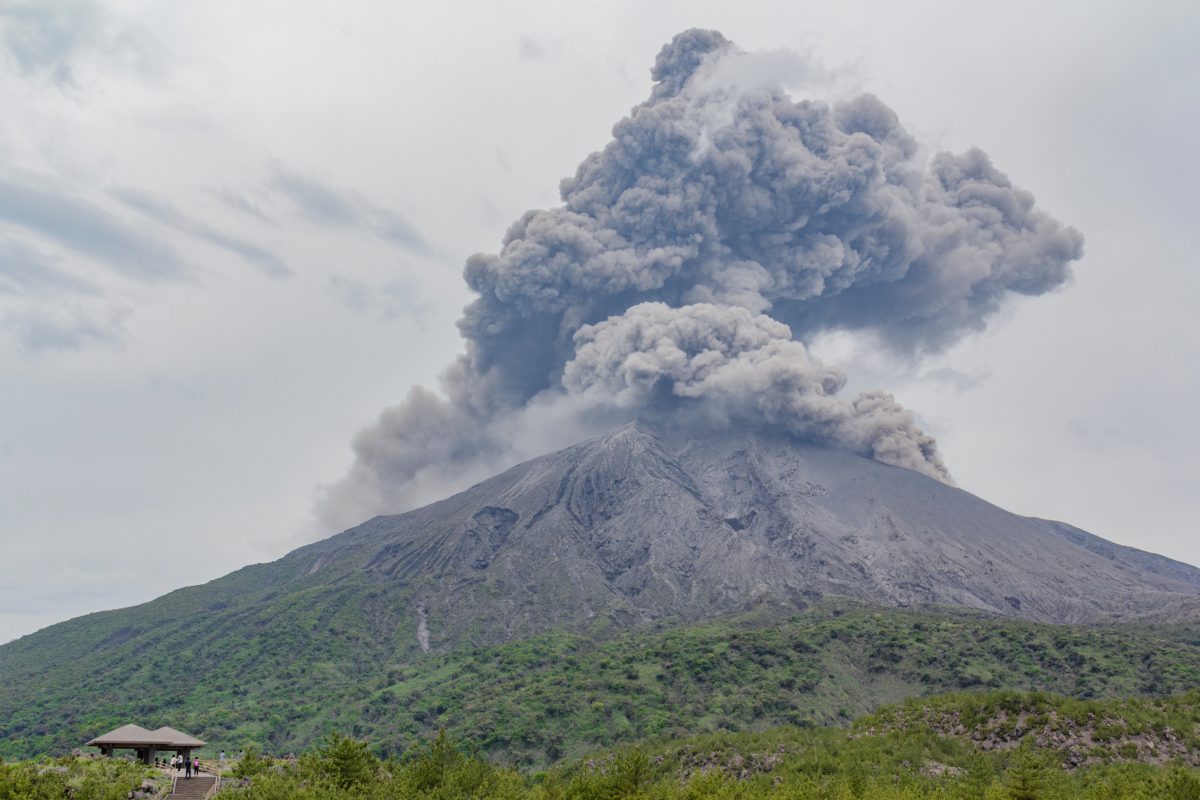
In the morning, board the ferry from Kagoshima to Yakushima (屋久島), a true nature lover’s paradise that served as an inspiration for Ghibli’s famous Princess Mononoke’s film . The small island of Yakushima is located about 60 km off the coast of Kagoshima and is famous for its towering mountains, its ancient cedar forest – Jomonsugi (縄文杉) is a giant cedar tree which is estimated to be 2000 to 7200 years old – and many well-marked hiking options. Much of the island is a designated UNESCO World Heritage Site .
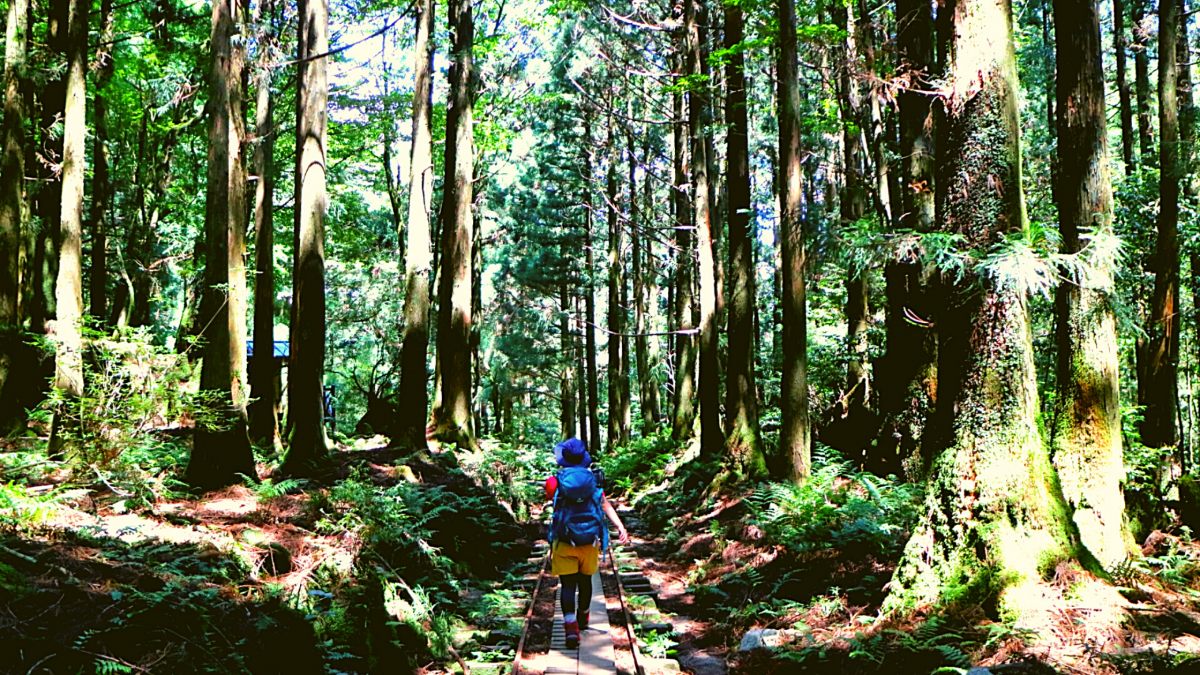
Enter the land of Princess Mononoke and pick one of the several hiking routes of Yakushima. We recommend visiting the Shiratani Unsuikyo (白谷雲水峡 ) where you have the option of several trails ranging from a 1 hr to a 6hr walk.
The island is quite small and it’s possible to access all of Yakushima’s main sights by bus, though service is infrequent. The best way to explore Yakushima at your own pace is by car. Cars can be rented on the island, and it is also possible to bring your car from Kagoshima with the car ferry .
Recommended tour: Yakusugi Cedar Forest Walking Tour on Yakushima Island
Spent the entire day exploring the island before taking back the ferry to Kagoshima. Admire mesmerizing waterfalls like Okonotaki , Senpiro, and Janokuchi , or the historical Yaku Shrine . One of the highlights of the island is the natural hot spring bathing pools formed from ocean rocks along the coast of the Sea of Japan. Bear in mind that the last ferry to Kagoshima departs from Yakushima at 4pm.

After waking up in Kagoshima the next morning, explore the city a bit more and transfer to Kirishima (霧島). The area of Kirishima consists of volcanic mountains, highlands, hot springs and volcanic lakes and it was the first to be designated as a national park in Japan in 1934. The absolutely breathtaking scenery is a feast for the eyes and the mountains offer a wide range of hiking courses suitable for both beginners and more experienced hikers. Nearby Ebino Kogen (えびの高原) and Kirishima Onsen (霧島温泉) are the two best hot spring towns in the Kirishima area. We recommend staying overnight in Kirishima Onsen, one of Japan’s best hot spring resorts with high-quality sulfuric water. You can also opt for staying in Ebino Kogen, an epic place to see the autumn colored leaves and the starting point of several hiking trails. Kirishima Mountain is also an important site in Japanese mythology and home to a large beautiful shrine; Kirishima Shrine is an impressive ancient shrine said to be built in the 6th century!
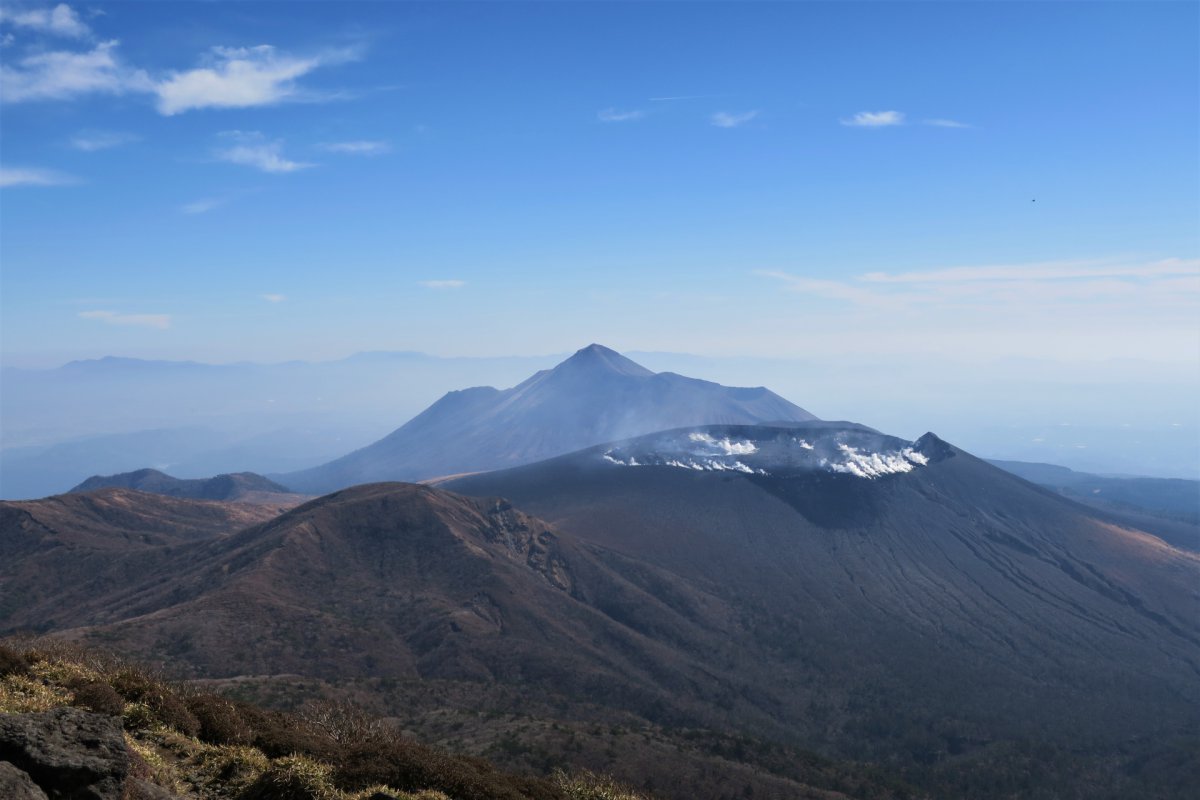
The trip from Kirishima to Takachiho (高千穂) takes about 3~3.5 hrs by car without any stops. Depending on your preference you can either do some more hiking in Kirishima or you can also decide to take a slightly longer route and drive along the coastline of Miyazaki (宮崎市), a beautiful scenic drive. In the south, the Nichinan Coastline is known as one of Japan’s best road trips, with beaches, great surfing spots and the stone giants of Sun Messe Nichinan along the way.

In northern Miyazaki you’ll find one of Japan’s most beautiful nature spots : Takachiho Gorge (高千穂峡). The stunning V-shaped gorge was formed from lava from Mount Aso (阿蘇山) which over time eroded to create 80-100m high volcanic cliffs. This place has appeared in Japanese mythology and is known as a power spot filled with spiritual energy. The gorge can be enjoyed in two ways; from above (the cliffs) and below while rowing down the river. Follow the trail that leads you to the observatory deck in front of the Manai Waterfalls .
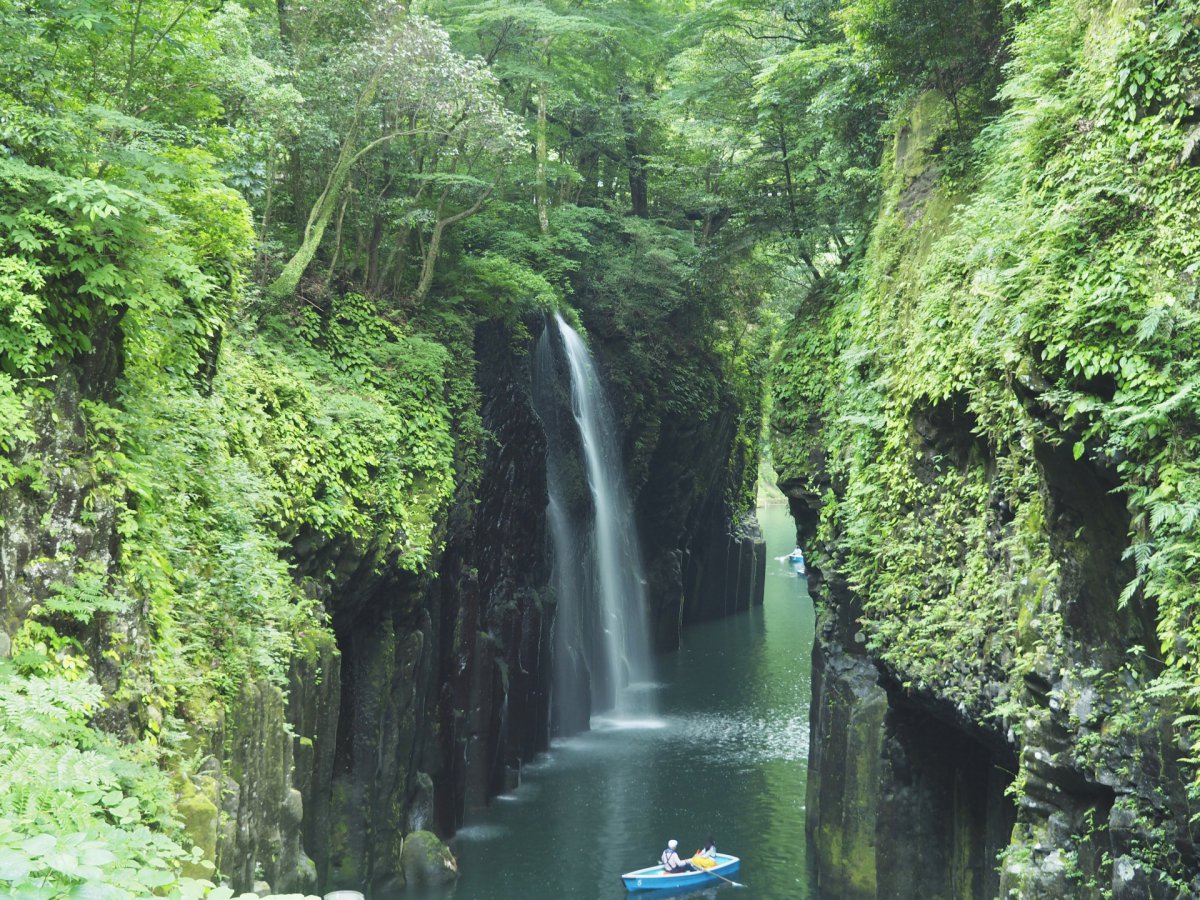
Overnight in Takachiho and see a traditional Japanese dance performance, held every evening at 8pm on the grounds of Takachiho shrine.
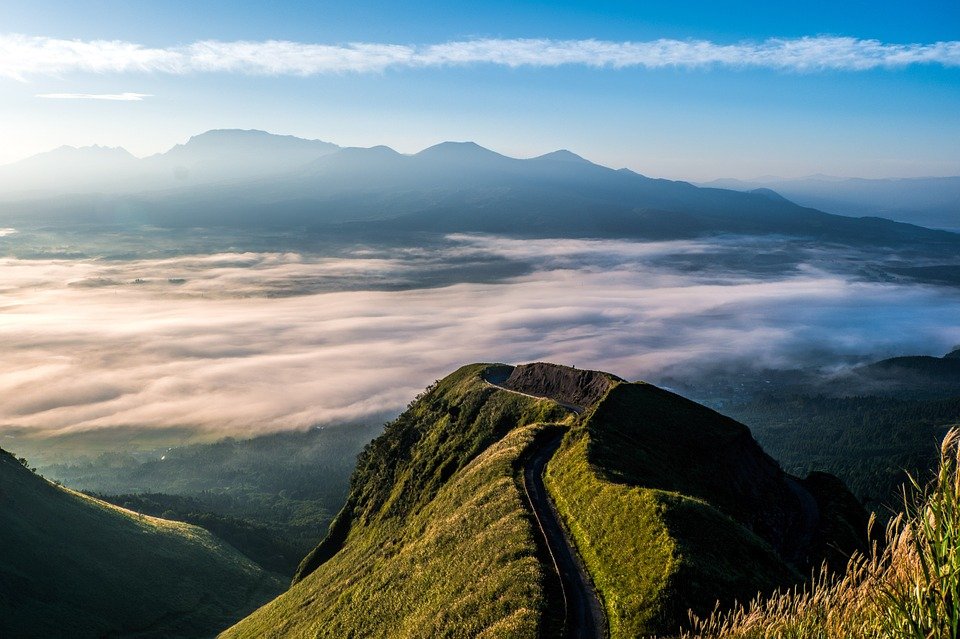
Wake up early and watch a magnificent sunrise at the nearby mountain peak called Kunimigaoka (国見ヶ丘), known for Japan’s famous unkai or sea of clouds . After one of the best sunrise views over the rice fields and Takachiho Valley, continue north and make your way to Mount Aso . But before visiting Japan’s largest active volcano, take a small detour and make a stop at the picturesque Kamishikimi Kumanoimasu Shrine . The path leading up to the shrine is lined with numerous stone lanterns, and it is worth the trip, even if you’re not a fan of shrines. The shrine is famous for being the setting of a popular anime and manga comic Hotarubi no Mori e (Into the Forest of Fireflies).
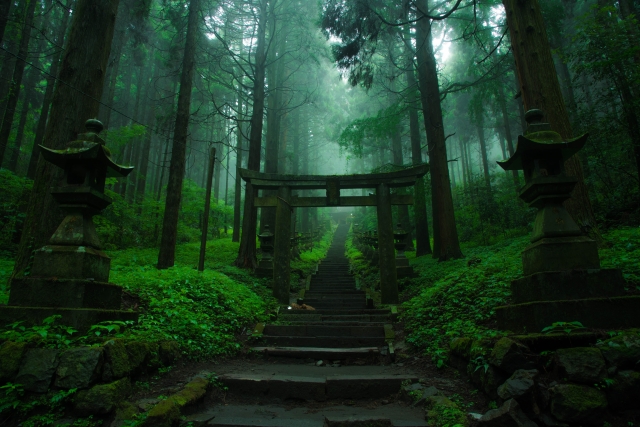
Mount Aso is one of the largest calderas in the entire world, spanning 17 kilometers from east to west and 25 kilometers from south to north with a total area of 350 square kilometers. Standing at 1592 meters above sea level and boasting five soaring peaks, Mount Aso is a must-visit for anyone visiting Kyushu. Hiking the Mount Aso region is one of the most incredible adventures you can have in Japan! It is possible to drive to the top of Mount Nakadake (中岳), or you walk in about 30 minutes to the summit. Alternatively, you can also take the ropeway around Mt. Aso and ride the plains created by the magma below the mountain. From the parking or the ropeway station, there are a number of hiking trails to explore Mount Aso . Always check the current status of the area before you go as the volcano is still active and often closed. To find out the current restrictions in place you check the official website .
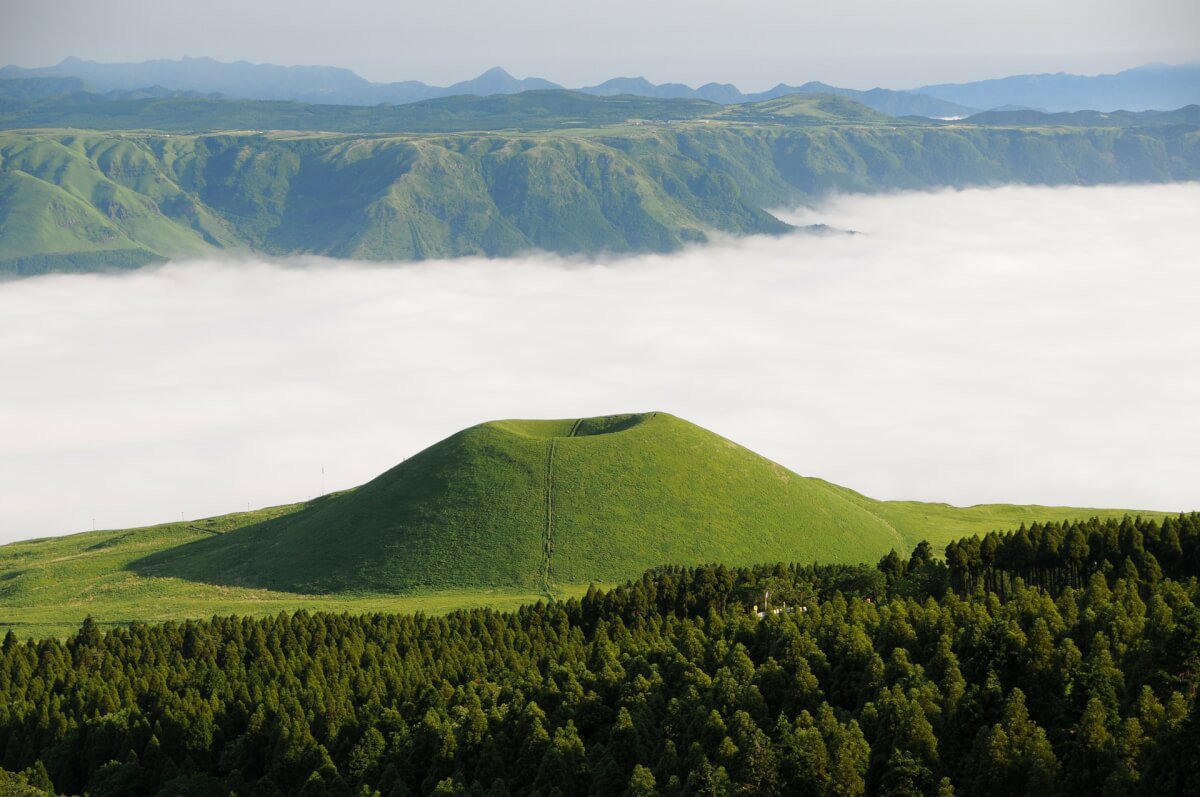
After taking in the breathtaking volcanic scenery of Mount Aso, make your way to Kurokawa Onsen (黒川温泉), a secluded onsen town up in the Aso mountain range. Kurokawa Onsen has managed to maintain the traditional atmosphere with ryokan and public bathhouses dominating the townscape. The charming town is home to a number of ryokan baths and public baths and visitors can purchase a tegata for ¥1,300 that offers access to any three of the participating onsen. Stroll around in your yukata and wooden sandals and relax after a long day of exploration.
After Kurokawa Onsen the next destination on the list is Yufuin (由布院), a popular onsen resort town in Oita Prefecture . You have two options of getting there by car and we recommend taking the road passing the Kuji Mountain (九重山) range along the way. The mountains are located along the scenic drive Yamanami Highway.
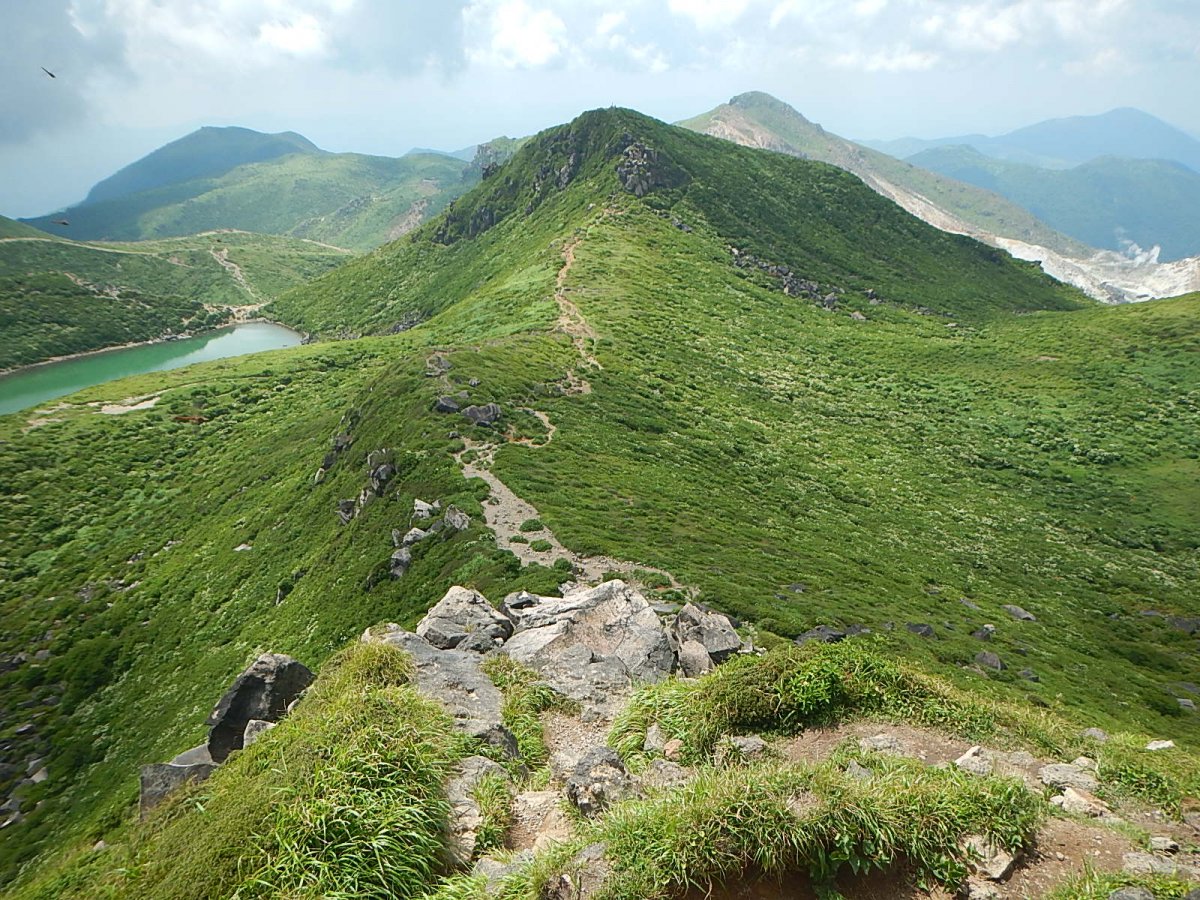
The natural hot springs of Yufuin are a must-try of course and there are several public baths that can be used by visitors like Tsuka no Ma, Baien and Musoen . Some of the baths are gender separated whereas others are mixed. Yufuin is located on a flat river basin nestled in a mountainous valley, with scenic views of Mount Yufu , a volcano that stands 1.83 meters tall, from nearly every place in town. Along the main street, you will find many souvenir shops, cafes and small art museums, creating a lively atmosphere. Most of the public baths and ryokan are scattered around the town and many visitors come to visit for just the day. Staying overnight will offer you the opportunity to enjoy the natural hot spring and the second no other place views. Because there are many mountains surrounding Yufuin, there are also plenty of hiking trails with easy access from the town. For example, this day trip hiking to the summit of Mount Yufu , takes about 4-5 hours to complete. On a clear day, the views are guaranteed jaw-dropping.
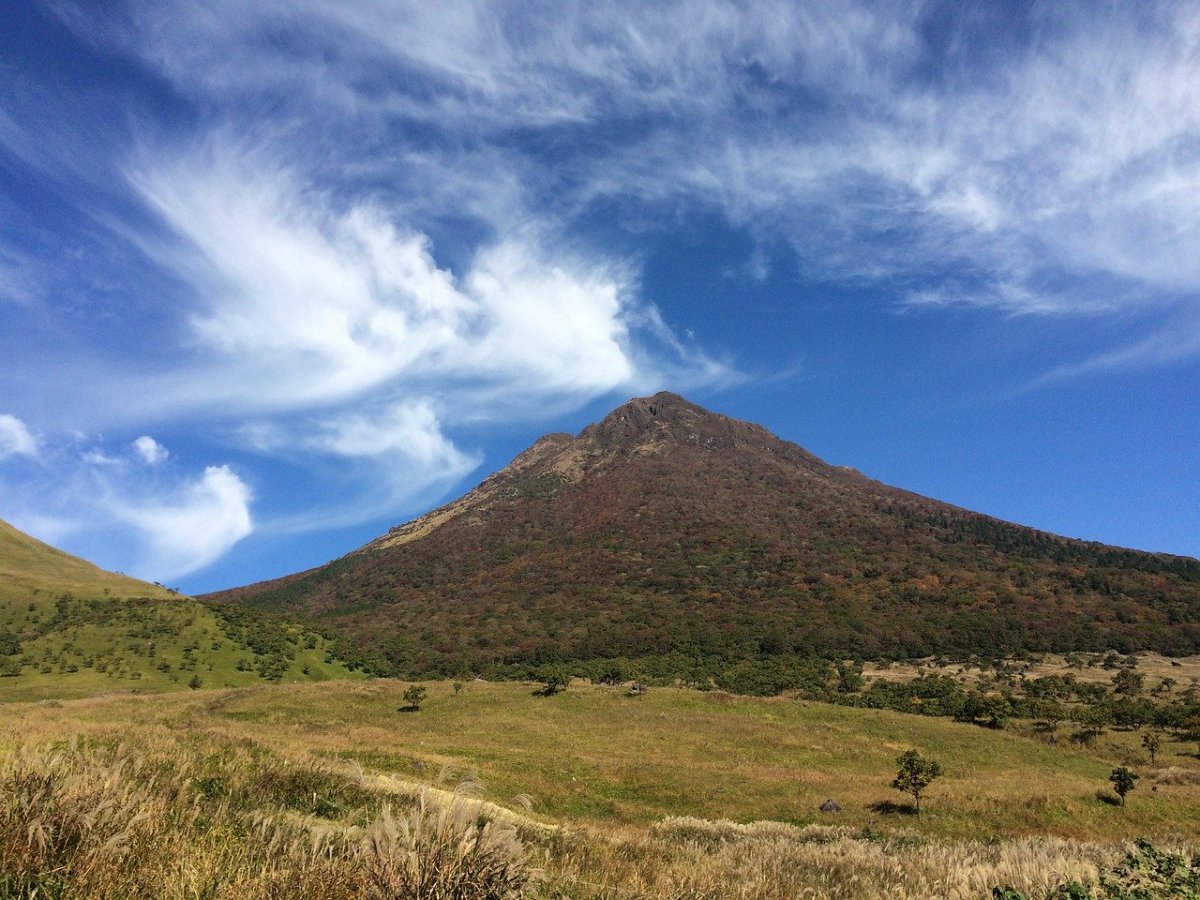
Another highlight nearby is Lake Kinrin at the base of Mt. Yufu. The small lake is located at the end of the main walking route of Yufuin. There is a small shrine located on the southern shore and there are charming little cafes and shops selling local specialties.
We recommend staying at the traditional ryokan, Yufuin Iyotomi . The ryokan has indoor cypress baths and a large outdoor bath (rotenburo).
Day 10: Beppu – Oita
Situated at the heart of Oita Prefecture , Beppu (別府) is one of Japan’s most popular hot spring resorts. The area produces the greatest amount of thermal water from natural hot springs in the world. You can’t miss it, there is steam rising into the air everywhere in Beppu. There is a wide range of baths to be enjoyed, from normal hot water baths to mud baths, sand baths and steam baths, Beppu offers it all.
In addition, the Hells of Beppu (地獄, jigoku) are a must-visit when you’re in the area. The hells of Beppu are seven incredible hot springs created by volcanic activity more than 30,000 years ago. These hot springs are for viewing rather than bathing as they are far too hot; the temperature reaches up to 100 degrees Celsius. The most beautiful hell is Umi Jigoku , or Sea Hell, a pond of boiling milky blue water, shrouded in steam. The grounds also feature a large garden and a few smaller, orange-colored hells. Chinoike Jigoku or Blood Pond Hell is another spectacular hell with bright red water, thanks to the high levels of iron and magnesium in the water.

Onbara (乙原の滝) is a hidden gem near Beppu where you can enjoy a short trek passing the epic waterfall of Onbara Falls. There are several beautiful waterfalls in the area around Beppu, but Onbara Falls is the most beautiful and accessible. There is a short, well-marked trail with a dirt/rock path leading you up to the falls. Start your day with a beautiful little walk, the trail is only about a 2km return and refresh at one of the many natural hot springs after.
We recommend you also visit the Beppu Sand Bath (別府海浜砂湯) where you don’t bathe in hot water, but in hot sand instead! Being buried in the hot volcanic sand is a healthy and relaxing experience.
From Beppu you have the option of flying to your next destination using Oita Airport (大分空港). If you are continuing tour trip from Fukuoka, we highly recommend taking the Yufuin no More train to Fukuoka . The sightseeing train is a popular train ride to take and gives you some amazing views of both prefectures on the way.
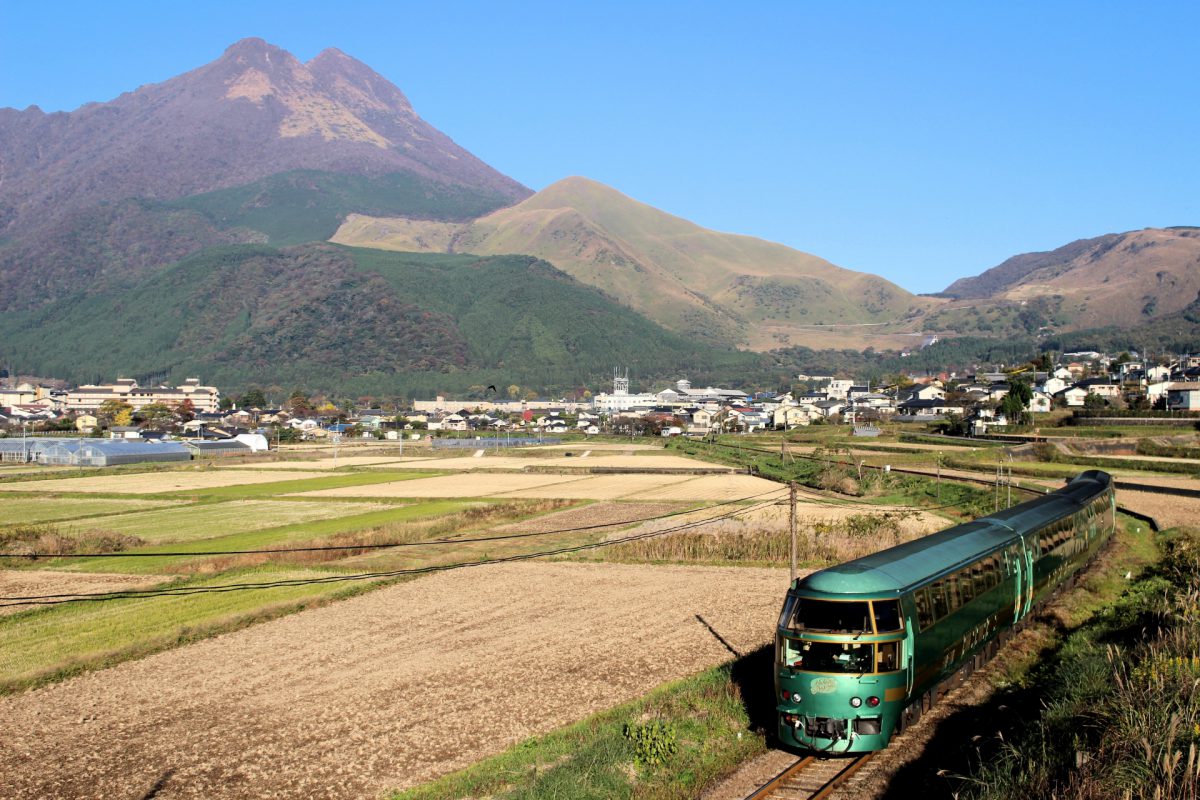
With this 10 day itinerary, you will visit many of the highlights of Kyushu. We recommend you to self-drive, as public transportation is limited especially in the more rural parts including Kirishima and Takachiho Gorge. A car offers you the freedom to visit the tourist hotspots of Kyushu in a short amount of time. This ready-to-use Kyushu itinerary serves as an example of the ultimate Kyushu trip, of course, you can extend this itinerary and stay longer at some places or add other places from your wishlist.
Follow us on Instagram , Facebook and Twitter for more travel inspiration. Or tag us to get featured!
Happy traveling!
If you want to make travel easier, click here to find the best tour package from various operators!

This post may contain some affiliate links. When you click through and make a purchase we may receive some commission, at no extra costs to you
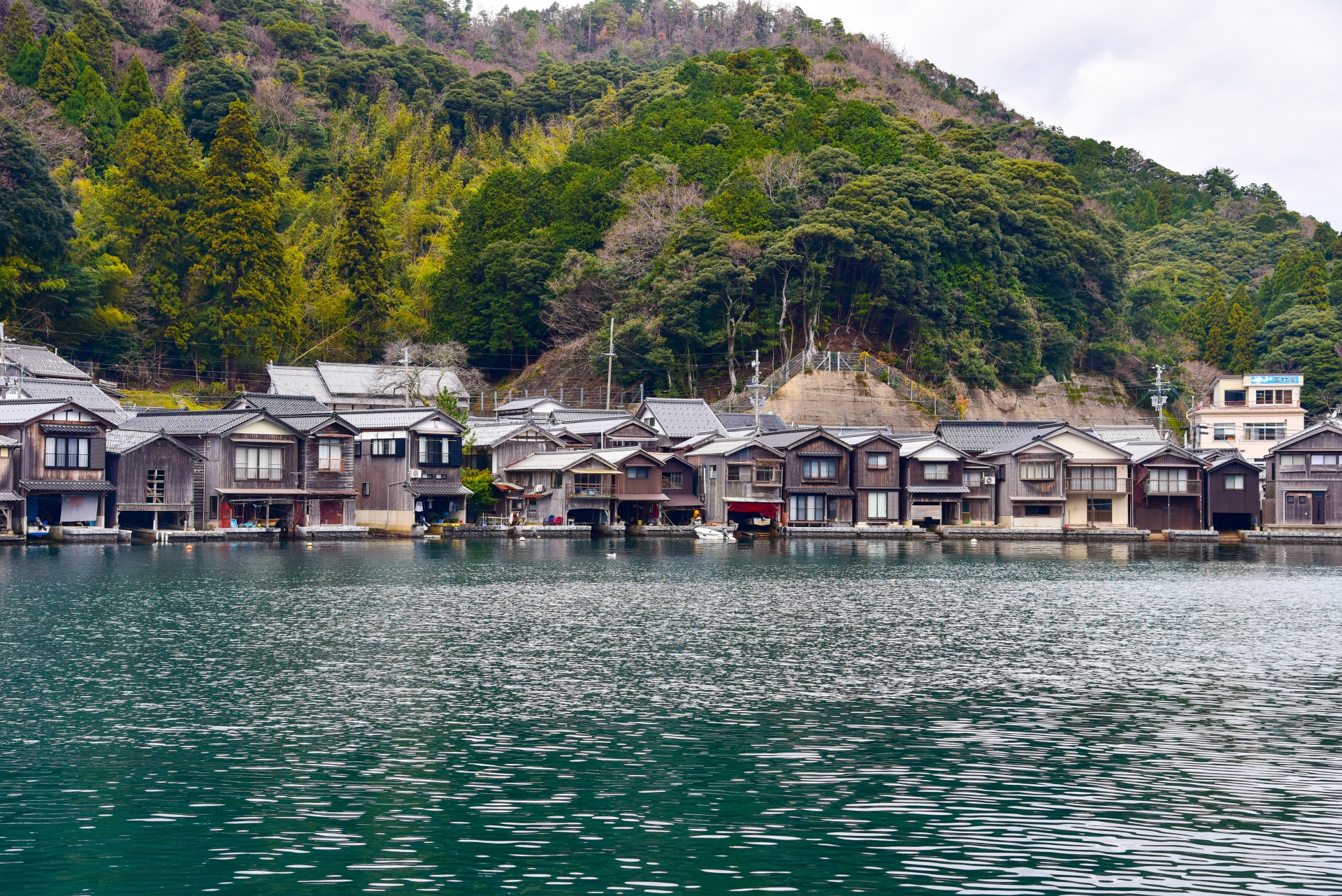
- Popular destinations
- Hidden places in Japan
- Tours and workshop
- Food and drink in Japan
- Itinerary in Japan
- Places to visit in Tokyo
- Food and drink in Tokyo
- Seasonal events
- Tours & workshops
- Tokyo This Week
- Day trip from Tokyo
- Itinerary in Tokyo
- Places to visit in Kyoto
- Food and drink in Kyoto
- Itinerary in Kyoto
- Day trip from Kyoto
- Travel tips
- Accommodation
- Cultural tips
- Transportation
- Tokyo Tours
- Kyoto Tours
- Kimono Rental
- Fukushima Tours
- Mount Fuji Tours
- Tour Package
- Media Kit(English/日本語)

One Week in Kyushu Itinerary: Explore the Best of Northern Kyushu, Japan
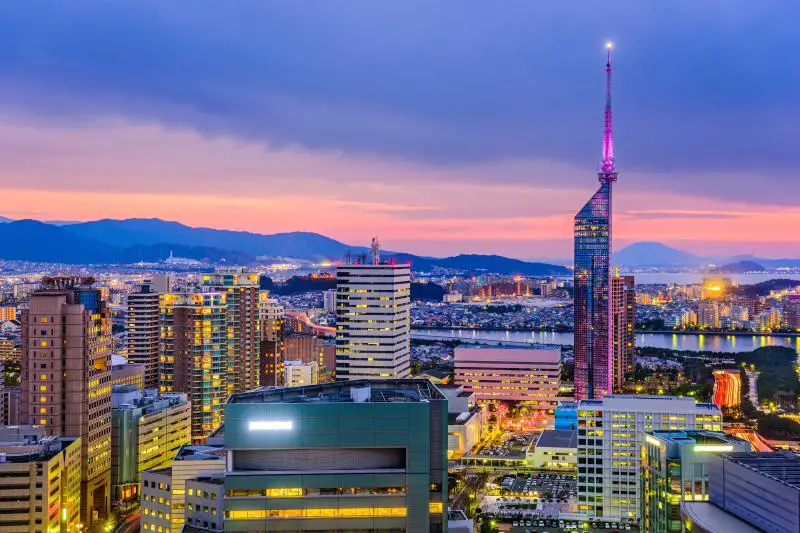
While most people associate Japan with Tokyo , Kyoto , and Osaka , one area that needs to be on your Japan itinerary is Kyushu Island. Kyushu is the third largest island in Japan’s archipelago and is located in the southern area of the country.
Where are the best places to visit in Kyushu? Since the island is HUGE, we suggest that you spend the time in Northern Kyushu, specifically Fukuoka, Beppu, and Nagasaki. These underrated cities will give you an introduction to its beautiful landscapes and mountains, history, and mouthwatering local cuisines. Plus, these areas don’t attract huge crowds like in Tokyo and Kyoto.
We suggest that you spend at least 1 week in Kyushu. This Kyushu 7 days itinerary highlights the cities to visit in Kyushu, transportation options, and recommended places to stay. As with any travel itinerary that we share, feel free to mix up the sightseeing attractions based on your interest and time.
Now let’s visit these Kyushu must-see tourist attractions!
Click on the links below to jump to certain sections of this Kyushu itinerary for 7 days.
- Map of Kyushu
- How to Travel Around Kyushu
- Fukuoka (Days 1-2)
- Beppu (Days 3-4)
- Nagasaki (Days 5-6)
- Free Day or Departure (Day 7)
*Disclaimer: Traveling to Kyushu, Japan? This post contains affiliate links to Kyushu tourist attractions. If you click on them and make a purchase, we receive a small commission. There is no additional cost to you. Appreciate the support.
Map of Kyushu Itinerary for 1 Week
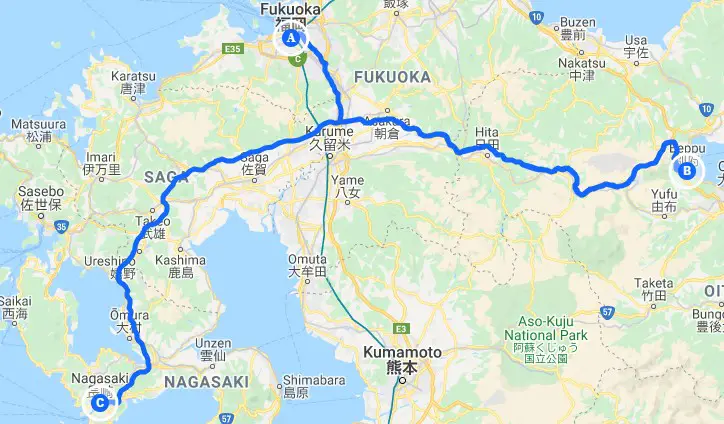
Click on the image above to see a larger version of where you’ll go on your Kyushu itinerary. Credit: Map data: Google
How to Travel Around Kyushu Using JR Pass
The best way to travel around Kyushu and all of Japan is by using the shinkansen high-speed train operated by Japan Rail (JR) Group. The shinkansen is convenient to use since they are fast, always arrive and depart on time, have comfortable seats, and run constantly. They also connect to the local train lines. Using the shinkansen is also a sustainable way to travel since you reduce your carbon footprint for long-distance travel.
All visitors with a temporary visa have the opportunity to use the shinkansen if you have a wide-area Japan Rail (JR) Pass , JR Sanyo-Sanin – Northern Kyushu Pass , or JR Kyushu Pass . With the pass, you’re able to travel within a large area (basically all of Japan), take JR local and fast-speed train lines. You won’t be able to take the Nozomi and Mizuho fast line but the Sakura and Hikari still are quite fast with a few extra stops along the way.
You would need to calculate if it’s more cost-efficient to have a wide-area JR Pass, Sanyo-Sanin – Northern Kyushu Pass, or Kyushu Pass. Once you have your Kyushu itinerary ready, you can use this scheduler to determine the cost and the departure/arrival times of the shinkansen.
The wide-area JR Pass is beneficial if you plan to visit different areas of Japan. They have a 7, 14, and 21-day pass. Buy your JR pass for a discounted price here .
The Sanyo-Sanin – Northern Kyushu Pass is for the Kyushu area and also travels to/from the Osaka area. This pass lasts 7 days. Buy your pass here for a discounted price.
JR Kyushu Pass is available but has duration of 3 or 5 days. This pass is good if you fly to Kyushu and don’t plan to travel outside of the island. Buy your JR Kyushu Pass here .
You’ll need to purchase the JR pass in advance and exchange the voucher for the physical ticket at the shinkansen ticket office on your arrival. It’s recommended that you also reserve seats in advance so you don’t need to worry about not getting one in the non-reserved seating car. You can reserve seats in person at the ticket office.
This post will focus on using the shinkansen between the cities since that was our main mode of transportation.
Kyushu Itinerary Day 1-2: Fukuoka
Fukuoka ( 福岡市) is the main city in Fukuoka Prefecture. As the northern city in Kyushu, it’s the perfect introduction to this island. With a mix of traditional and metropolitan architecture and culture, you’ll love spending a few days in Fukuoka (also referred to as Hakata in the Hakata area). If you are a huge ramen eater, you’ll love eating your way through this city.
Read our detailed Fukuoka itinerary here.
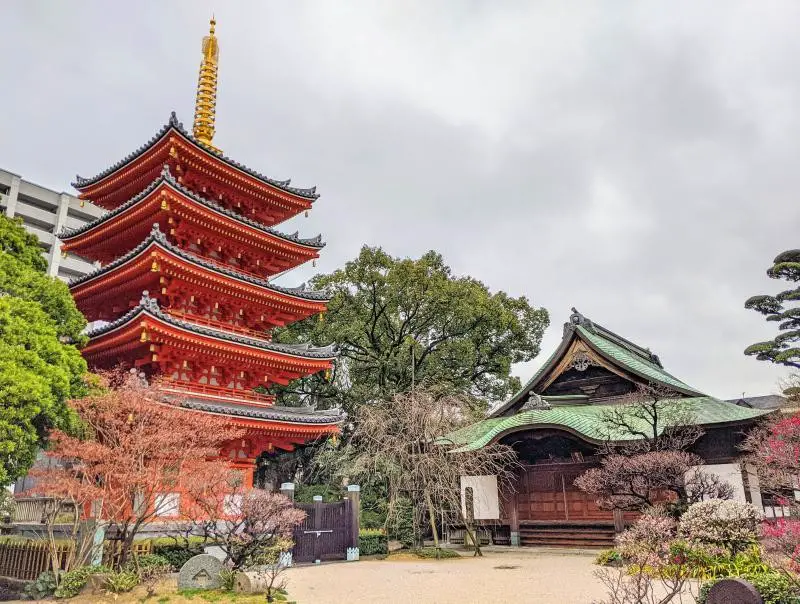
Tochoji Temple is a recommended place to visit in Fukuoka.
How to Get to Fukuoka
Fukuoka has an international airport and it’s only 6 minutes away to get to the main station, Hakata Station ( 博多駅) by train. From the Fukuokakuku Station ( 福岡空港駅) at the airport, hop onto the local train on the Kuko Line and go two stops to Hakata Station.
By Shinkansen
If you’re coming from Honshu Island where Tokyo, Osaka, and Kyoto are located, you’ll need to take the shinkansen directly to Hakata Station. Travel times will vary depending on your starting location.
Top Things to Do in Fukuoka
- Eat Hakata ramen (also referred to as tonkotsu ramen) when you’re in Fukuoka. Many of your favorite ramen shops originated here such as Ippudo, Ichiran, and Shin-Shin Ramen. You can easily spend the day trying different ramen branches.
- Take a historical walking tour . Visit important temples and shrines such as the Kushida Shrine and Tochoji Temple which is close to Hakata Station.
- Walk along the riverfront and try the Yatai food stalls in the evenings. It’s similar to hawker food stalls in Singapore .
- Go shopping at Canal City , a multi-level shopping center that has boutique and popular stores.
- Check out the old ruins of the Fukuoka Castle .
- See the views of Fukuoka city from Fukuoka Tower .
- Explore Dazaifu on a day trip . It was originally Fukuoka’s former government area so you can see ancient ruins of the buildings and also check out the shrines and temples.
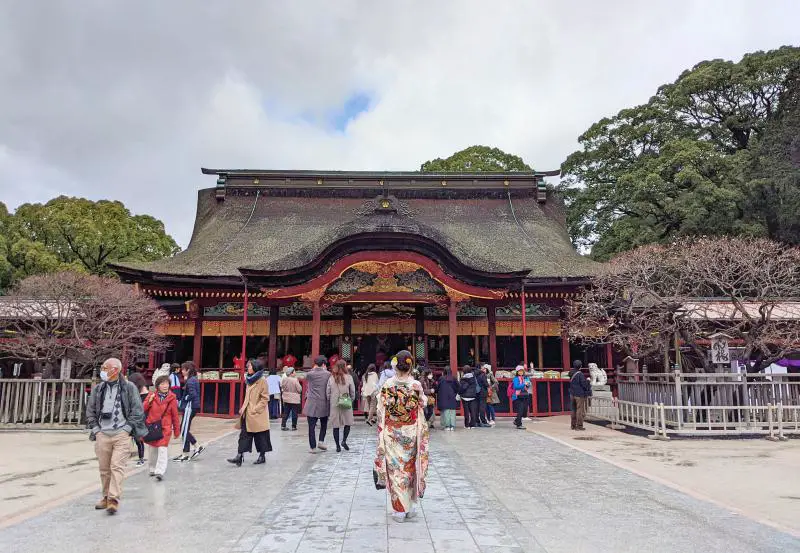
Tenmangu Shrine is one of the best attractions to visit in Dazaifu.
Places to Stay in Fukuoka
We stayed at Hotel Mei which is within walking distance to Canal City. It’s a new hotel that offers various rooms whether you want a suite or an executive room. We had a budget-friendly room that was spacious and had the amenities needed for our stay. Book a room at Hotel Mei here .
For other options, check out accommodation reviews and book a room in Fukuoka here.
Kyushu Itinerary Day 3-4: Beppu
Beppu ( 別府市) is a famous onsen (hot springs) location in Japan. Located in Oita Prefecture, this mountainous city is unique to visit as you see steam coming from the rooftops of the onsen. You’ll love the opportunity to relax in a hot spring and also get a chance to see the multi-colored bubbly hot springs up close. Two days is a good amount of time to relax in the middle of your Japan itinerary.
Click to read more about our Beppu itinerary here.
How to get to beppu from fukuoka.
Take the shinkansen high-speed train from Fukuoka’s Hakata Station ( 博多駅) to Beppu Station ( 別府駅). It’ll take 2 hours.
Top Things to Do in Beppu
- Relax at an onsen . You can choose to stay overnight at an onsen or spend time in one with mineral spring water, mud bath, or in the sand.
- The main highlight of Beppu is to visit the Seven Hells of Beppu . Take the Jigoku Meguri (Hells Tour) to visit the seven hot springs – Chinoike, Tatsumaki, Shiraike, Oniyama, Kamado, Umi, and Oniishi Bozu. You’ll love the different colors from cobalt to mud pits for the hot springs. There are 8 Jigoku in the area but one isn’t a part of the Jigoku Meguri ticket combination. This attraction will take about half a day.
Read our Seven Hells of Beppu guide here.

Out of the Seven Hells of Beppu, Umi Jigoku is our favorite!
- Eat Beppu specialties such as steamed foods, steamed custard pudding and eggs, and toriten (tempura battered chicken).
- Take a day trip to Yufuin, one of the best onsen towns in Japan . Although it’s a smaller town, you can’t miss the relaxation opportunities and go hiking up Mount Yufu.
- Visit Harmonyland , an outdoor Sanrio amusement park. See Hello Kitty and friends here or visit them in Tokyo’s Sanrio Puroland .
Places to Stay in Beppu
We stayed at Beppu Hostel U&T which was an affordable option and close to the Beppu Station. The rooms are larger than other places that we stayed at. Plus, this place has unlimited tea and beverage services! Book a room at Beppu Hostel U&T here.
For other options, click here to read reviews of Beppu accommodations and make a reservation .
Kyushu Itinerary Day 5-6: Nagasaki
Nagasaki ( 長崎) is a location that has both Japanese and Western influences. As the largest city in the Nagasaki Prefecture and former port city, you’ll see influences with the Portuguese and Dutch with the architecture and Christianity. It’s also known as the second location to experience the atomic bomb on August 9, 1945 (3 days after the Hiroshima incident). Since Nagasaki is a large area with lots of local attractions, you can easily spend 2-3 days here.
Read more about our Nagasaki itinerary here.
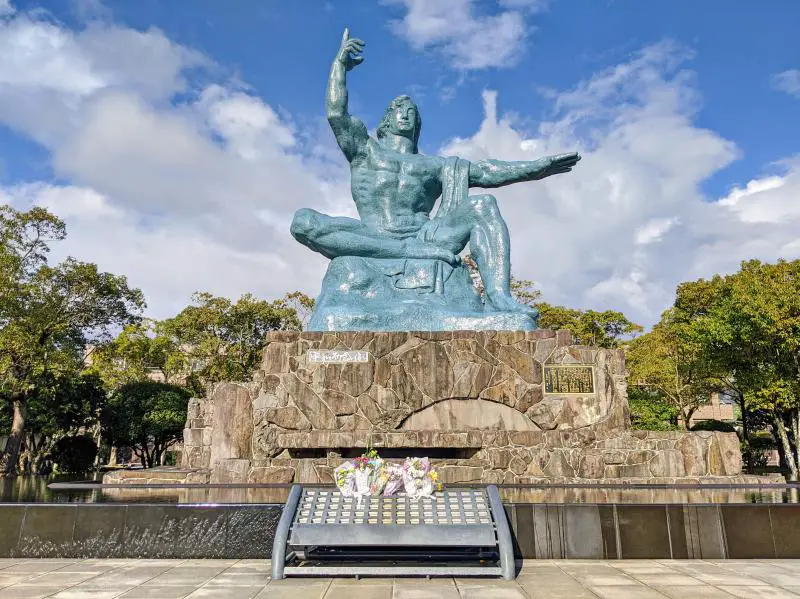
The Peace Statue at the Peace Park is a lovely place to visit in Nagasaki.
How to Get to Nagasaki from Beppu
To get to Nagasaki from Beppu, you’ll need to allocate 4 hours and do one transfer on the shinkansen fast-speed train. From Beppu Station ( 別府駅) to Fukuoka’s Hakata Station ( 博多駅) , the shinkansen ride will take 2 hours. Afterward, transfer at Hakata Station to go on a different train that goes to Nagasaki Station (長崎駅) . This will take another 2 hours. It’s a long journey so it’s recommended that you purchase a meal or snacks ahead of time for your ride.
Top Things to Do in Nagasaki
- Learn about the history and events leading up to the atomic bomb incident at the Atomic Bomb Museum and the National Peace Memorial Hall for Atomic Bomb Victims. Pay your respects at the Peace Park and also see the atomic bomb hypocenter at the Hypocenter Park .
- Visit Nagasaki’s churches such as Oura Church and Urakami Cathedral.
- Explore the isolated island for Dutch merchants at Dejima .
- Eat champon , a noodle specialty dish from Nagasaki. It’s one of our favorite Japanese foods to eat!
- Visit Chinatown to shop and eat. If you can visit during the Nagasaki Lantern Festival , you’ll see over 15,000 lanterns light up the area. Nearby Chinatown is also the Spectacles Bridge that looks like a pair of glasses.
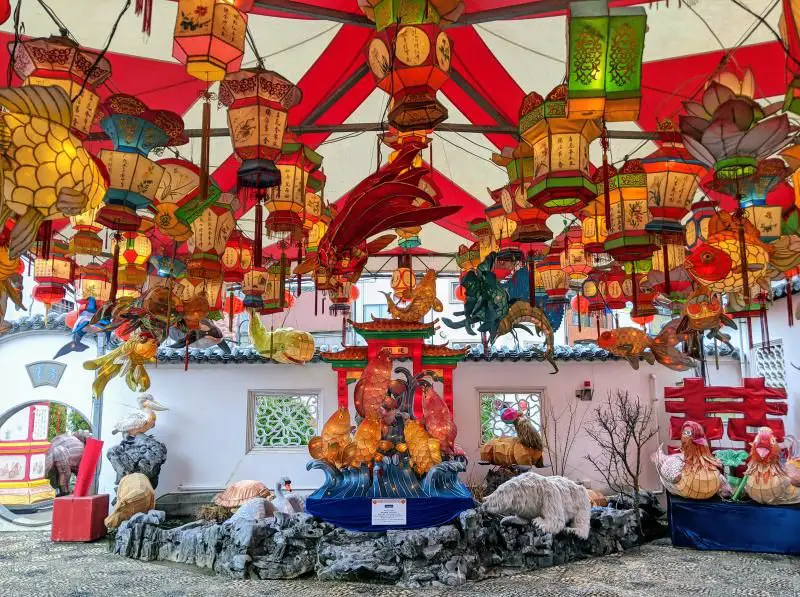
If you have a chance to visit Nagasaki during the Lantern Festival, you’ll see incredible decors and displays.
- Check out the nighttime views from the summit of Mount Inasa at 333 meters (1,093 feet) above sea level. You can take the ropeway to the top of the mountain.
- Take day trips to visit the Huis Ten Bosch , the Netherland-inspired amusement park, or see the abandoned island of Hashima Island (Battleship Island).
Places to Stay in Nagasaki
We stayed at MP Hotel Nagasaki Mizubenomori which is a quiet location in the residential area. This place is great if you’re looking for an apartment-style hotel room. The best part is that this room has a washing machine. Regardless, this place is close to the streetcar so you can travel around the city. Book a room at MP Hotel Nagasaki Mizubenomori here.
For other options, click here to read reviews of Nagasaki accommodations and make a reservation .
Kyushu Itinerary Day 7: Travel Day or Departure
On your last day in Kyushu, this is your free day to do whatever you’d like! Depending on your schedule you can visit neighboring areas in Kyushu, head to the neighboring Honshu Island, or depart back home via plane at Nagasaki or Fukuoka airport.
If you have extra time to explore Kyushu, take a day trip to Kumamoto ( 熊本市). The city is known for the Kumamoto Castle ( 熊本城) so you’ll get an opportunity to explore a historic landmark.
How to Get to Kumamoto from Nagasaki
From Nagasaki to Kumamoto, take the shinkansen for a two-hour ride. From Nagasaki Station ( 長崎駅) , head to Shin-Tosu Station ( 新鳥栖駅) . The ride takes 1.5 hours. Transfer here and take the shinkansen to Kumamoto Station ( 熊本駅) for another 25 minutes.
How to Get to Honshu Island from Nagasaki
If you are planning to head to Honshu Island, you’re in luck as there are many places to explore. Honshu Island is the largest island out of Japan’s archipelago. It has popular cities such as Hiroshima, Kyoto, Osaka, Tokyo, and other exciting places.
The nearest main city that is closest to Fukuoka is Hiroshima. We recommend that you stop by Hiroshima for two days to learn more about the Hiroshima atomic bomb , visit the Hiroshima Castle , and do a day trip to Miyajima Island .
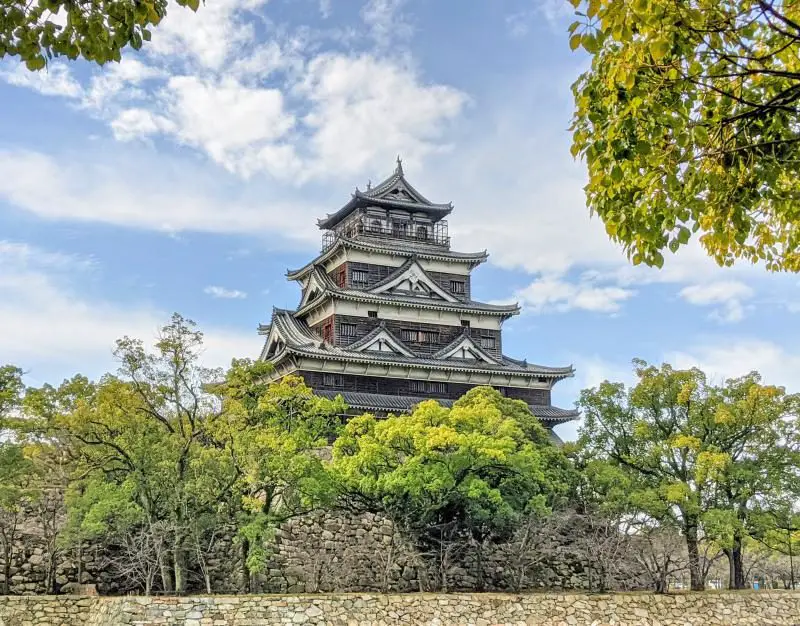
Although Hiroshima Castle is rebuilt, it’s still gorgeous to see!
How to Get to Hiroshima from Nagasaki
From Nagasaki to Hiroshima, take the shinkansen for a 3.5-hour ride. From Nagasaki Station ( 長崎駅) , head to Shin-Tosu Station ( 新鳥栖駅) . The ride takes 1.5 hours. Transfer here and take the shinkansen to Hiroshima Station ( 広島駅 ) for another 1 hour and 20 minutes.
Have a safe departure!
This one week in Kyushu went by quickly! This island has so many hidden gems to explore. We hope you enjoyed Kyushu as much as we did so you can return to visit Southern Kyushu in the future.
What are you most interested in seeing in Northern Kyushu? If you have questions about this Kyushu travel guide or itinerary, ask one in the comments below.
Save this post to your Japan Pinterest board.
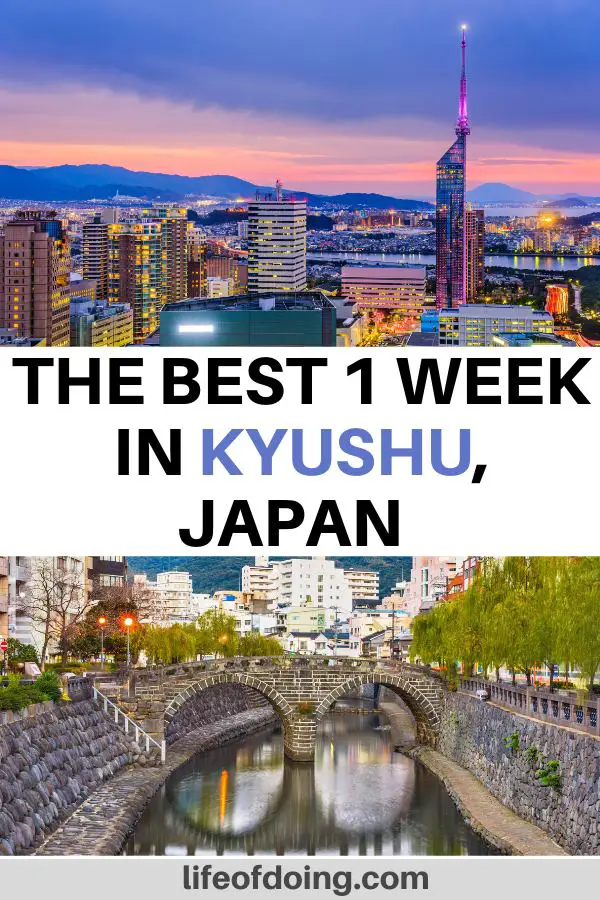
Featured photo & pin #1 photo credit: sepavone via Depositphotos.com
I'm Jackie - world explorer, hiker, and wanderer. I love planning things whether it is a trip or an upcoming event, exploring nature, hiking up mountains, and seeing new places. I'm notorious for getting lost, so you may see me circling a place a few times.
One Day in Fukuoka, Japan: A Fukuoka Itinerary That Is Great for Ramen Lovers
Himeji day trip: a fabulous one day from osaka or kyoto, japan, you may also like, the ultimate guide to 24 non-spicy korean food..., how to travel from ipoh to penang georgetown..., 18 must try places to eat in penang’s..., a step by step guide on taking the..., exploring melaka, malaysia in one day – a..., hiking moongate station 5 in penang, malaysia, indonesia’s top 5 scuba diving spots to not..., 11 must have apps for traveling in malaysia, where to go in bali: the best 8..., 16 things to know before visiting ipoh, malaysia, 15 comments.
This looks like such an amazing place. Unfortunately, when we were in Japan we didn’t have enough time to go to Nagasaki. We do hope to go back to visit places like this instead of all the big cities! Saving for later.
Thanks Pamela. There is so much to see in Japan! Once the current situation is over, hope you can make a plan to return to Japan. We would love to go back to Kyushu and spend time in the southern areas to see waterfalls and more beautiful landscapes.
Interesting places in Kyushu and we already know that Japan has many amazing places where we can spend our time. I love this place and will plan to go there.
Thank you! Kyushu Island is underrated since it takes a while to get there from Osaka and has fewer crowds. Look forward to hearing about your experiences when you visit.
I’ve always wanted to go to Japan!! What an amazing guide you’ve created. There’s so much to do and see especially in the Kyushu area. I’ll save this for my trip!
Thanks Katie! If you have any questions during your future Japan planning, I’m happy to help!
This is a great guide you’ve created for Japan. I’ve been to some Asian countries like India and I’m always excited to explore more countries there!
Thanks Olga! Glad you enjoyed this Kyushu itinerary! I’m overdue for a return trip to India. I’ve only been to Bangalore for work so I can’t wait to explore other tourist attractions.
I am truly blown away by everything Japan has to offer. We returned from our trip to Japan in February and I never thought to visit Kyushu – thank you for taking the time to write this. I feel like one could spend years in Japan and still not see it all!
Hi Sarah. We returned from our trip to Japan in February as well! Where did you go? Hope you get a chance to visit Kyushu in the future.
Just by your photos I already want to go Kyushu area! Great post!!
We visited Tokyo, Hakone, Kyoto, Osaka and Nara! So much we still need to see!
Hi Sarah – I agree! There is never enough time to explore all of Japan. Justin and I haven’t been Hakone yet, but it’s on the bucket list.
I’m late to this post but am planning a trip to Kyushu later this year for my first visit to Japan. Thanks for the insight, can’t wait to see what the island has to offer.
Hi JJ. Thank you for sharing a comment. Enjoy your time in Kyushu! Would love to hear back from you on your experience. We can’t wait to go back and explore more on Kyushu island.
Leave a Comment Cancel Reply
Save my name, email, and website in this browser for the next time I comment.
By submitting a comment, you agree with the storage and handling of your data by this website. Refer to the Privacy Policy and Disclaimer for more information. *
This site uses Akismet to reduce spam. Learn how your comment data is processed .
This website uses cookies to improve your experience. Please accept or opt-out if you wish. Accept Read More
Visit Kyushu The Official Kyushu Travel Guide
- Activities & Experiences
- Art & Culture
- Heritage & History
- Wellness & Relaxation
- Food & Drink
- Nature & Outdoors
- Art & Culture
- Heritage & History
- Nature & Outdoors
- Leisure & Entertainment
- About Kyushu
- Adventure Travel
- Book Kyushu Experiences
- Getting to Kyushu
- Getting around Kyushu
- Good to Know
- Staying in Kyushu
- Downloadable Pamphlets
ABOUT KYUSHU TOURISM ORGANIZATION
The tourism industry provides the intrepid traveler with a challenging atmosphere while working to ensure one's comfort. Additionally, the tourism industry influences a wide range of economic areas. In many regions it creates new industries and jobs by increasing the exchange population, thus ensuring the vitality of those regions. In this respect there is great hope that tourism will have high potential for development in Kyushu, with its wealth of tourist attractions. From another viewpoint, it is hoped that Kyushu–being historically and geographically close to East Asia, which is developing as the new core of a global economy–will serve as a gateway to Asia. In each region of Kyushu the community residents, private organizations, local government and others have been engaged in regional construction projects and activities related to tourist sites. However, looking at the trend in tourism over the past few years, compared with the upward trend in the number of tourists visiting Hokkaido and Okinawa, the number of tourists visiting Kyushu areas has decreased. It is therefore important for all of Kyushu to combine forces for the restoration of Kyushu tourism by intensively working out strategies. We must not miss the opportunity, particularly when infrastructure for tourism, such as the Kyushu Shinkansen and Kyushu National Museum, has been provided. Under these circumstances the local governments and private sectors in Kyushu have jointly established the Kyushu Area Strategy Conference in October 2003 (Chairman Wataru Aso, also Chairman of the Governor's Association of Kyushu Region; Vice Chairman Michisada Kamata, also Chairman of the Kyushu-Yamaguchi Economic Federation) under the spirit of "Kyushu as One," having as its goal regional self-reliance and Kyushu-wide economic development. The Conference has resolved to formulate a Kyushu tourism strategy as a part of its activities. Accordingly, the Kyushu Tourism Strategy Committee (Chairman Kouji Tanaka, also the then Chairman of JR Kyushu) was established in January 2004 as a means to identify which strategy was to be followed by all of Kyushu for the enhancement of tourism. The Committee also devised the "Kyushu Tourism Strategy" in October of that year. Furthermore, the Kyushu Tourism Organization was established with the understanding and support of all quarters and all levels of the community with a view toward the practical implementation of the strategy. This included preparations for receiving tourists as we realize the theme of "Kyushu, Tourist Kingdom," and activities to attract tourists targeting domestic and international major markets such as domestic metropolitan areas and countries of East Asia. Currently, our promotion activities have expanded to include South-East Asia, the United States, Australia, and Europe.
ABOUT OUR LOGO
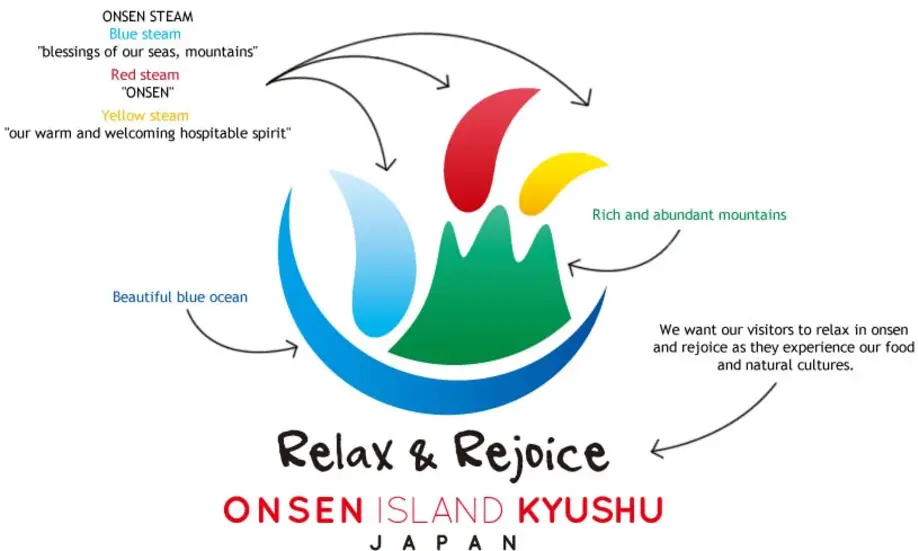
In attempt to promote Kyushu's unique attractions to the rest of the world, we have created a logo and an advertising slogan. We began this process in 2014 starting with Kyushu's onsens, and then to food, nature, and hospitality. The logo represents "ONSEN." The crescent at the bottom represents our "beautiful blue ocean." The mountain above it represents the "rich and abundant mountains." The steam goes up above it representing the blessings of our seas, mountains, and our warm and welcoming hospitable spirit. The advertising slogan - Relax & Rejoice ONSEN ISLAND KYUSHU - represents our desire for all visitors to have an enjoyable and relaxing time here in Kyushu as they experience our onsen, food, nature and many more.

IMAGES
VIDEO
COMMENTS
Kyushu is a land full of energy, from its vibrant people to its famous volcanoes. Close to the rest of Asia and easily accessible from Tokyo, Kyushu has welcomed new ideas and cultures for over a thousand years. Experience the dynamic landscapes, relax in the many hot springs, and enjoy the warmth of genuine hospitality.
Easily reached by land, sea and air, dynamic Kyushu is bubbling with energy, culture and activity. Japan's third-largest island is internationally famous for its tonkotsu ramen, varied hot springs, dramatic mountains, and peaceful beaches. While the startup hub of Fukuoka bubbles with international attention, the volcanic terrain to the south ...
Land of volcanoes, ancient religious sites and a galaxy of regional cuisines. Kyushu (九州, Kyūshū, literally "nine provinces") is Japan's third largest island, located southwest of the main island Honshu. An early center of Japanese civilization, Kyushu offers many historic treasures, modern cities and natural beauty.
Nagasaki is one of the best places to visit in Kyushu—and not just because of World War II-era tourism sites, even if I find the area around Nagasaki Ground Zero to be very moving indeed. From the picturesque Oura Cathedral and Glover Garden in the southern part of the city, to the stunning panorama Mt. Inasa offers, Nagasaki is one of the most beautiful and eclectic cities in all of Japan ...
Kyūshū. Kyūshū (九州), Japan's southern- and westernmost main island, is arguably its warmest and most beautiful, with active volcanic peaks, rocky, lush and near-tropical coastlines, and great onsen (hot springs) virtually everywhere. History and legend were made here: Jōmon ruins, Shintō's sun goddess, wealthy trading ports ...
Day 12 and 13 - Beppu. Head to Beppu and visit the town's hot springs. Stay in Beppu and return to Fukuoka via Kitakyushu the next day. The above itinerary is somewhat fast-paced. Tourists preferring a slow pace of travel should consider spending more time at some of the destinations along the way. Questions? Ask in our forum. Suggested travel ...
per adult (price varies by group size) Mt. Fuji Cherry Blossom & Shibasakura Festival Private Day Tour. 61. Bus Tours. from. $430. per group (up to 2) Day trip from central Fukuoka.Rental cycle in Shikanoshima island. 19.
Located along the west coast of Kyushu island, Nagasaki has some beautiful coastal views. Battleship Island in particular is known for its mysterious atmosphere. A coal mine that was abandoned in the 1970s, this island is now a top tourist attraction, with several sightseeing tours available!
Mount Karakuni is the highest peak in the Kirishima Mountain Range of Kyushu Island in Japan with a height of 1,700 meters. Mount Karakuni has a volcanic crater, which is 900 meters and 300 meters deep. The hike up from the visitor center is relatively short with just a few kilometers in distance but quite steep.
Kawauchi Fujien is a large park in Kitakyushu famous for its beautiful wisterias from late April to early May. Other tourist attractions in Fukuoka Prefecture include Munakta Taisha, Kyushu National Museum, Ohori Park, Fukuoka Castle, Maizuru Park, and Sumioshi-jinja Shrine. Read more about Fukuoka.
Kyushu. Explore attractions in each region of Japan, from traditional cultural experiences to Japanese cooking lessons and outdoor activities. Presented by the Japan National Tourism Organization (JNTO). ... Visit Mt. Fuji, Shirakawa-go, and other World Heritage sites, and savor a food culture derived from the mountains and the sea Visit Mt ...
Here are some important things to note before we get started: I've combined two of my personal itineraries to create this 7-10 day Kyushu travel guide.; For Days 1-4, I recommend using public transport such as the trains and express airport bus.; From Day 5 onwards, a rental car is the best option to reach more remote areas.; I also recommend using Kumamoto as a base, due to its central ...
When to visit Kyushu. For many, the best time of year to visit Kyushu will be springtime, when the cherry blossom trees are in full bloom and the weather is pleasantly warm. Autumn comes with a host of autumnal festivals throughout the season. You can enjoy autumnal foliage from late October to mid-November.
Plan Your Trip to Kyushu: Best of Kyushu Tourism. Essential Kyushu. Stay. A mix of the charming, modern, and tried and true. See all. 2023. Hotel Okura Fukuoka. 1,108. from $133/night. 2023. Hotel JAL City Fukuoka Tenjin. 240. Amane Resort Seikai. 398. from $321/night. Richmond Hotel Nagasaki Shianbashi. 861. from $74/night. Yamashiroya. 281.
There is a Tourist Information Center at each of Kyushu's regional airports, at major train stations and some sightseeing spots. Many have multi-lingual staff and services like luggage storage and printing. Larger centers such as Acros and Canal Tourist Lounge in Fukuoka, offer cultural experiences, from craft to wearing kimono.
Day 1: Fukuoka. Kyushu's largest and most vibrant city is Fukuoka ( 福岡 ), a great place to start your trip. The old castle town is located along Hakata Bay, which made it a favorable base for international trade. The city was first known as Hakata, but was renamed Fukuoka in the 17th century.
This Kyushu 7 days itinerary highlights the cities to visit in Kyushu, transportation options, and recommended places to stay. As with any travel itinerary that we share, feel free to mix up the sightseeing attractions based on your interest and time. Now let's visit these Kyushu must-see tourist attractions!
Visit Kyushu The Official Kyushu Travel Guide. TRAVEL BLOGS. Activities & Experiences; Art & Culture; Heritage & History; Wellness & Relaxation
ABOUT KYUSHU TOURISM ORGANIZATION. The tourism industry provides the intrepid traveler with a challenging atmosphere while working to ensure one's comfort. Additionally, the tourism industry influences a wide range of economic areas. In many regions it creates new industries and jobs by increasing the exchange population, thus ensuring the ...